Ride along with me...
#181
The morning of the May 13 we started looking around Remoulins. Sandra was curious about these *****…

Remoulins *****. Possibly better looking than bollards, but I’d think a danger of tripping over them would be everpresent.
...and with good reason. No, they don’t move! Fortunately we found a way around this roadblock too:

Roadblock. At times you find someone ready to slow your progress!
My aim for the day was to get to Monaco’s Historic Grand Prix before the day was out, but first I had to go and look at the Pont du Gard. So our overall path for the day didn’t take us very far:

First, however, we decided to chase up breakfast from a market near Remoulins. It was a rambling sort of market with all sorts of things and we left there with food in our stomachs. And we headed for Pont du Gard.
I had been here in 1981 and I had fond memories of driving over the old bridge with the aquaduct towering over it, a Roman structure dating back to the first century. It was here that I had my photo taken with the Peugeot 204 I bought to drive around on that trip, and it was parked next to a Peugeot 203 at the time…
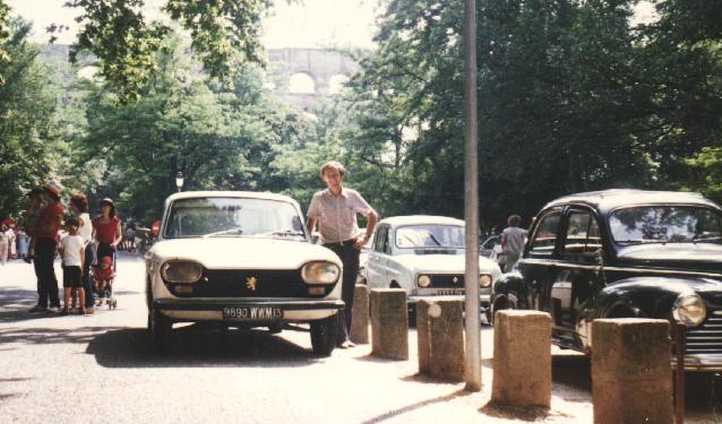
Memory of 1981. Standing alongside my 204 with a 203 parked nearby, this was 35 years earlier.
…so this time I wanted a picture of me with ‘my’ 208 with the same view of Pont du Gard in the background. Disappointment awaited me!
The whole place has changed, perhaps because of a flood in 2002, perhaps because it was all too good for the visiting public and so they needed to make it less attractive. So the photo had to have a picture of the Pont in the background instead!
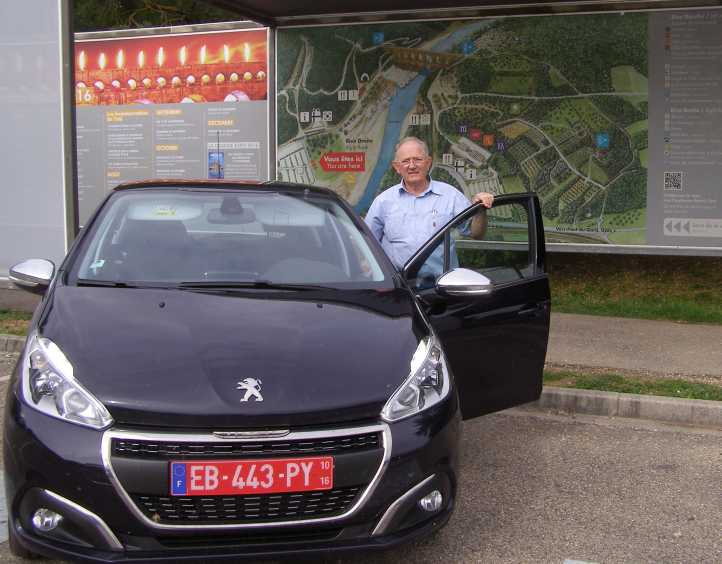
2016 version. Deprived of my chance to get an equivalent picture, this had to suffice.
Meanwhile, a short distance away by walking path the Pont is to be viewed:
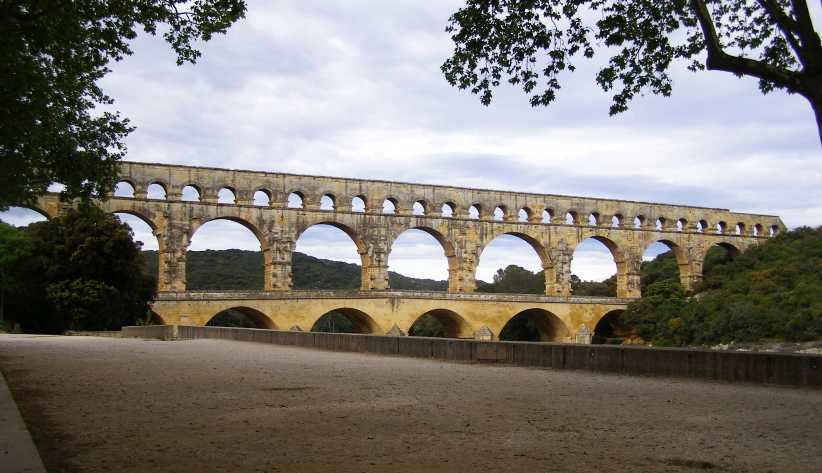
Pont du Gard. Worthwhile visiting even if you can’t drive across it any more – but you can on Google Earth street view! - this stands as a monument to Roman engineering. The lower level bridge was an addition only a few hundred years ago.
This structure is about 150’ from the riverbed to the top and is the highest aquaduct built by the Romans. Its purpose was to supply water from springs in the mountains to Nimes with the overall canal carrying the water being about 19 miles long. It did the job for about 500 years.
There are ancient caves in the area too, but they’re not something you can visit…
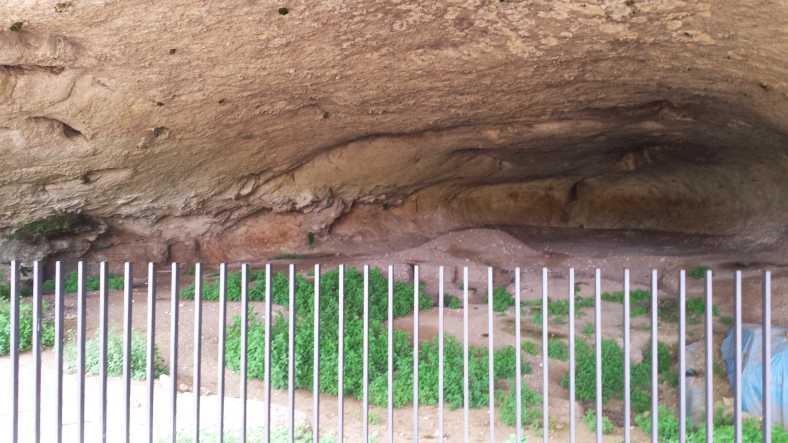
Ancient cave. Not much to see here, but apparently it’s worthy of note.
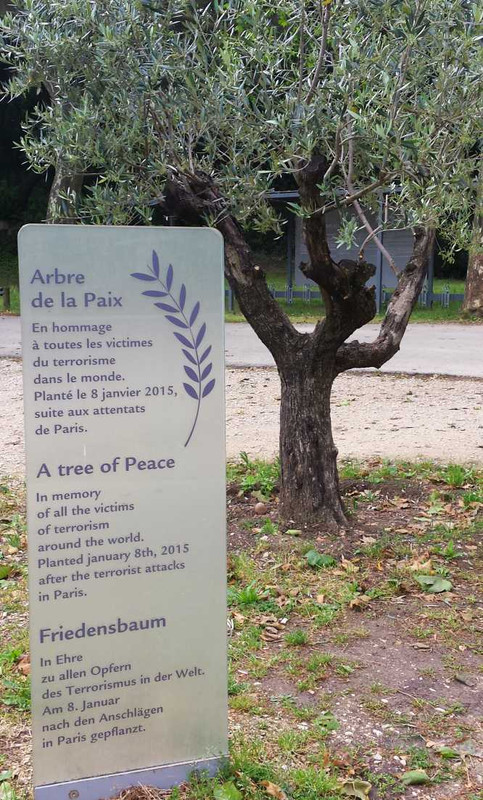
Remembrance tree. The inscription tells the story with this one.

More good roads. The busy Riviera provided us with roads which kept us moving between locations. This Jaguar stood out among the hatchbacks and vans.
…so we pressed on to our main destination. We stuck to freeways (or were they toll roads?) and ultimately reached Monaco in the early afternoon. Sandra took photos of some of the architecture…
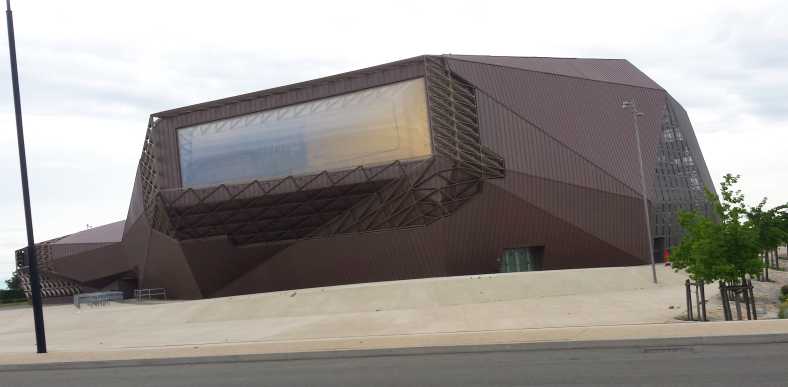
Brutal architecture. Apparently that’s what they’ve named this style of building.
…and the botanical garden, which has a lot of cacti in it…
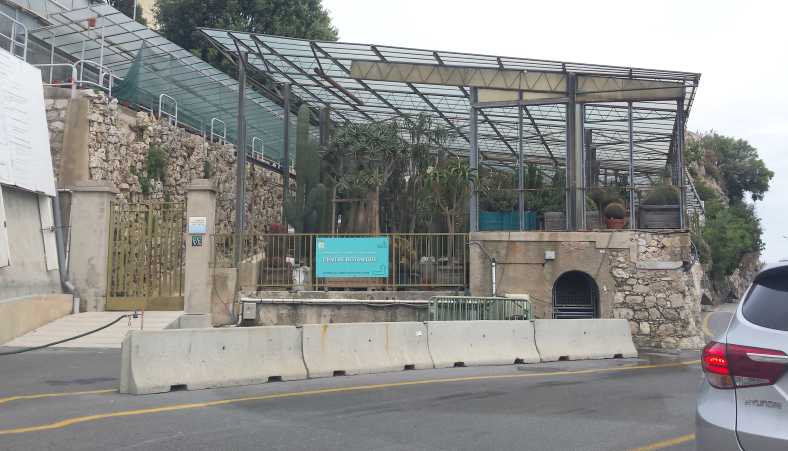
Botanical garden. With the limited space at Monaco, I suppose it’s only fair that their botanical garden be small.
…and this tall building, Le Simona, which is undoubtedly horrendously expensive to buy into if you want to live there.

Le Simona. Investment in buildings such as this is seemingly well-repaid. This is, after all, one of the ultimate playgrounds of the rich and famous.
With all that high-rise and with Monaco being built between cliffs and the water, and under the cliffs and on the clifftops, there was plenty of traffic to contend with.
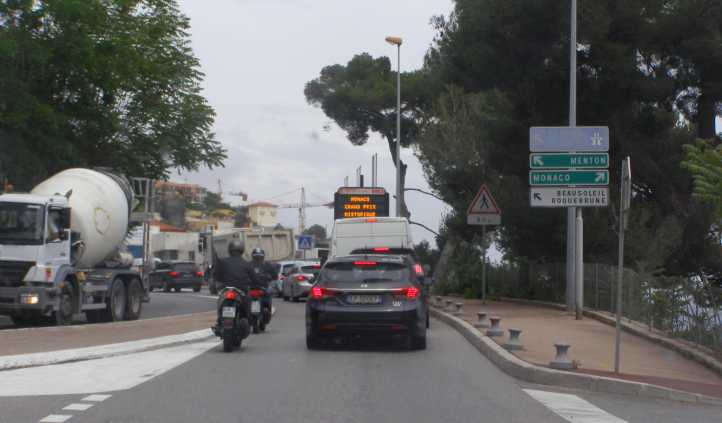
Traffic jam. With the sign announcing that the ‘Grand Prix Historique’ is on, it’s only natural that there’d be a traffic jam.
Then, once we’d found our way in we had to find all the rest of what we needed. Ticket sales, programmes, the ways in and out, we did a lot of walking. As we did so Sandra got pics of the ‘rich and famous’ playground and its harbour…
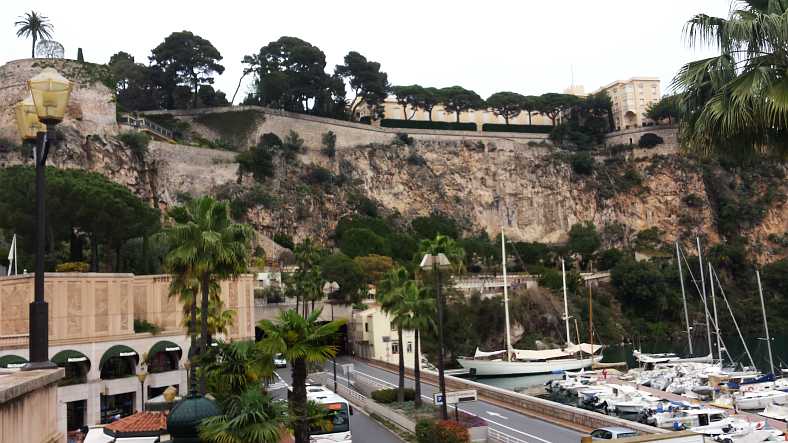
Tunnels and cliffs. Investment in infrastructure is enormous too, tunnels abound and somewhere inside all those rocks there’s a railway station too.
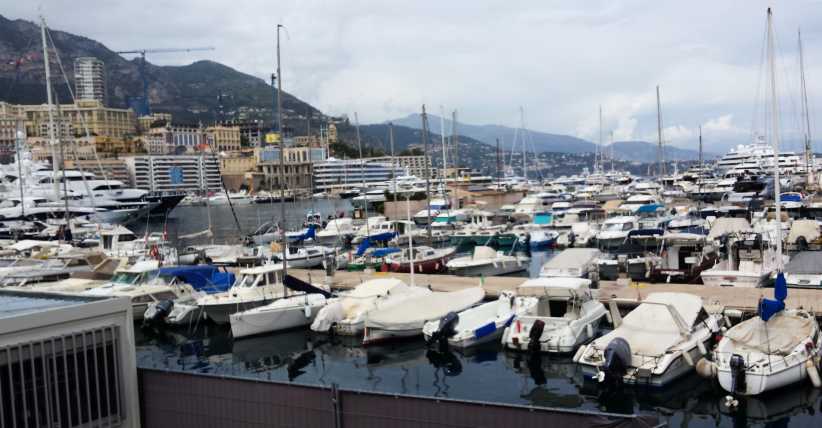
Boats. Of course, who could be rich and famous and not have access to some kind of sailing boat, yacht or other craft?
…and the bit of circuit where we were going to watch it all from, along with the huge screen showing other parts of the circuit, all of this being set up for the ‘real’ Monaco Grand Prix to be held two weeks later…
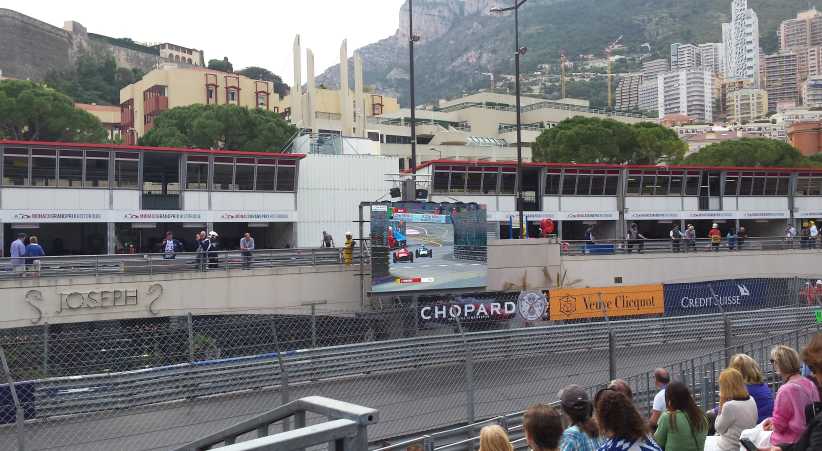
Circuit and screen. We couldn’t see much of the track in front of us, but the screen showed us the other parts as the cameras followed the cars.
…and more of the boats…
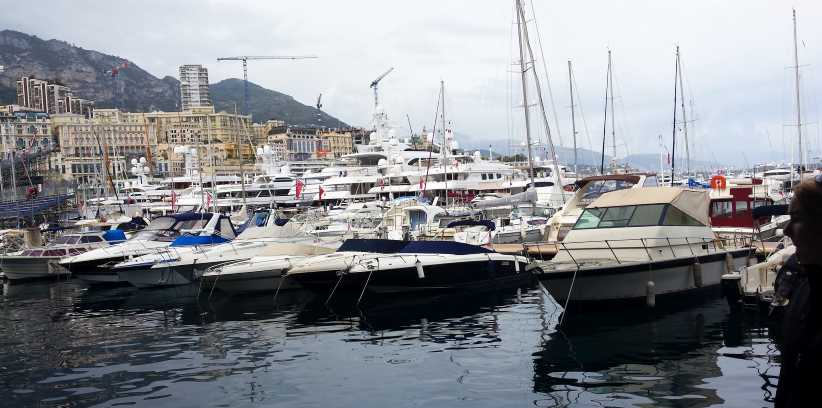 [/url]
[/url]
More boats. Yes, there’s plenty of them there, many of them very expensive too.
…and some of the parading cars that got around between practice sessions…
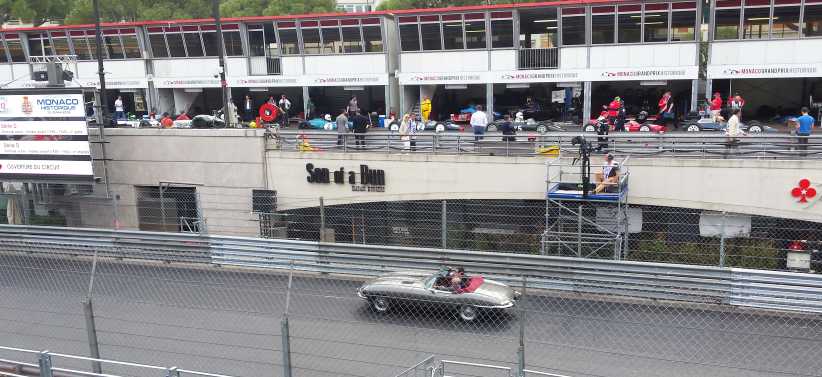
Parading.This E-type was just one of the cars which paraded before us between sessions.
There was action taking place up there in the racing pits, the cars going out to practice were the 1.5-litre Formula 1 cars of the 1961 to 1965 formula. These were cars I’d always desired to see, the cars that the World Champions drove when I first got interested in motor racing. We could see them driving out of the pits to head for the circuit off on the other side, while the screen could show them from any point where there was a camera:
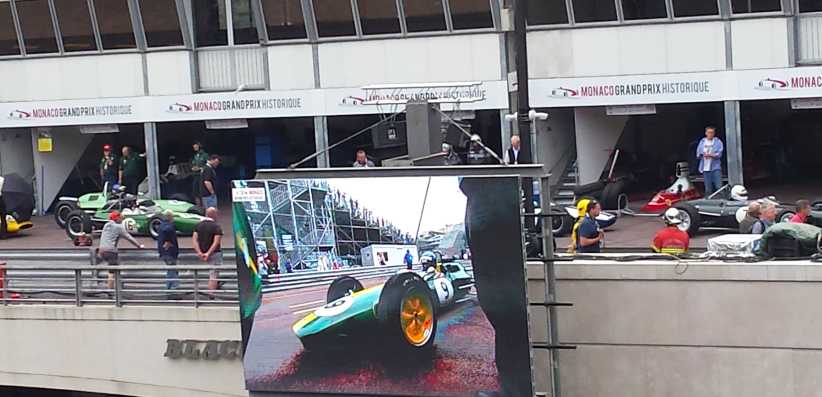
Screen and view. We could see the 1.5-litre F1 cars getting ready to come out while the screen showed them as they made it onto the track.

Not so good. This was no doubt an expensive afternoon for the car’s owner. I don’t know what it was, either.
And here’s where the next disappointment came in. as I wanted to photograph some of these cars. But my Olympus camera has auto-focus and it’s a day’s work to alter it to some fixed focus, so it was all up to the camera to tell you whether you’d get a decent picture or not.
The car that really did catch my attention was the little Ferrari 512. This was driven in 1965 by Lorenzo Bandini (who was to crash here at Monaco the following year and die three weeks later from his burns) and sports a flat 12 engine. What a little jewel that engine would be!
But the fence caught the auto-focus and the car’s nicely blurred:
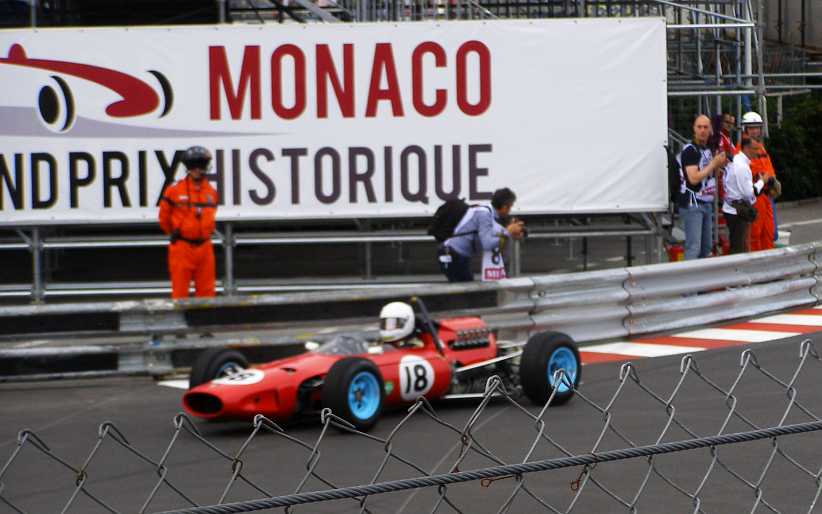
Poor focus. Auto-focus will spoil things every time. This Ferrari would be a real jewel internally with a 1.5-litre 12-cylinder engine.
Not quite so bad is this shot of the very first Formula 1 Brabham. This car made its debut at the Nurburgring in the 1962 German Grand Prix and is powered by a Coventry Climax FWMV V8 engine…

Jack’s Brabham. The very first Formula 1 Brabham leads a Lotus and a Lola.
…Following it in this picture is an Australian driver, Scotty Taylor, who’s enjoying a very long stay in Europe playing with his toy. The car is a Lotus 18, which was built for the 1960 Grand Prix season – in 2.5-litre form - but carried over into 1961 with a 1.5-litre version of the Coventry Climax FPF 4-cylinder engine. I think the next car after it is a Lola as raced by John Surtees in late 1962 with another Coventry Climax V8.
I had been to the Monaco circuit before, in 1981. That year I went to the Grand Prix itself and saw Gilles Villeneuve win in a Ferrari. The place erupted when he took the lead as Alan Jones pitted for more fuel (his car wasn’t picking up the last few gallons) and the Italian portion of the crowd couldn’t contain themselves.
For me, however, the big moment of the race was when Jones pulled 1.2 seconds out of Nelson Piquet’s lead in one lap at around half-distance. Piquet spent the next lap with the Cosworth engine right on the rev-limiter everywhere around the circuit. But only for one lap, then he slid off the circuit approaching the harbour section and Jones was looking the likely winner.
As I enjoyed watching the cars, and hearing them, Sandra’s ears were giving her trouble. It was yet another thing I had to learn about my new wife. She couldn’t handle the shrill screams of these unmuffled little engines turning at 10,000rpm or so. When the session ended we strolled through the area where the cars were kept between their appearances and took lots of photos of them.
Then, after a brief chat with a couple of friends of mine from back home, we went back to the car and headed out to look for somewhere to stay.

Remoulins *****. Possibly better looking than bollards, but I’d think a danger of tripping over them would be everpresent.
...and with good reason. No, they don’t move! Fortunately we found a way around this roadblock too:

Roadblock. At times you find someone ready to slow your progress!
My aim for the day was to get to Monaco’s Historic Grand Prix before the day was out, but first I had to go and look at the Pont du Gard. So our overall path for the day didn’t take us very far:

First, however, we decided to chase up breakfast from a market near Remoulins. It was a rambling sort of market with all sorts of things and we left there with food in our stomachs. And we headed for Pont du Gard.
I had been here in 1981 and I had fond memories of driving over the old bridge with the aquaduct towering over it, a Roman structure dating back to the first century. It was here that I had my photo taken with the Peugeot 204 I bought to drive around on that trip, and it was parked next to a Peugeot 203 at the time…

Memory of 1981. Standing alongside my 204 with a 203 parked nearby, this was 35 years earlier.
…so this time I wanted a picture of me with ‘my’ 208 with the same view of Pont du Gard in the background. Disappointment awaited me!
The whole place has changed, perhaps because of a flood in 2002, perhaps because it was all too good for the visiting public and so they needed to make it less attractive. So the photo had to have a picture of the Pont in the background instead!

2016 version. Deprived of my chance to get an equivalent picture, this had to suffice.
Meanwhile, a short distance away by walking path the Pont is to be viewed:

Pont du Gard. Worthwhile visiting even if you can’t drive across it any more – but you can on Google Earth street view! - this stands as a monument to Roman engineering. The lower level bridge was an addition only a few hundred years ago.
This structure is about 150’ from the riverbed to the top and is the highest aquaduct built by the Romans. Its purpose was to supply water from springs in the mountains to Nimes with the overall canal carrying the water being about 19 miles long. It did the job for about 500 years.
There are ancient caves in the area too, but they’re not something you can visit…

Ancient cave. Not much to see here, but apparently it’s worthy of note.

Remembrance tree. The inscription tells the story with this one.

More good roads. The busy Riviera provided us with roads which kept us moving between locations. This Jaguar stood out among the hatchbacks and vans.
…so we pressed on to our main destination. We stuck to freeways (or were they toll roads?) and ultimately reached Monaco in the early afternoon. Sandra took photos of some of the architecture…

Brutal architecture. Apparently that’s what they’ve named this style of building.
…and the botanical garden, which has a lot of cacti in it…

Botanical garden. With the limited space at Monaco, I suppose it’s only fair that their botanical garden be small.
…and this tall building, Le Simona, which is undoubtedly horrendously expensive to buy into if you want to live there.

Le Simona. Investment in buildings such as this is seemingly well-repaid. This is, after all, one of the ultimate playgrounds of the rich and famous.
With all that high-rise and with Monaco being built between cliffs and the water, and under the cliffs and on the clifftops, there was plenty of traffic to contend with.

Traffic jam. With the sign announcing that the ‘Grand Prix Historique’ is on, it’s only natural that there’d be a traffic jam.
Then, once we’d found our way in we had to find all the rest of what we needed. Ticket sales, programmes, the ways in and out, we did a lot of walking. As we did so Sandra got pics of the ‘rich and famous’ playground and its harbour…

Tunnels and cliffs. Investment in infrastructure is enormous too, tunnels abound and somewhere inside all those rocks there’s a railway station too.

Boats. Of course, who could be rich and famous and not have access to some kind of sailing boat, yacht or other craft?
…and the bit of circuit where we were going to watch it all from, along with the huge screen showing other parts of the circuit, all of this being set up for the ‘real’ Monaco Grand Prix to be held two weeks later…

Circuit and screen. We couldn’t see much of the track in front of us, but the screen showed us the other parts as the cameras followed the cars.
…and more of the boats…
 [/url]
[/url]More boats. Yes, there’s plenty of them there, many of them very expensive too.
…and some of the parading cars that got around between practice sessions…

Parading.This E-type was just one of the cars which paraded before us between sessions.
There was action taking place up there in the racing pits, the cars going out to practice were the 1.5-litre Formula 1 cars of the 1961 to 1965 formula. These were cars I’d always desired to see, the cars that the World Champions drove when I first got interested in motor racing. We could see them driving out of the pits to head for the circuit off on the other side, while the screen could show them from any point where there was a camera:

Screen and view. We could see the 1.5-litre F1 cars getting ready to come out while the screen showed them as they made it onto the track.

Not so good. This was no doubt an expensive afternoon for the car’s owner. I don’t know what it was, either.
And here’s where the next disappointment came in. as I wanted to photograph some of these cars. But my Olympus camera has auto-focus and it’s a day’s work to alter it to some fixed focus, so it was all up to the camera to tell you whether you’d get a decent picture or not.
The car that really did catch my attention was the little Ferrari 512. This was driven in 1965 by Lorenzo Bandini (who was to crash here at Monaco the following year and die three weeks later from his burns) and sports a flat 12 engine. What a little jewel that engine would be!
But the fence caught the auto-focus and the car’s nicely blurred:

Poor focus. Auto-focus will spoil things every time. This Ferrari would be a real jewel internally with a 1.5-litre 12-cylinder engine.
Not quite so bad is this shot of the very first Formula 1 Brabham. This car made its debut at the Nurburgring in the 1962 German Grand Prix and is powered by a Coventry Climax FWMV V8 engine…

Jack’s Brabham. The very first Formula 1 Brabham leads a Lotus and a Lola.
…Following it in this picture is an Australian driver, Scotty Taylor, who’s enjoying a very long stay in Europe playing with his toy. The car is a Lotus 18, which was built for the 1960 Grand Prix season – in 2.5-litre form - but carried over into 1961 with a 1.5-litre version of the Coventry Climax FPF 4-cylinder engine. I think the next car after it is a Lola as raced by John Surtees in late 1962 with another Coventry Climax V8.
I had been to the Monaco circuit before, in 1981. That year I went to the Grand Prix itself and saw Gilles Villeneuve win in a Ferrari. The place erupted when he took the lead as Alan Jones pitted for more fuel (his car wasn’t picking up the last few gallons) and the Italian portion of the crowd couldn’t contain themselves.
For me, however, the big moment of the race was when Jones pulled 1.2 seconds out of Nelson Piquet’s lead in one lap at around half-distance. Piquet spent the next lap with the Cosworth engine right on the rev-limiter everywhere around the circuit. But only for one lap, then he slid off the circuit approaching the harbour section and Jones was looking the likely winner.
As I enjoyed watching the cars, and hearing them, Sandra’s ears were giving her trouble. It was yet another thing I had to learn about my new wife. She couldn’t handle the shrill screams of these unmuffled little engines turning at 10,000rpm or so. When the session ended we strolled through the area where the cars were kept between their appearances and took lots of photos of them.
Then, after a brief chat with a couple of friends of mine from back home, we went back to the car and headed out to look for somewhere to stay.
#182
The Monaco Historic race meeting had been the centrepoint, date-wise, of the trip. It was a must-see for a very good reason. I had mentioned to a friend that I’d like to go to the Goodwood event later in the year, but he said to me, “Monaco will have more real cars and more of the cars you like, and less of the unwanted stuff you don’t want to see.”
Well, I was thinking that this will be my one-and-only trip to Europe in the later years of my life and why not see more of what I want to see. Incidentally, the one who said this to me was one of those I came across on the Friday afternoon and he was enjoying it all too.
Not so Sandra. But she did help out by taking a lot of photos. The cars were based along the waterfront down from the part of the circuit past the swimming pool. And there was just a smorgasbord for me to look at!
Let’s start with the Formula Juniors. For those not familiar with Formula Junior, it came out of Italy in the late fifties and was adopted world-wide as a learning or ‘nursery’ formula for drivers. Engines and other mechanical components had to be based on production car units and there was a limit of 1,100cc.
Of course, all of this was at the time when Formula One was in the process of learning that rear-engined cars were going to be quicker and Formula Junior was soon to learn the same. But for the first year or two there was a preponderance of front-engined cars and they had some significant limelight at this event. It was also part of a ‘grand tour’ the cars of this formula were doing with races all around the world.
Some of the Juniors at Monaco:
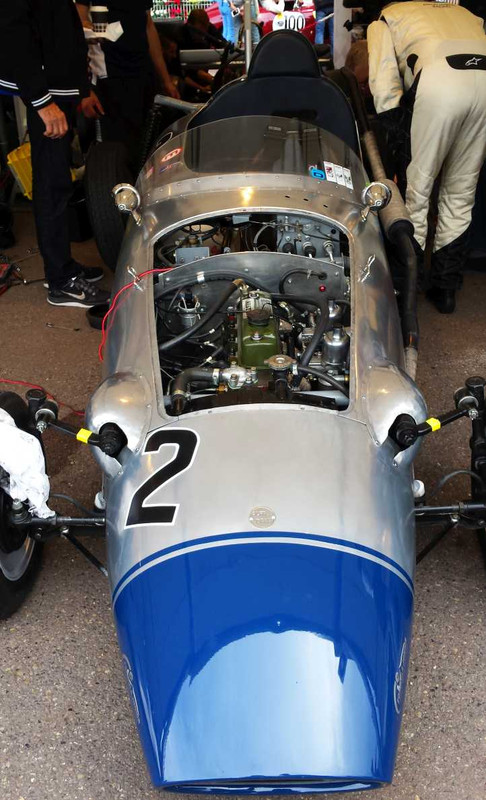
From Denmark. This Dana uses the BMC engine and also an incredible number of other BMC parts. The front suspension is all Morris Minor, lever-arm shock absorbers and all.
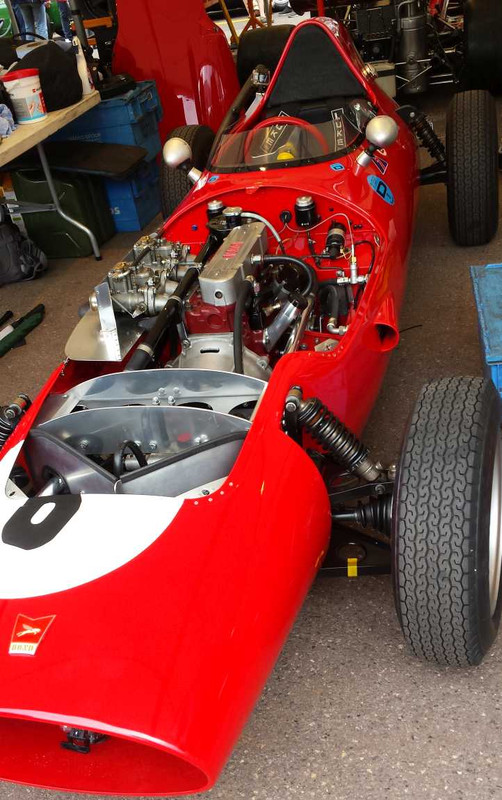
Front wheel drive. The Bond has a Ford engine, the Anglia engine which took over the formula during 1960. It looks to have a live rear axle.

Lola undressed. Eric Broadley embraced the formula and used it as a springboard to get into Formula One and Indycars along with Sports Cars. His Mk 2 used the Anglia engine to good effect and kept pace with most of the rear-engined cars which arrived in 1960.
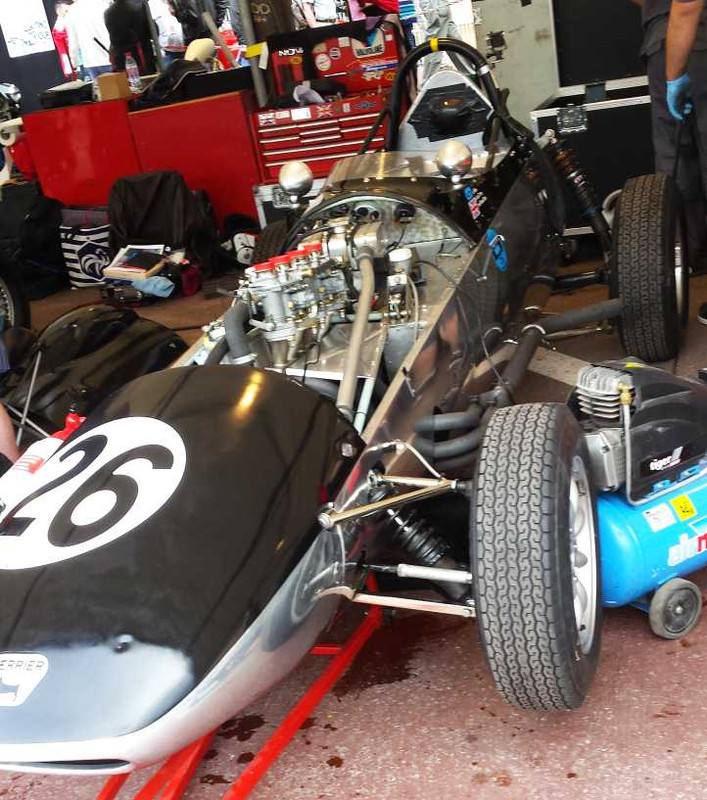
Terrier. Len Terry designed this one and it bristled with new ideas. He had a cylinder head modified to make it a down-draught inlet and used the Chapman strut rear suspension. In later life he worked for Chapman at Lotus and also for Dan Gurney, designing the classically beautiful early Eagles.

OSCA. Nick Grewal is an American who loves his Formula Juniors and he ran this OSCA with a Fiat engine and some very neat alloy wheels.
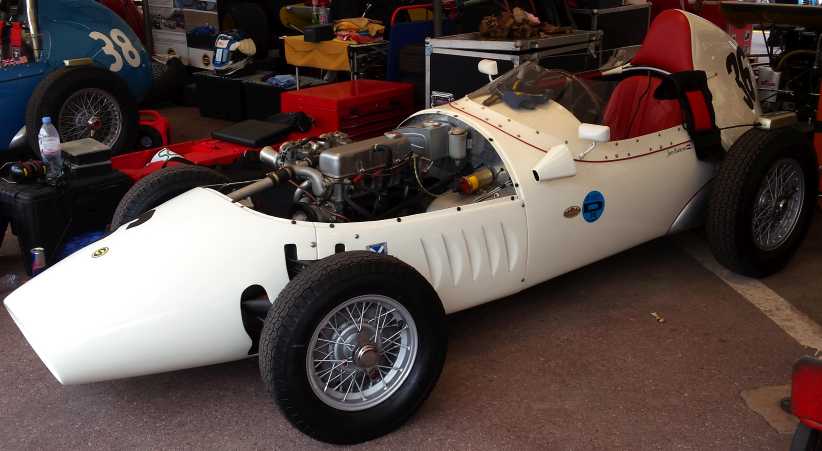
Stanguelini. Very popular in Italy and successful, these cars featured in the early years and also used the Fiat 1100 engine.
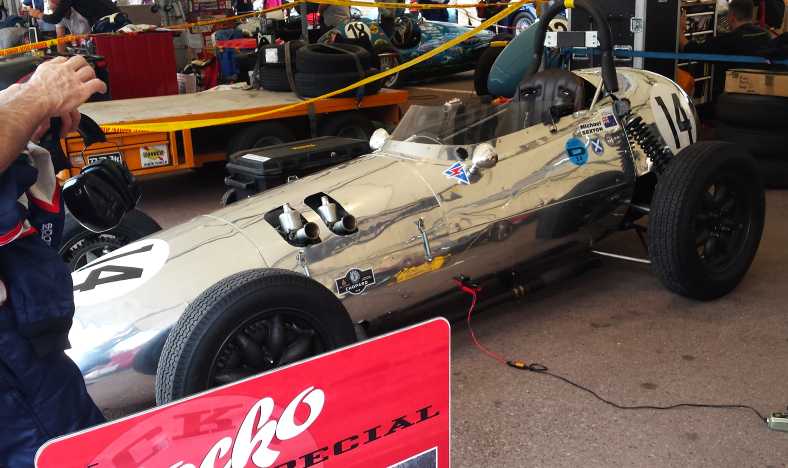
Gemini. Run by a couple of Kiwis who were a long way from home, the Gemini was another fledgling British car, this one BMC-powered.
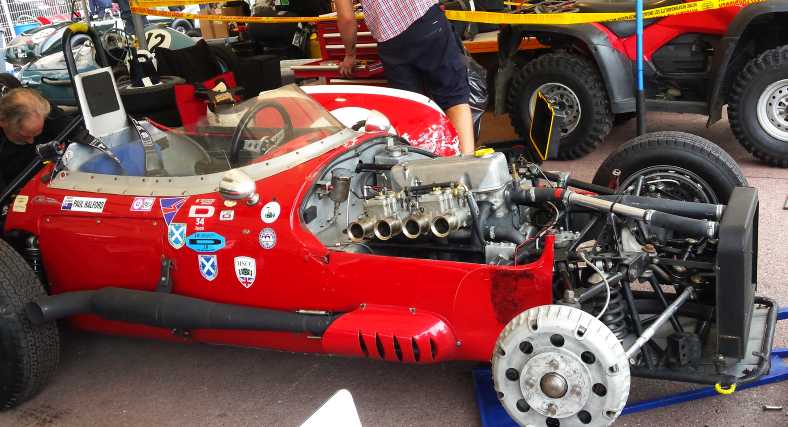
Autosud. The Fiat componentry can clearly be seen here in the Autosud, which looks to have been built by an Italian who studied some of the latest British cars.
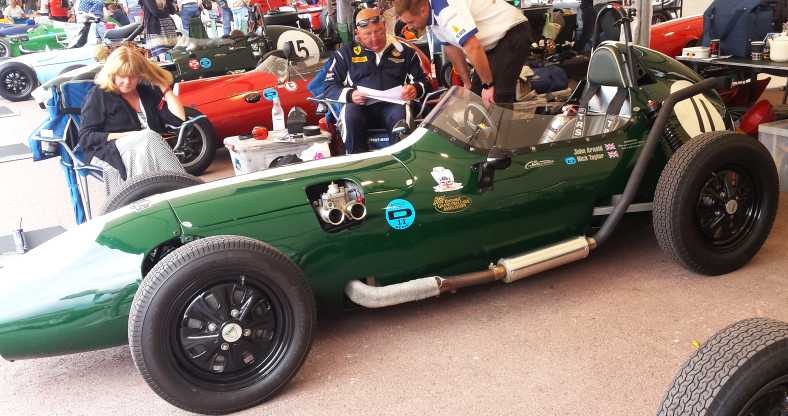
Elva. Another British maker who would go on to make many racing models, particularly in Sports Cars, this one is another to use the BMC engine.
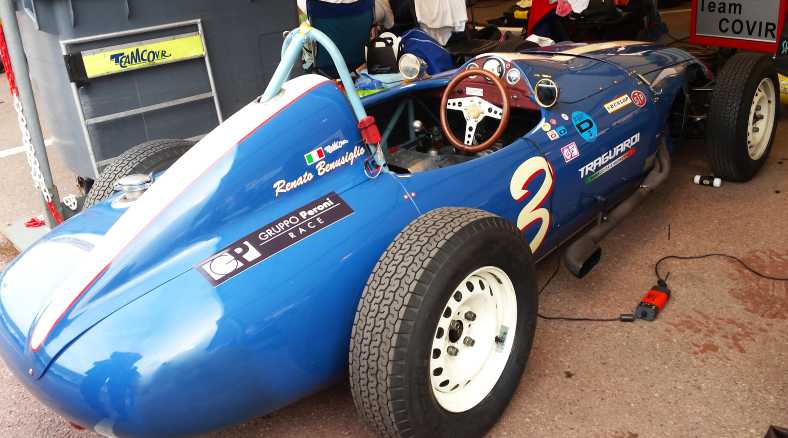
American-built. Unique among the cars here was the Apache, built in America and using the Fiat 1100 engine. It’s a solid looking car.
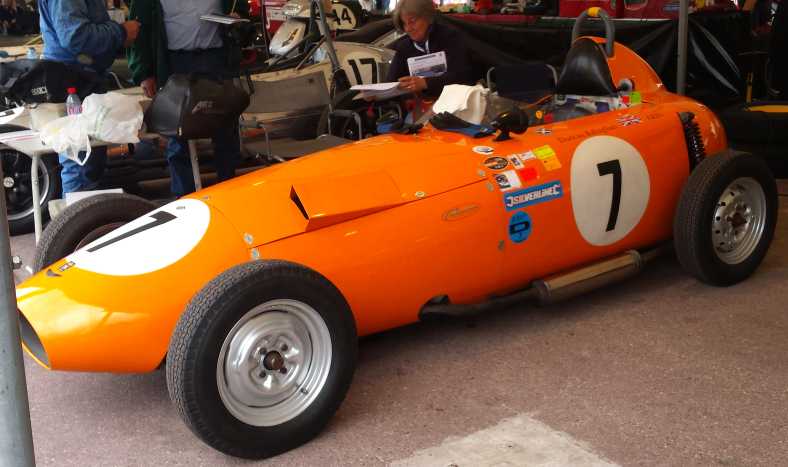
Alexis. A British make which also prospered for a short while, this car is owned and driven by the super-enthusiast Duncan Rabagliati. Duncan is the man behind all this world-wide Formula Junior revival.
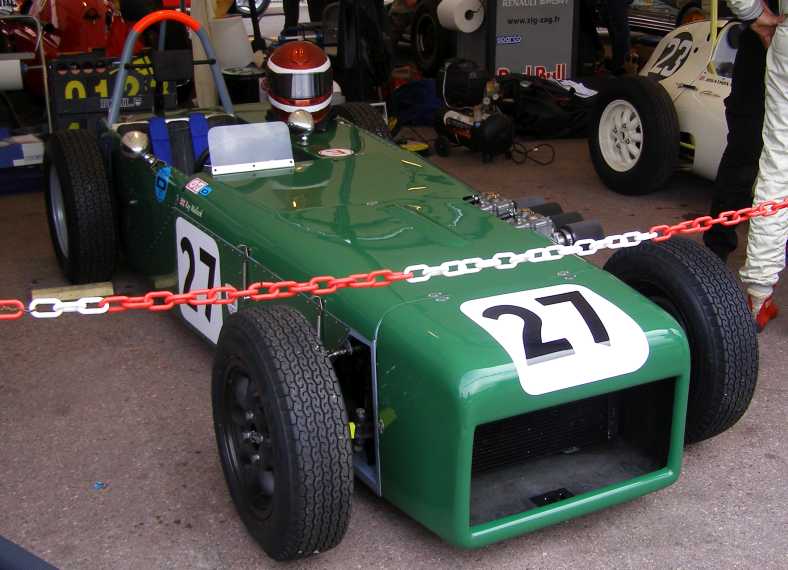
Mallock U2. There’s something about these Arthur Mallock designs. Built originally as ‘clubman’ sports cars, Mallock took on Formula Junior in it and succeeded, just as this car filled a third place on this weekend.
After wandering among the Juniors I took a little time to photograph some mechanical detail in some of the other cars that I thought interesting.
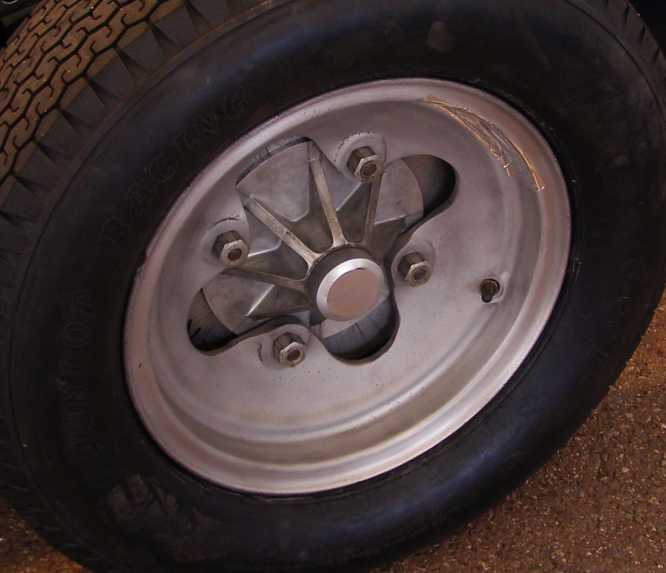
Wheel detail. I’m not sure which car this was on, but it was British and it’s not quite as simple as it first appears to be.
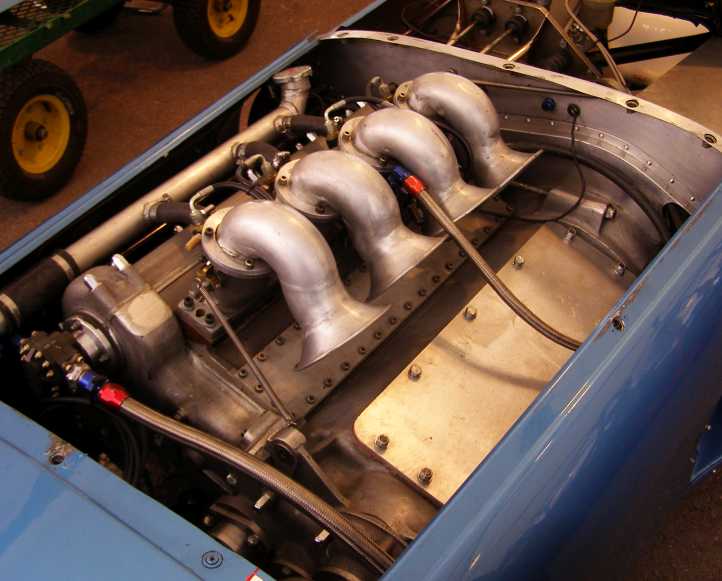
Scarab desmodromic. Perhaps the car which impressed me the most was the Scarab. These cars were built as US entries into the Grand Prix world in 1960 and didn’t make much impact. Their engine featured desmodromic valve operation (no springs, the cam opens and shuts the valve) and were based on the Indy engines of the time.

Plenty of gears. There’s more to this than just the gears, for the rear brakes are inboard and the whole transaxle is unique to the Scarab. Lance Reventlow funded these cars.
And there’s still more to go…
This was probably the time I regretted most that I’d convinced Sandra that we should make this trip our honeymoon. I could have spent hours, not to mention all weekend, at this event and still not seen all I’d like to see. And had much more opportunity to talk to people who are a part of this scene.
Well, I was thinking that this will be my one-and-only trip to Europe in the later years of my life and why not see more of what I want to see. Incidentally, the one who said this to me was one of those I came across on the Friday afternoon and he was enjoying it all too.
Not so Sandra. But she did help out by taking a lot of photos. The cars were based along the waterfront down from the part of the circuit past the swimming pool. And there was just a smorgasbord for me to look at!
Let’s start with the Formula Juniors. For those not familiar with Formula Junior, it came out of Italy in the late fifties and was adopted world-wide as a learning or ‘nursery’ formula for drivers. Engines and other mechanical components had to be based on production car units and there was a limit of 1,100cc.
Of course, all of this was at the time when Formula One was in the process of learning that rear-engined cars were going to be quicker and Formula Junior was soon to learn the same. But for the first year or two there was a preponderance of front-engined cars and they had some significant limelight at this event. It was also part of a ‘grand tour’ the cars of this formula were doing with races all around the world.
Some of the Juniors at Monaco:

From Denmark. This Dana uses the BMC engine and also an incredible number of other BMC parts. The front suspension is all Morris Minor, lever-arm shock absorbers and all.

Front wheel drive. The Bond has a Ford engine, the Anglia engine which took over the formula during 1960. It looks to have a live rear axle.

Lola undressed. Eric Broadley embraced the formula and used it as a springboard to get into Formula One and Indycars along with Sports Cars. His Mk 2 used the Anglia engine to good effect and kept pace with most of the rear-engined cars which arrived in 1960.

Terrier. Len Terry designed this one and it bristled with new ideas. He had a cylinder head modified to make it a down-draught inlet and used the Chapman strut rear suspension. In later life he worked for Chapman at Lotus and also for Dan Gurney, designing the classically beautiful early Eagles.

OSCA. Nick Grewal is an American who loves his Formula Juniors and he ran this OSCA with a Fiat engine and some very neat alloy wheels.

Stanguelini. Very popular in Italy and successful, these cars featured in the early years and also used the Fiat 1100 engine.

Gemini. Run by a couple of Kiwis who were a long way from home, the Gemini was another fledgling British car, this one BMC-powered.

Autosud. The Fiat componentry can clearly be seen here in the Autosud, which looks to have been built by an Italian who studied some of the latest British cars.

Elva. Another British maker who would go on to make many racing models, particularly in Sports Cars, this one is another to use the BMC engine.

American-built. Unique among the cars here was the Apache, built in America and using the Fiat 1100 engine. It’s a solid looking car.

Alexis. A British make which also prospered for a short while, this car is owned and driven by the super-enthusiast Duncan Rabagliati. Duncan is the man behind all this world-wide Formula Junior revival.

Mallock U2. There’s something about these Arthur Mallock designs. Built originally as ‘clubman’ sports cars, Mallock took on Formula Junior in it and succeeded, just as this car filled a third place on this weekend.
After wandering among the Juniors I took a little time to photograph some mechanical detail in some of the other cars that I thought interesting.

Wheel detail. I’m not sure which car this was on, but it was British and it’s not quite as simple as it first appears to be.

Scarab desmodromic. Perhaps the car which impressed me the most was the Scarab. These cars were built as US entries into the Grand Prix world in 1960 and didn’t make much impact. Their engine featured desmodromic valve operation (no springs, the cam opens and shuts the valve) and were based on the Indy engines of the time.

Plenty of gears. There’s more to this than just the gears, for the rear brakes are inboard and the whole transaxle is unique to the Scarab. Lance Reventlow funded these cars.
And there’s still more to go…
This was probably the time I regretted most that I’d convinced Sandra that we should make this trip our honeymoon. I could have spent hours, not to mention all weekend, at this event and still not seen all I’d like to see. And had much more opportunity to talk to people who are a part of this scene.
#183
More pics from Monaco…
These are from the thirties cars, principally Sports Cars.
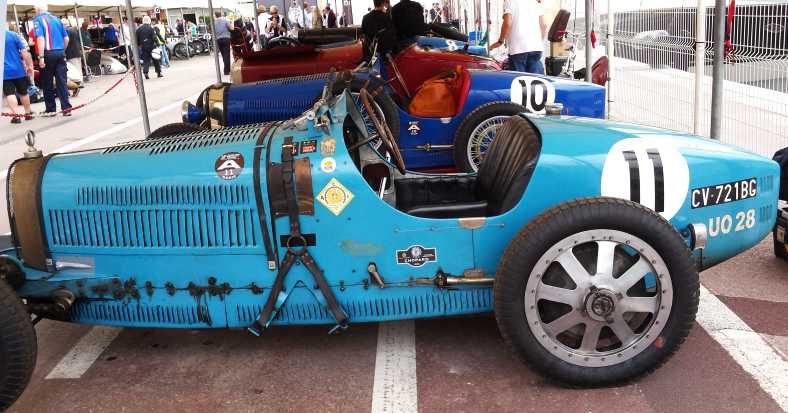
Bugattis. Such a meeting couldn’t be held without Bugattis, could it? These look like Type 35s, or maybe 51s, the alloy wheels are surely reproductions as the originals did break.

Alfa Romeo 1750 Zagato. Alfa Romeo’s association with the design house and body-builder Zagato has been long. We watched Alfa GTZs racing in prototype racing in the sixties, no doubt there were connections beyond that. This one, or one just like it, won the Mille Miglia in 1929 and 1930.
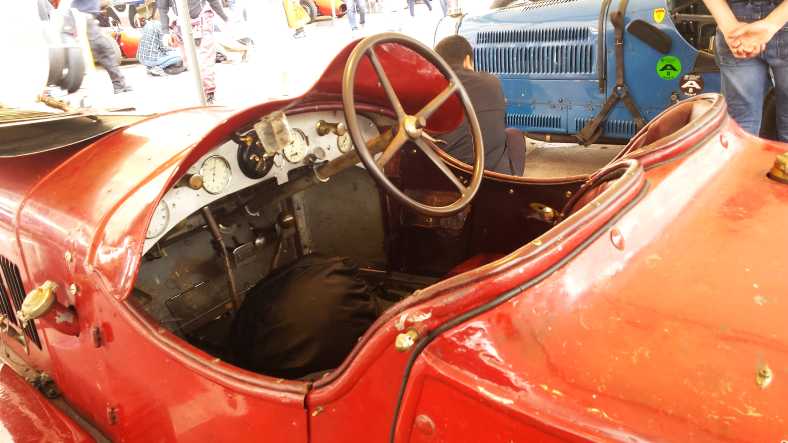
Cockpit detail. Inside the Alfa, which features a twin-cam 6-cylinder engine, there are good downward-facing lights for night-time fast driving, big instruments across the dash and the traditional pedal layout with central accelerator pedal.
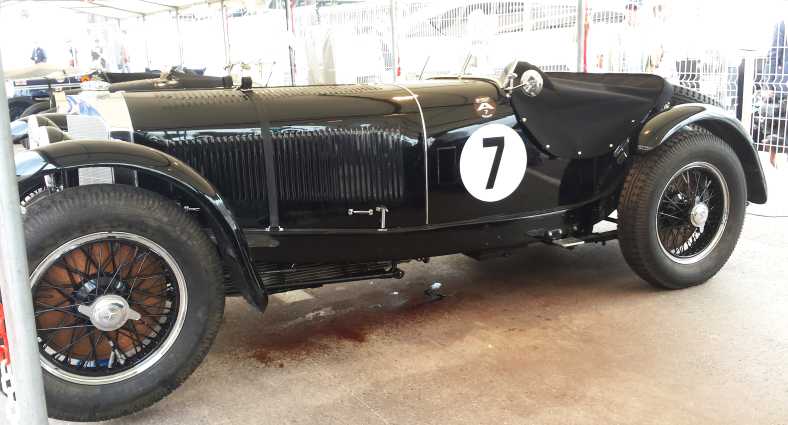
Mercedes. It was a Mercedes which put an end to the Mille Miglia domination of Alfa Romeo in 1931, but I don’t think it was this one. An impressive car.
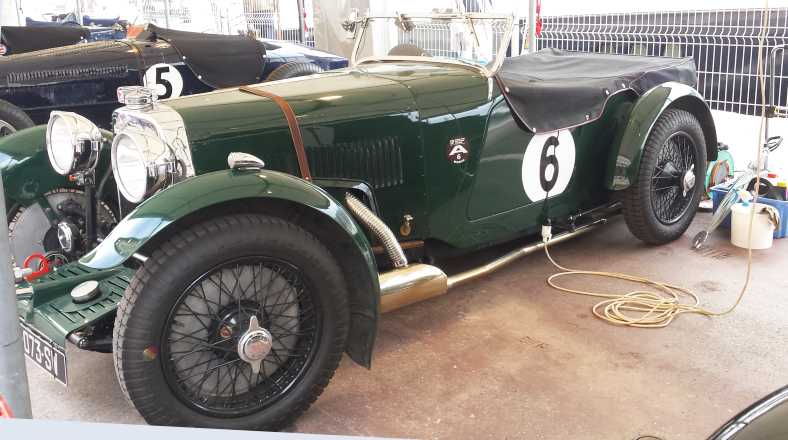
Aston Martin. This Aston Martin is a Le Mans 2/4-seater as was used at Le Mans in 1934. It had no success, but its successor did very well the following year with a class win and third place outright.

MG Magnette. Note the six pipes? It’s only an 1100cc car, but supercharged and in its day a bit of a world-beater. Even Tazio Nuvolari raced in one, winning the Tourist Trophy. The MG K3 is one of the most desirable of all the MG models. Note the top of the carburettor showing at the front, where it's bolted up to the supercharger.
And these are from some forties and fifties Racing Cars:
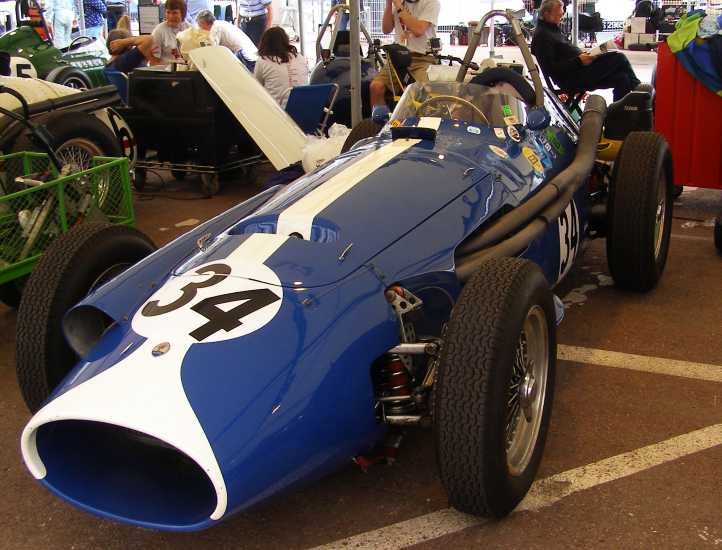
Maserati 250F. No, not all Italian racing cars are red! In the fifties there were privateers, including some from America, who painted them in their own national racing colours.
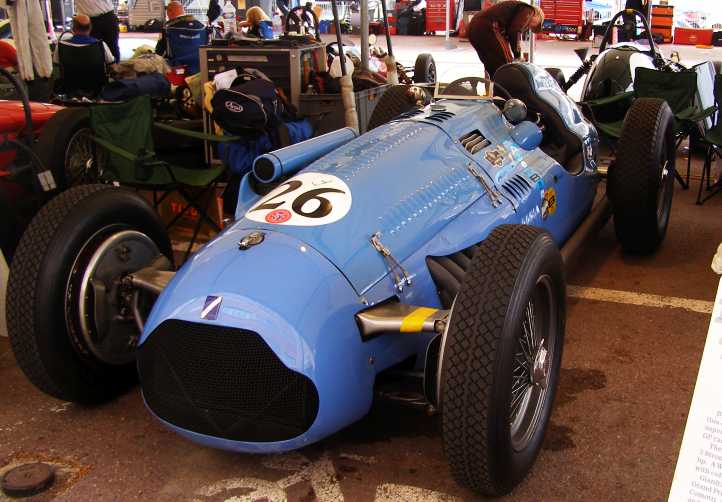
Lago Talbot. Speaking of national colours, the French blue was evident on some cars and this 1948 Lago Talbot was among them. It was a 6-cylinder of 4.5-litres to fit in with the Formula One of the 1947-1953 period.
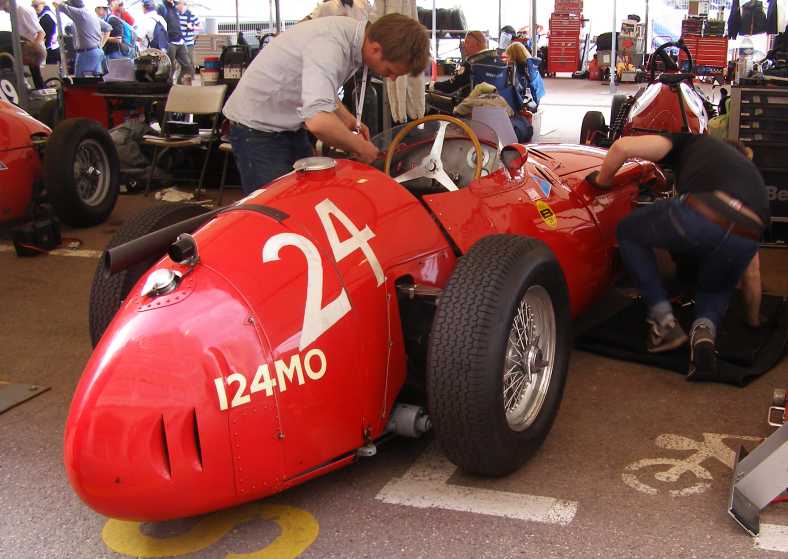
Another Maserati. Looking very businesslike, this 250F shows off the view most competitors saw of them in the mid-fifties. Fangio won his last World Championship driving one of these in 1957 and absolutely demoralised the opposition that year at the Nurburgring and Rouen.

Simca Gordini. Amadee Gordini was known as ‘The Sorcerer’ for the way he could build cars that performed well on very limited budgets. This was his 1947 car, built with backing from Simca and using a 1220cc 4-cylinder engine.
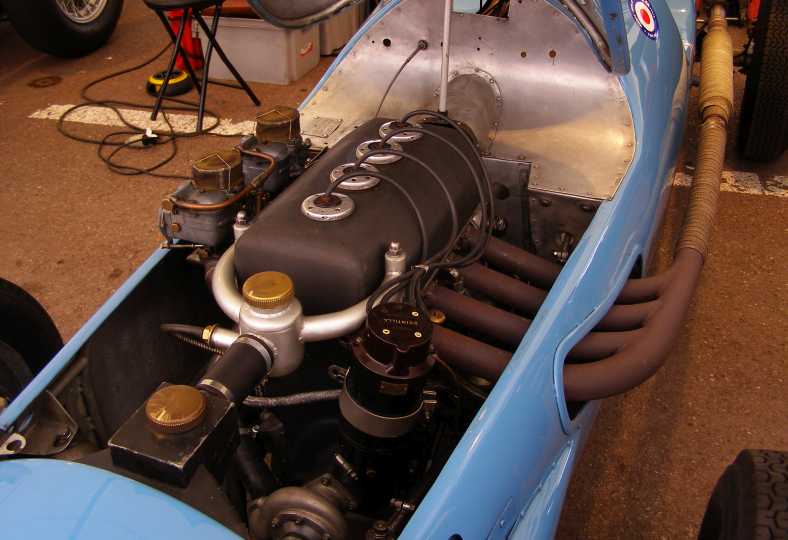
Simca Gordini engine. Looking fairly plain, undoubtedly under that rocker cover is a pushrod and rocker arrangement similar to those he used in Renault Gordini engines in the sixties. And no, that’s not a turbo up front, that’s the water pump.
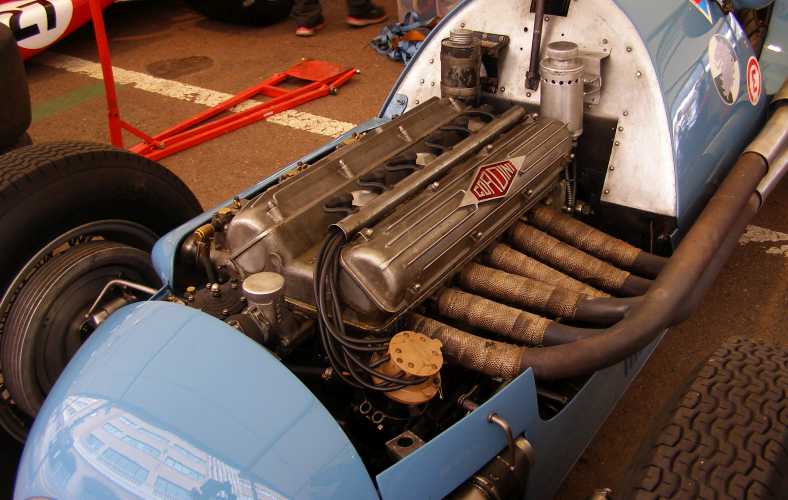
Gordini Twin Cam. After losing Simca’s backing, Gordini mustered help from other quarters in 1952 and built his own 6-cylinder twin-cam engine. First as a 2-litre and later bored out to 2.5-litres for the 1954-60 Formula One.
I have a lot of admiration for what Gordini achieved, but the other cars shown all represent the efforts of people who kept their thinking caps on and helped produce cars that achieved successes in different areas of the sport.
Next we’ll look at some more modern cars...
These are from the thirties cars, principally Sports Cars.

Bugattis. Such a meeting couldn’t be held without Bugattis, could it? These look like Type 35s, or maybe 51s, the alloy wheels are surely reproductions as the originals did break.

Alfa Romeo 1750 Zagato. Alfa Romeo’s association with the design house and body-builder Zagato has been long. We watched Alfa GTZs racing in prototype racing in the sixties, no doubt there were connections beyond that. This one, or one just like it, won the Mille Miglia in 1929 and 1930.

Cockpit detail. Inside the Alfa, which features a twin-cam 6-cylinder engine, there are good downward-facing lights for night-time fast driving, big instruments across the dash and the traditional pedal layout with central accelerator pedal.

Mercedes. It was a Mercedes which put an end to the Mille Miglia domination of Alfa Romeo in 1931, but I don’t think it was this one. An impressive car.

Aston Martin. This Aston Martin is a Le Mans 2/4-seater as was used at Le Mans in 1934. It had no success, but its successor did very well the following year with a class win and third place outright.

MG Magnette. Note the six pipes? It’s only an 1100cc car, but supercharged and in its day a bit of a world-beater. Even Tazio Nuvolari raced in one, winning the Tourist Trophy. The MG K3 is one of the most desirable of all the MG models. Note the top of the carburettor showing at the front, where it's bolted up to the supercharger.
And these are from some forties and fifties Racing Cars:

Maserati 250F. No, not all Italian racing cars are red! In the fifties there were privateers, including some from America, who painted them in their own national racing colours.

Lago Talbot. Speaking of national colours, the French blue was evident on some cars and this 1948 Lago Talbot was among them. It was a 6-cylinder of 4.5-litres to fit in with the Formula One of the 1947-1953 period.

Another Maserati. Looking very businesslike, this 250F shows off the view most competitors saw of them in the mid-fifties. Fangio won his last World Championship driving one of these in 1957 and absolutely demoralised the opposition that year at the Nurburgring and Rouen.

Simca Gordini. Amadee Gordini was known as ‘The Sorcerer’ for the way he could build cars that performed well on very limited budgets. This was his 1947 car, built with backing from Simca and using a 1220cc 4-cylinder engine.

Simca Gordini engine. Looking fairly plain, undoubtedly under that rocker cover is a pushrod and rocker arrangement similar to those he used in Renault Gordini engines in the sixties. And no, that’s not a turbo up front, that’s the water pump.

Gordini Twin Cam. After losing Simca’s backing, Gordini mustered help from other quarters in 1952 and built his own 6-cylinder twin-cam engine. First as a 2-litre and later bored out to 2.5-litres for the 1954-60 Formula One.
I have a lot of admiration for what Gordini achieved, but the other cars shown all represent the efforts of people who kept their thinking caps on and helped produce cars that achieved successes in different areas of the sport.
Next we’ll look at some more modern cars...
Last edited by Ray Bell; 01-24-2020 at 05:35 AM.
#184
Closer to the old Hairpin in that harbourside area where the cars were worked on and spent their time waiting we moved along to the cars these days said to be from the ‘Wings and Slicks’ era. Well, 1969 didn’t see much in the way of slicks, but wings were certainly in.
These are all Formula One cars…
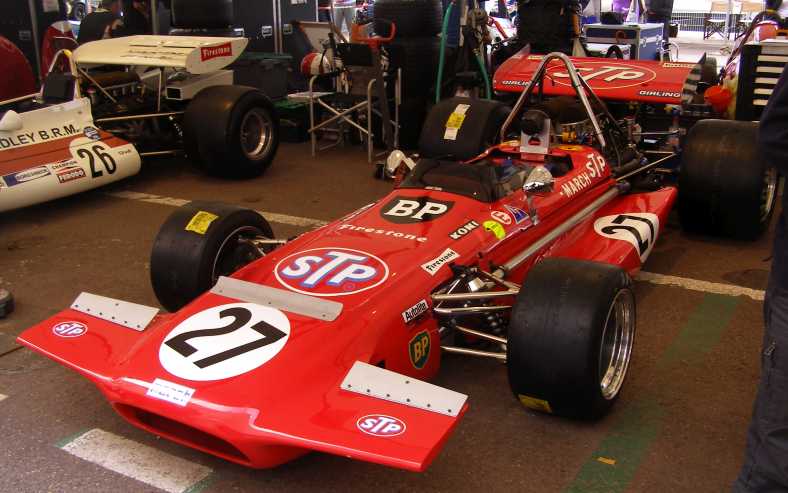
March 701 March arose in 1970 with some good men like Robin Herd in the design office and some good financial backing to build Formula One cars for that season. It was a project which could not have taken place without the ready availability of the Cosworth DFV engine and the Hewland transmissions, this being a constant among the cars built by people Enzo Ferrari called ‘Garagistes’. Chris Amon left Ferrari to drive for them along with Mario Andretti and the Swiss star, Jo Siffert. This is a car painted up as the ‘Works’ drivers raced them. In addition, Team Tyrrell abandoned Matra and with with March with cars for Jackie Stewart and Francois Cevert.

BRM P153. BRM had been long-term failures in Formula One in the fifties, then in 1962 the came good to be very competitive and to take championships and many wins in the 1.5-litre formula that expired in 1965. From 1966 they lost their way, however, until they abandoned the heavy H16 engine and concentrated on the V12 layout they’d initially designed as an engine to sell to customers. By 1970 they were well on their winning way again and with help from Mexican Pedro Rodriguez and in 1971 Swiss Jo Siffert were again at the top of their class. One of these cars won the Belgian Grand Prix of 1970, I’m sure I recall that it was the fastest-ever Grand Prix race till that time. And a P160 won the Monaco Grand Prix of 1972, which was the slowest to that time in the same car which had won at Monza in another scorching fast race. I think. Sadly, it was in the P160 model that Jo Siffert perished at Brands Hatch in 1971.
Eifelland. German driver Rolf Stommelen had sponsorship from Eifelland Caravans in Germany and they modified this March to enable them to change its appearance and its name.
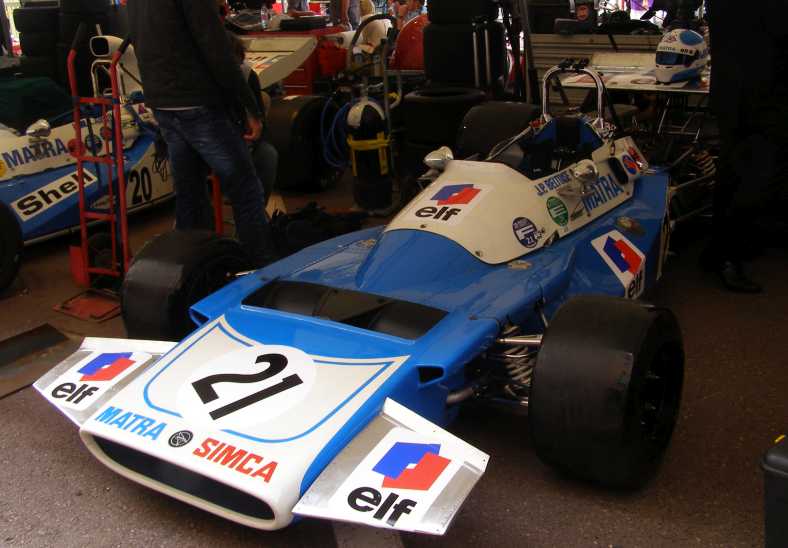
Matra. After supplying cars to Ken Tyrrell for Jackie Stewart to drive, Matra went out on their own with a team including Jean-Pierre Beltoise.
This car, the MS120B, was driven at the Historique Grand Prix by the son of Jean-Pierre Beltoise, Anthony. There’s a ten minute You Tube clip with interviews with Jean-Pierre and Anthony, also Jacky Ickx, and some coverage of the race in which Anthony competed as well as clips from his father’s racing. It’s in French, but if you have ten minutes it’s worth the time even if you don’t know all they’re saying:
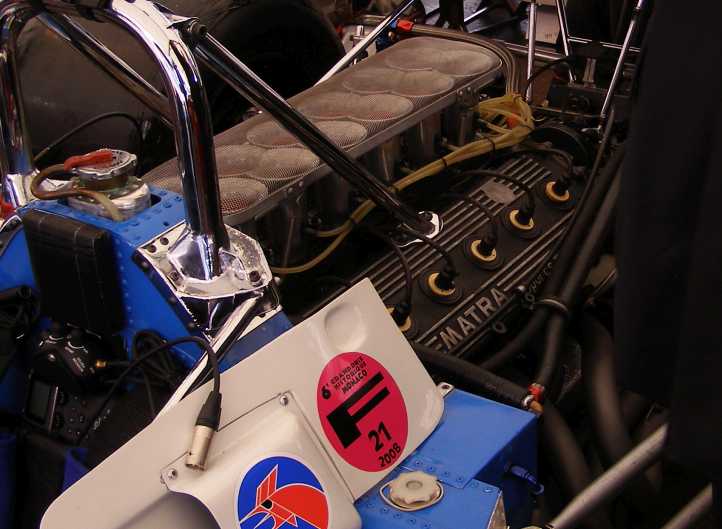
The shrieking Matra V12. Matra cars were built by Engins Matra, an aerospace and weaponry maker. They went racing to show off their ability to bridge new technological challenges and to help sell their core products. Along the way they built this powerful V12 engine which quickly gained notoriety for its loud exhaust note.
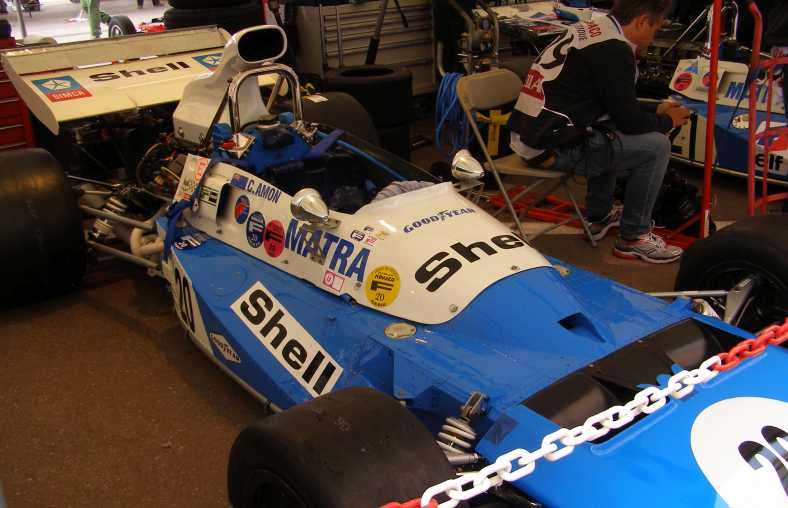
Amon and Matra. In 1971 and 1972 the New Zealand driver, Chris Amon, drove for Matra. Memorable in that period for him were leading the French Grand Prix at Clermont Ferrand until the second last lap and keeping that wailing V12 on full throttle at many other races.
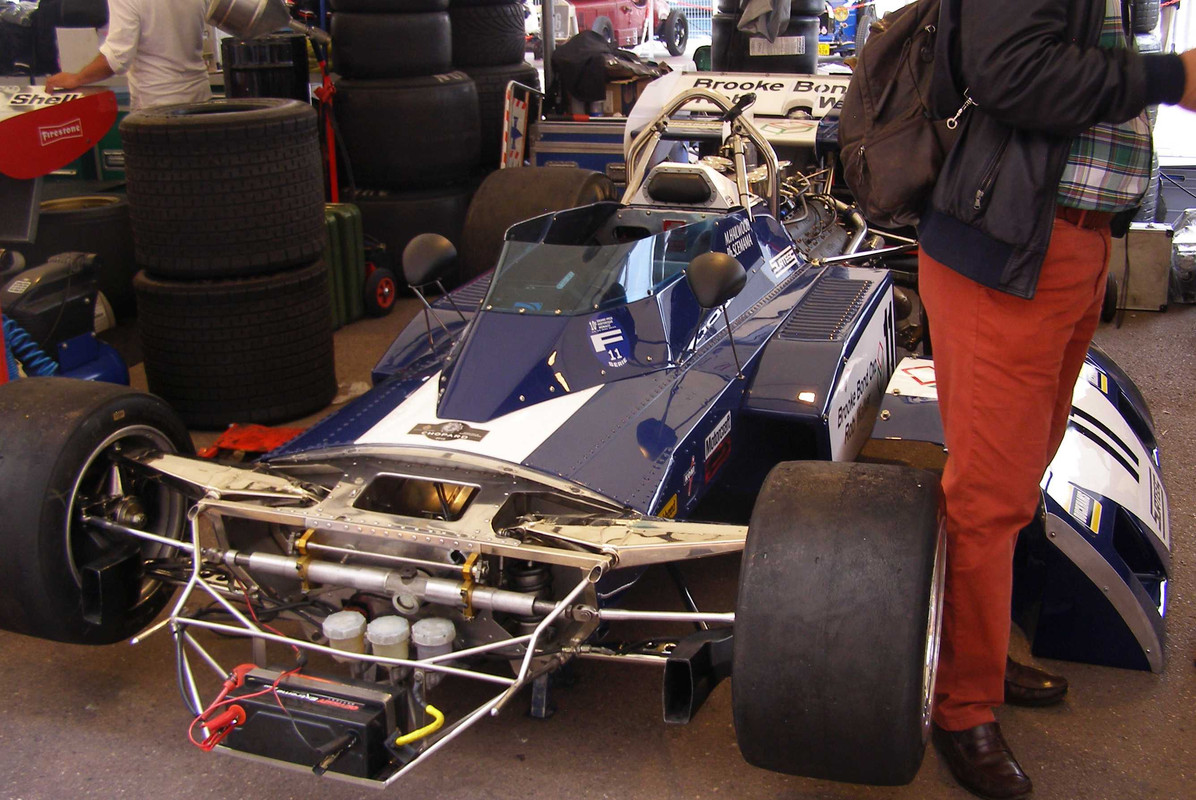
Surtees TS11. John Surtees was a multiple World Champion on motorcycles and then won the World Championship in Formula One driving for Ferrari in 1964. Later he branched out on his own and built a line of cars with the ‘TS’ (Team Surtees) prefix for various formulae. His 1971 car was this one, developed from the TS9B, and carried sponsorship from Brook Bond Oxo, the stock cube arm of the Brook Bond Tea empire. The arrow down the centre of the car was a Team Surtees trademark from the time the team began running Lola sports cars in the mid-sixties.
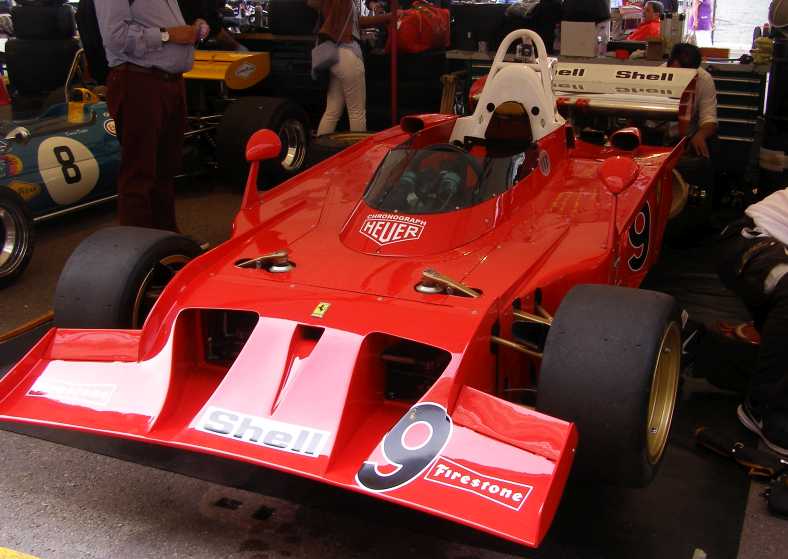
Ferrari ‘snow plough’. Ferrari came up with this design officially called the 312B3, it carried Ferrari hopes in 1973 using a flat 12 engine. Unofficially it had the Italian word for 'snow plough' attached to it.
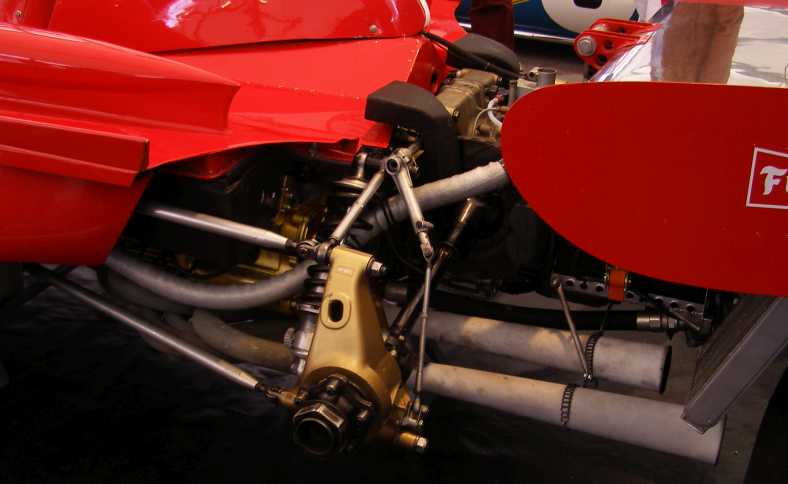
Ferrari castings. There’s always something wonderful about the intricate castings Ferrari make for their cars. Here we see the rear upright, but further in there’s a transaxle case which has suspension mounting points included in it. And there is always something nice about the way the people at Ferrari make their cars.

Brabham BT33, Going straight from what some might argue was one of the least attractive F1 cars of the era to one that I feel was one of the best looking, here we have the car in which Jack Brabham almost won Monaco’s Grand Prix in 1970. A last-corner miscue saw him skate into the fence and allowed Jochen Rindt to win. A win which arguably cost Jack a fourth World Championship in his final year of Grand Prix racing. It was the second year Jack had used the Cosworth DFV engine and this was the first monocoque Brabham.
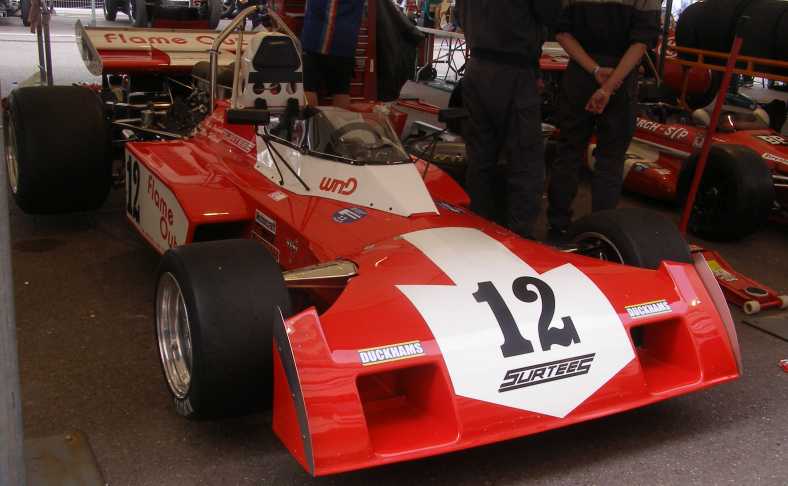
Another TS11. This one was painted red, but otherwise it’s pretty much the same as the blue one. Though those aluminium ‘fences’ up the sides of the nose are different.

March 711. Another car of questionable aesthetics of the era, the March 711 was the car that allowed Ronnie Peterson to show his stuff in Formula One.
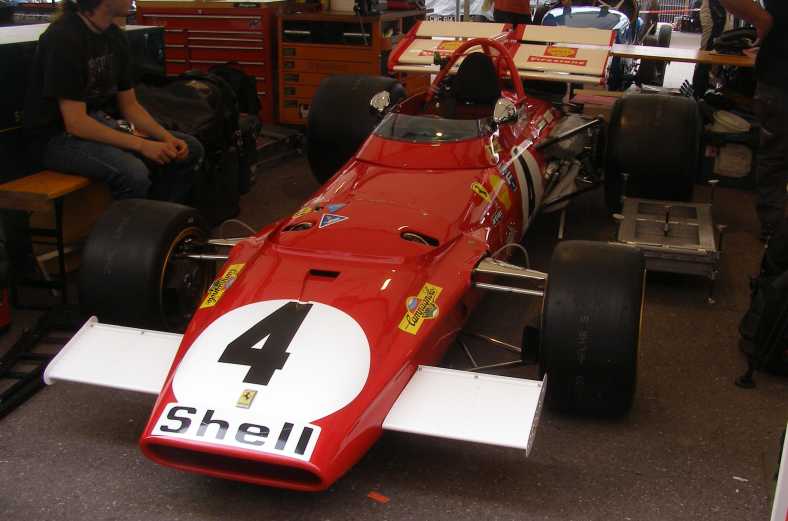
Ferrari 312B2. Like the Brabham, a more traditional appearance was bestowed on this model. Drivers like Clay Regazzoni and Jackie Ickx used this flat 12-powered machine to keep the Ferrari flag flying.
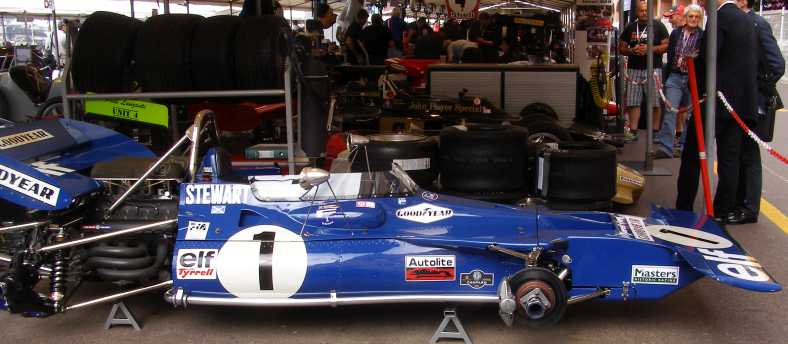
Tyrrell 001. After running the Matras and the Marches, Ken Tyrrell had Derek Gardner and his team build this car, in which a lot of success came to them. Jackie Stewart drove it, with Peter Revson doing so just once, Cosworth and Hewland supplied the heavy machinery. It won Stewart and Tyrrell the World Drivers and World Constructors Championships.
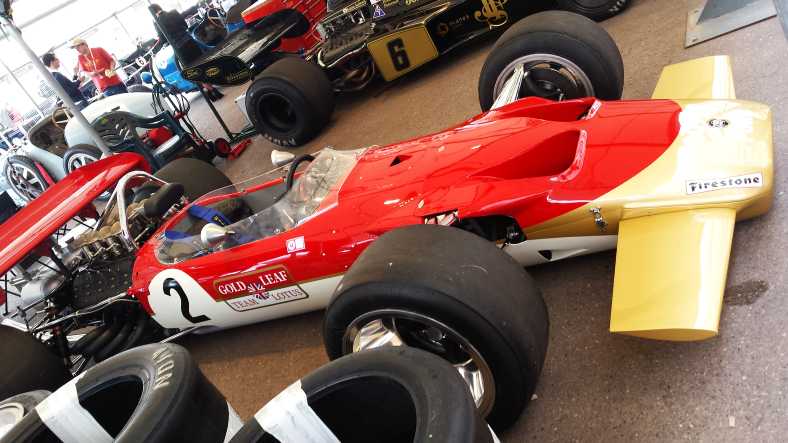
Lotus 49. The car which Rindt drove to that famous victory over Brabham at Monaco, it also won that Grand Prix the two previous years in Graham Hill’s hands. This was the first car to be fitted with the Cosworth DFV engine, which was used as a stressed member instead of rear chassis structure, and won on its debut at the Dutch GP in 1967. It won the Tasman Cup series in 2.5-litre form for Jim Clark in 1968 and took Hill to the World Championship in 1968. It contributed greatly to Rindt’s title win in 1970, A very successful car and the car which brought major cigarette advertising to Grand Prix racing.
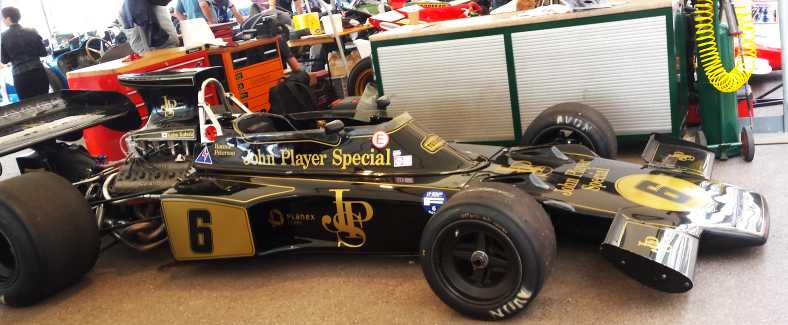
Lotus 72. This was the car which Rindt used to complete his 1970 title chase in, also the model in which he died. The front brakes were inboard, hence those exhausts over the driver’s feet. But the shafts which drove the discs from the wheels suffered from faulty machining where they were bored out inside to lighten them and one of these broke and severed Rindt’s leg while he was braking from very high speed at Monza that year. When all the bugs were ironed out these were very quick cars and succeeded over a long period. But this one is from a couple of years later and it went into the wall the very next day!
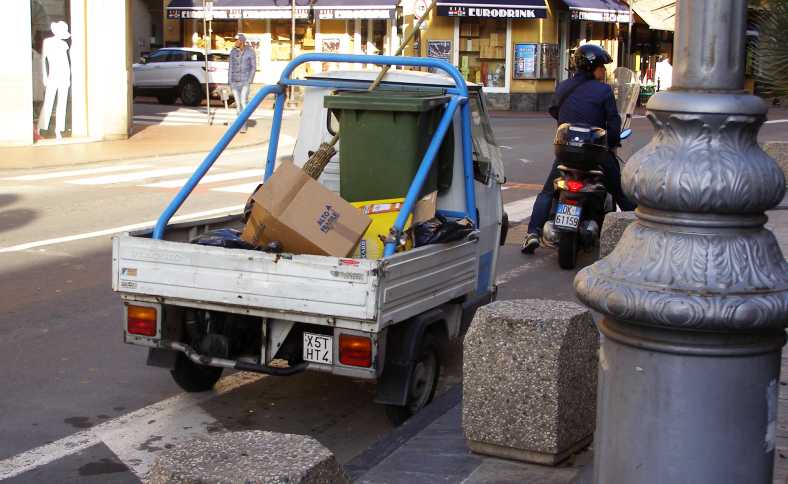
Coming down in Ventimiglia. Just a few miles from Monaco is the Italian city of Ventimiglia, from the glitz of Monaco we drove there and found somewhere to stay the night and the sight of this 3-wheeled delivery vehicle I considered to be a huge change from the racing cars which had captured my attention all afternoon.
The hotel we found in Ventimiglia was right in the centre of things, across the road from a park and comfortable. Due to Sandra’s inability to cope with the noise of the racing cars we decided she’d stay in Ventimiglia while I went back to the circuit on Saturday.
These are all Formula One cars…

March 701 March arose in 1970 with some good men like Robin Herd in the design office and some good financial backing to build Formula One cars for that season. It was a project which could not have taken place without the ready availability of the Cosworth DFV engine and the Hewland transmissions, this being a constant among the cars built by people Enzo Ferrari called ‘Garagistes’. Chris Amon left Ferrari to drive for them along with Mario Andretti and the Swiss star, Jo Siffert. This is a car painted up as the ‘Works’ drivers raced them. In addition, Team Tyrrell abandoned Matra and with with March with cars for Jackie Stewart and Francois Cevert.

BRM P153. BRM had been long-term failures in Formula One in the fifties, then in 1962 the came good to be very competitive and to take championships and many wins in the 1.5-litre formula that expired in 1965. From 1966 they lost their way, however, until they abandoned the heavy H16 engine and concentrated on the V12 layout they’d initially designed as an engine to sell to customers. By 1970 they were well on their winning way again and with help from Mexican Pedro Rodriguez and in 1971 Swiss Jo Siffert were again at the top of their class. One of these cars won the Belgian Grand Prix of 1970, I’m sure I recall that it was the fastest-ever Grand Prix race till that time. And a P160 won the Monaco Grand Prix of 1972, which was the slowest to that time in the same car which had won at Monza in another scorching fast race. I think. Sadly, it was in the P160 model that Jo Siffert perished at Brands Hatch in 1971.

Eifelland. German driver Rolf Stommelen had sponsorship from Eifelland Caravans in Germany and they modified this March to enable them to change its appearance and its name.

Matra. After supplying cars to Ken Tyrrell for Jackie Stewart to drive, Matra went out on their own with a team including Jean-Pierre Beltoise.
This car, the MS120B, was driven at the Historique Grand Prix by the son of Jean-Pierre Beltoise, Anthony. There’s a ten minute You Tube clip with interviews with Jean-Pierre and Anthony, also Jacky Ickx, and some coverage of the race in which Anthony competed as well as clips from his father’s racing. It’s in French, but if you have ten minutes it’s worth the time even if you don’t know all they’re saying:

The shrieking Matra V12. Matra cars were built by Engins Matra, an aerospace and weaponry maker. They went racing to show off their ability to bridge new technological challenges and to help sell their core products. Along the way they built this powerful V12 engine which quickly gained notoriety for its loud exhaust note.

Amon and Matra. In 1971 and 1972 the New Zealand driver, Chris Amon, drove for Matra. Memorable in that period for him were leading the French Grand Prix at Clermont Ferrand until the second last lap and keeping that wailing V12 on full throttle at many other races.

Surtees TS11. John Surtees was a multiple World Champion on motorcycles and then won the World Championship in Formula One driving for Ferrari in 1964. Later he branched out on his own and built a line of cars with the ‘TS’ (Team Surtees) prefix for various formulae. His 1971 car was this one, developed from the TS9B, and carried sponsorship from Brook Bond Oxo, the stock cube arm of the Brook Bond Tea empire. The arrow down the centre of the car was a Team Surtees trademark from the time the team began running Lola sports cars in the mid-sixties.

Ferrari ‘snow plough’. Ferrari came up with this design officially called the 312B3, it carried Ferrari hopes in 1973 using a flat 12 engine. Unofficially it had the Italian word for 'snow plough' attached to it.

Ferrari castings. There’s always something wonderful about the intricate castings Ferrari make for their cars. Here we see the rear upright, but further in there’s a transaxle case which has suspension mounting points included in it. And there is always something nice about the way the people at Ferrari make their cars.

Brabham BT33, Going straight from what some might argue was one of the least attractive F1 cars of the era to one that I feel was one of the best looking, here we have the car in which Jack Brabham almost won Monaco’s Grand Prix in 1970. A last-corner miscue saw him skate into the fence and allowed Jochen Rindt to win. A win which arguably cost Jack a fourth World Championship in his final year of Grand Prix racing. It was the second year Jack had used the Cosworth DFV engine and this was the first monocoque Brabham.

Another TS11. This one was painted red, but otherwise it’s pretty much the same as the blue one. Though those aluminium ‘fences’ up the sides of the nose are different.

March 711. Another car of questionable aesthetics of the era, the March 711 was the car that allowed Ronnie Peterson to show his stuff in Formula One.

Ferrari 312B2. Like the Brabham, a more traditional appearance was bestowed on this model. Drivers like Clay Regazzoni and Jackie Ickx used this flat 12-powered machine to keep the Ferrari flag flying.

Tyrrell 001. After running the Matras and the Marches, Ken Tyrrell had Derek Gardner and his team build this car, in which a lot of success came to them. Jackie Stewart drove it, with Peter Revson doing so just once, Cosworth and Hewland supplied the heavy machinery. It won Stewart and Tyrrell the World Drivers and World Constructors Championships.

Lotus 49. The car which Rindt drove to that famous victory over Brabham at Monaco, it also won that Grand Prix the two previous years in Graham Hill’s hands. This was the first car to be fitted with the Cosworth DFV engine, which was used as a stressed member instead of rear chassis structure, and won on its debut at the Dutch GP in 1967. It won the Tasman Cup series in 2.5-litre form for Jim Clark in 1968 and took Hill to the World Championship in 1968. It contributed greatly to Rindt’s title win in 1970, A very successful car and the car which brought major cigarette advertising to Grand Prix racing.

Lotus 72. This was the car which Rindt used to complete his 1970 title chase in, also the model in which he died. The front brakes were inboard, hence those exhausts over the driver’s feet. But the shafts which drove the discs from the wheels suffered from faulty machining where they were bored out inside to lighten them and one of these broke and severed Rindt’s leg while he was braking from very high speed at Monza that year. When all the bugs were ironed out these were very quick cars and succeeded over a long period. But this one is from a couple of years later and it went into the wall the very next day!

Coming down in Ventimiglia. Just a few miles from Monaco is the Italian city of Ventimiglia, from the glitz of Monaco we drove there and found somewhere to stay the night and the sight of this 3-wheeled delivery vehicle I considered to be a huge change from the racing cars which had captured my attention all afternoon.
The hotel we found in Ventimiglia was right in the centre of things, across the road from a park and comfortable. Due to Sandra’s inability to cope with the noise of the racing cars we decided she’d stay in Ventimiglia while I went back to the circuit on Saturday.
Last edited by Ray Bell; 06-13-2020 at 11:01 PM.
#185
I caught the train to Monaco from Ventimiglia. Just as I did when I arrived there in 1981. But I didn’t recall the huge underground railway station with all its tunnels exiting in every possible direction. Getting lost was easy!
Spectating at Monaco is not as one might expect at a normal racing circuit. At this place one has to buy a ticket to one area (usually a grandstand built up in the weeks before the event) and that’s where you watch from for the day. Or the weekend.
Of course, you are free to wander around the streets and alleys, but you won’t see anything other than a brief blur of colour as a car flashes by. And you can’t use your ticket to go to another viewing area, if you want to spend part of the day somewhere else it means buying another ticket. And they aren’t cheap.
Here’s the circuit map:
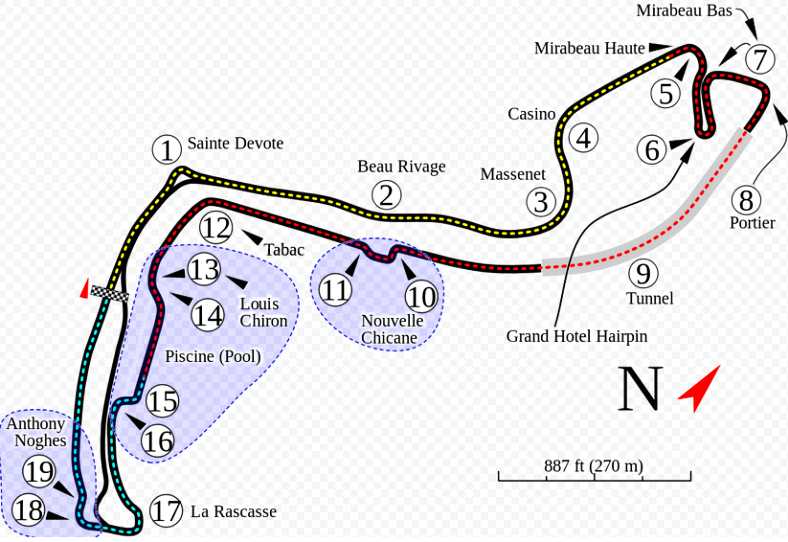
The ‘Wings and Slicks’ cars of the 3-litre formula were the first out after I arrived, and I’d stationed myself between the ‘Tabac’ corner and the swimming pool. And then I learned just how impossible my self-focussing camera was in a place like this.
‘Auto-focus’ has to be one of the worst inventions of the past hundred years. No longer can you aim your camera, set the focus (usually on infinity) and press the button. No, not now. The camera hunts around the picture and decides for itself what it’s going to focus on, and usually it changes that at the last instant so you are guaranteed to miss out on getting a fix on whatever it is you’re photographing.
The first few pics are all of cars we didn’t see the day before in the ‘garages’:
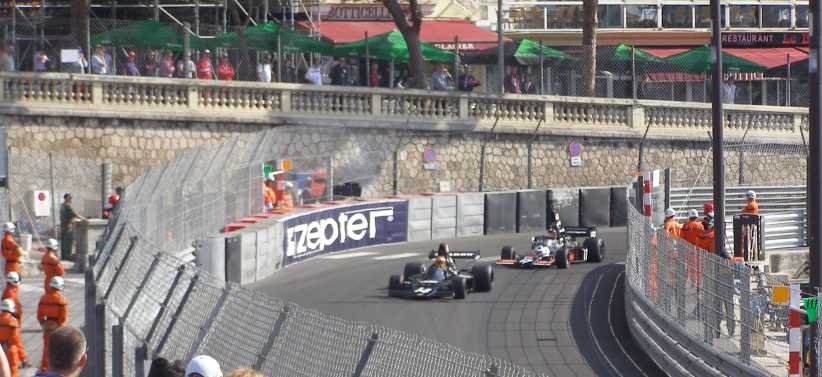
UOP Shadows. Don Nicholls and his UOP Shadows were part of the field in the early seventies. The two of them here are in the Tabac corner, the focus has jumped to the fences.
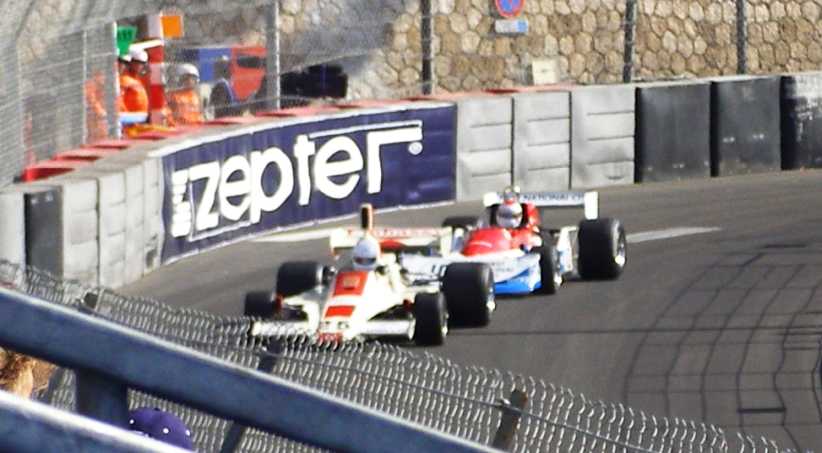
Hill and Penske. Graham Hill and Roger Penske were contemporaries as drivers but only ever competed against one another a small number of times in the early sixties. By the seventies, both were to build their own Formula One cars and here we have the Hill GH2 as raced by Graham and later Tony Brise and the Penske PC3. The PC3 came after Mark Donohue’s untimely death and was raced by John Watson, winning the Austrian Grand Prix.

Surtees and the original Lotus 49. Well the original colours of the Lotus 49. This Surtees, which has suffered terribly from the auto-focus problem, seems to be a TS7, the car ‘Fearless John’ used in 1970.
And the day rolled on. But for some the ride got pretty bumpy, whether that was because of mechanical mayhem or their own failings. As I mentioned, the Lotus 72 was to meet up with a wall, a wall that was pretty well-padded as you can see:
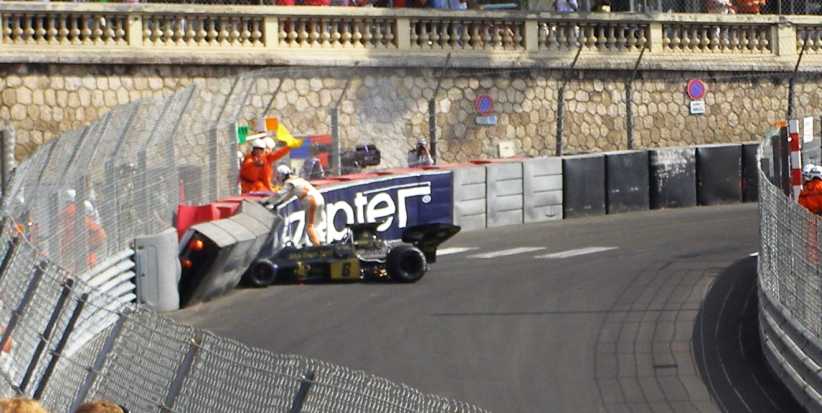
Lotus 72 into the wall. It must be very humiliating for the driver of one of these old cars to have this sort of crash. The car was hauled up onto a tilt-tray which pulled up right in front of where I was watching from but I couldn’t get a decent pic of the damage due to the crowd and the fence and the inevitable auto-focus problem. It looked like the right front suspension suffered a bit of damage with a little bit of disturbance to the aluminium structure ahead of the main chassis monocoque. And the bodywork, of course. One of the most interesting design features of the Lotus 72 was their springing, no coils at all, but a 2-piece concentric torsion bar with rising-rate linkages to the suspension uprights.
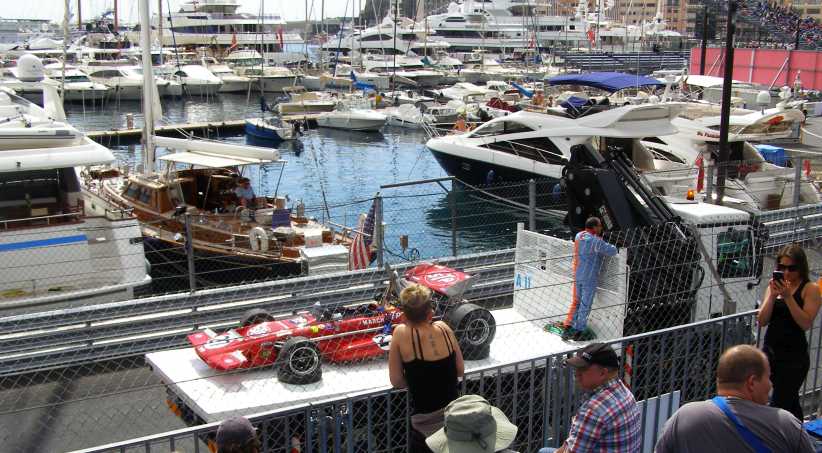
March retires. This one looks like a mechanical problem, which is a shame for the team who undoubtedly spent a lot of money and time getting it ready for and getting it to Monaco.
Then out came the cars from the thirties, the sports cars…
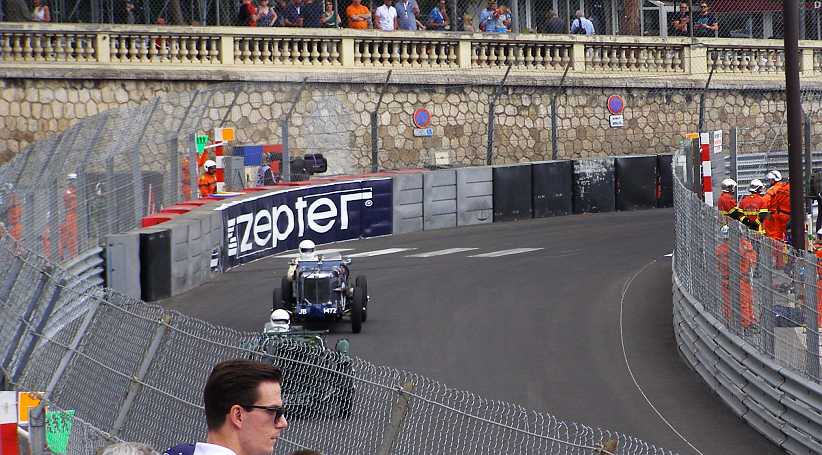
Aston and K3. The focus isn’t quite so bad with this one but the delay of the shutter after pressing the button means the Aston Martin has gone into partial obscurity! These were cars Sandra had photographed the previous day and so they are a part of the post before the previous one. The cover over the crankshaft-driven blower on the MG K3 doesn’t look original to me, by the way.
All of this was surrounded by the glitz of Monaco, with people up on high balconies and on the boats in the harbour watching on as they, no doubt, sipped champagne to wash down their caviar.
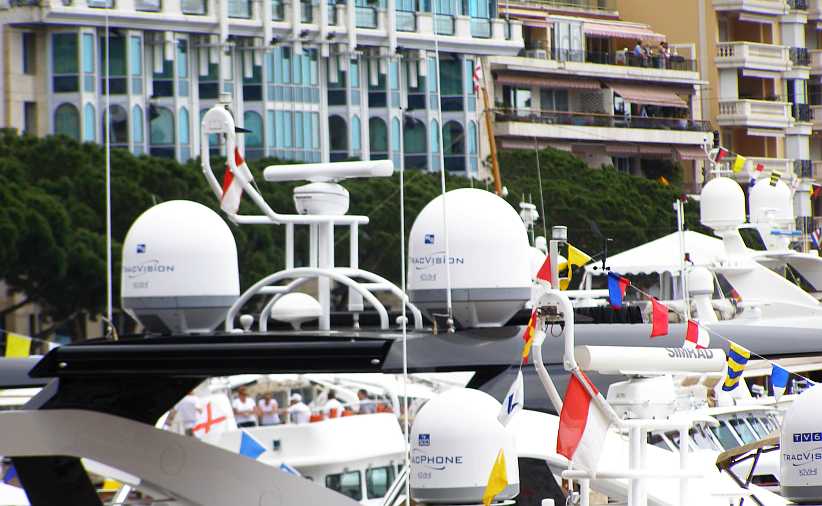
Spectators. It wasn’t just those in the stands watching on, but dwellers in the high-rise and those on boats were watching too. Of note to me was the array of electronics on board those yachts, great domes to receive satellite transmissions of television and, no doubt, phones.
At this point I decided it was time to take a walk to meet up with Barry Boor, a friend from the Atlas F1 Nostalgia forum. Barry had been living in Malta but had recently returned to live in England and I would be visiting him again a few weeks down the track.
So I set off with phone in hand to call him for directions (he was viewing somewhere near the Mirabeau section) and tried to navigate my way around the blocked-off streets to find him. Of course, I went into some of the many tunnels, these led to the station, to carparks and elsewhere. It was a long and wearing walk, but I did see some interesting stuff along the way…
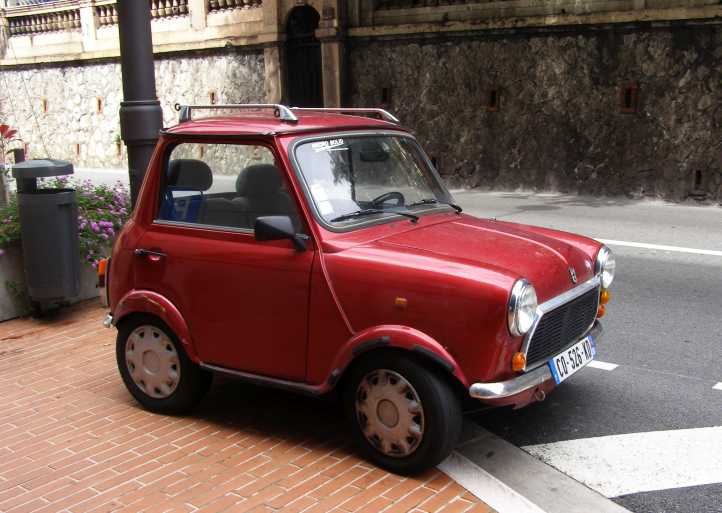
The Mini Mini. Americans aren’t the only ones who do oddball things with cars, this was parked somewhere near the Casino area and had a sticker on the windscreen which read: “Micro Bolid” 2.17m – 140km/h La plus petite voiture thermique au monde.” Maybe it’s good for parking, but I don’t think I’d like to be trying to keep it in a straight line at 140kmh!
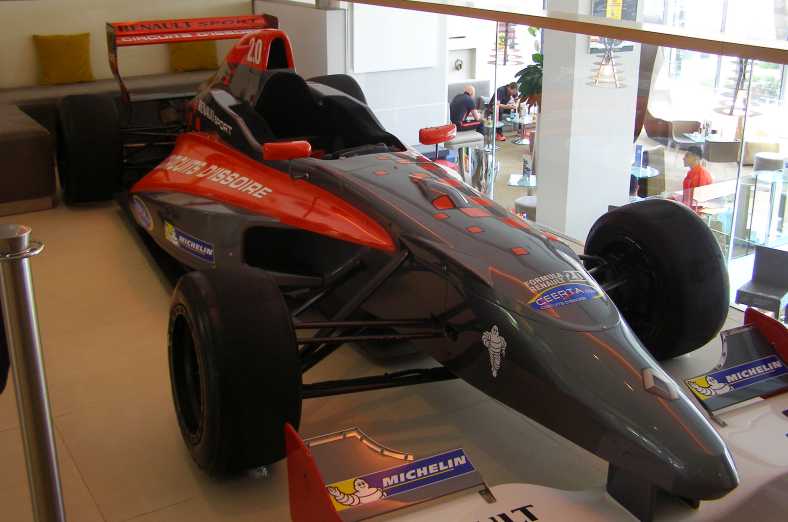
Formula Renault. In one place along the way there was this Formula Renault car, which features a 2-litre engine. It’s a popular category in Southern Europe and many aspiring Formula One driver go into it hoping to be ‘noticed’ by the big teams.

{b]Monaco view. Sometimes during my walk I could see over the Principality, this view of the harbour showing how everything is crammed into the available space and how builders have gone onto every nook and cranny to find somewhere to put another apartment block. Not to mention the boats.
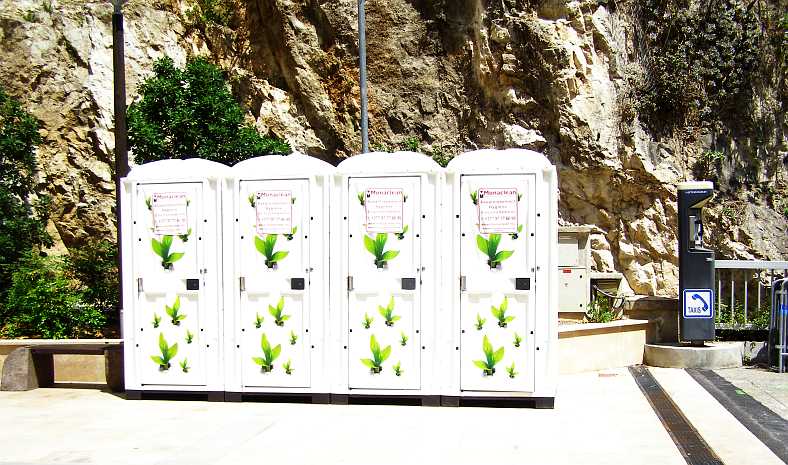
Portable toilets. Every need is catered for here. These were located at a point where an elevator (or was it an escalator? Or both?) took people to an exit from the endless tunnels.
After a spirited meeting with Barry and one of his friends I returned to my place in the stands for the Formula Junior racing. This was all part of a round-the-world Formula Junior series being held in 2016 and 2017 and the races at Monaco were for the front-engined cars only. Of course, with 1960 being the year that Formula One started to be dominated by rear-engined cars this meant that very few of them were from later than 1960.

Five at Tabac. There are five cars here, so I’m tempted to think I took this on their warm-up lap, they don’t appear to be at racing speeds either.
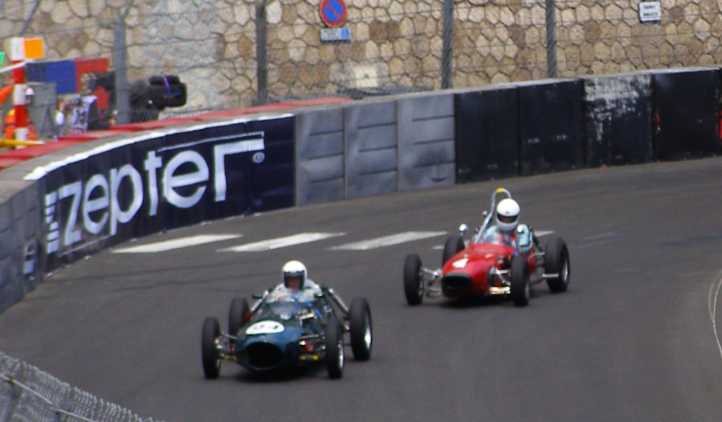
Racing speed. These do appear to be at racing speed. There was a great variety of cars in the field which showed truly International backgrounds.

Follow the leader. A rear view as they entered the Swimming Pool section, I can’t identify the cars but I think the ones nearest are Lolas.
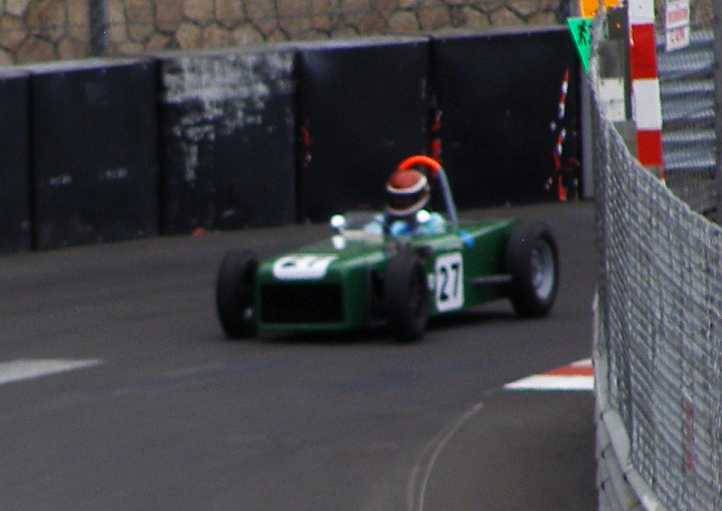
Ray Mallock. This is the one that took many by surprise, in 2016 as well as in 1961. The Mallock built and raced by Arthur Mallock with a split Ford front beam axle that typified his U2 cars through much of the sixties. Driven here by Ray Mallock, it came home in third place.
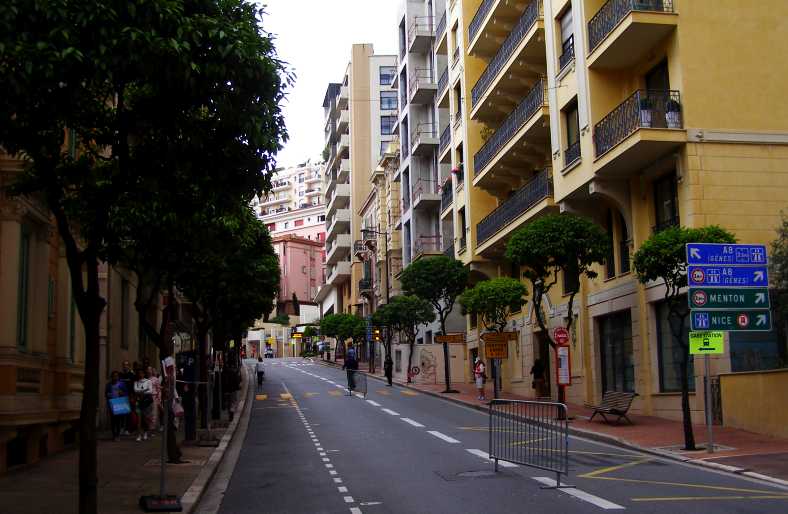
Walking out. Ultimately it was time for me to leave and see if I could find my wife. I was hoping, of course, that she’d had a good day on the Italian coastline.
The train ride was a blur through the rugged coastal scenery, tunnels, little towns, coastline.
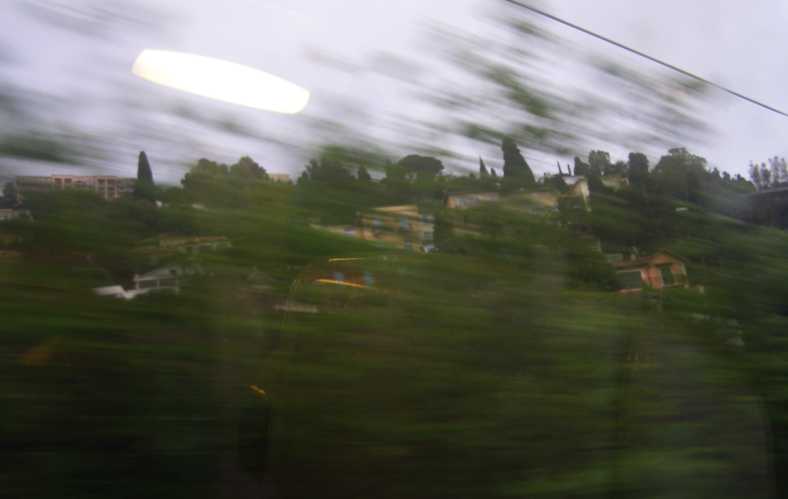
Blurred train ride. Public transport is good in much of Europe and electric trains speed people all over the place no matter what the terrain.
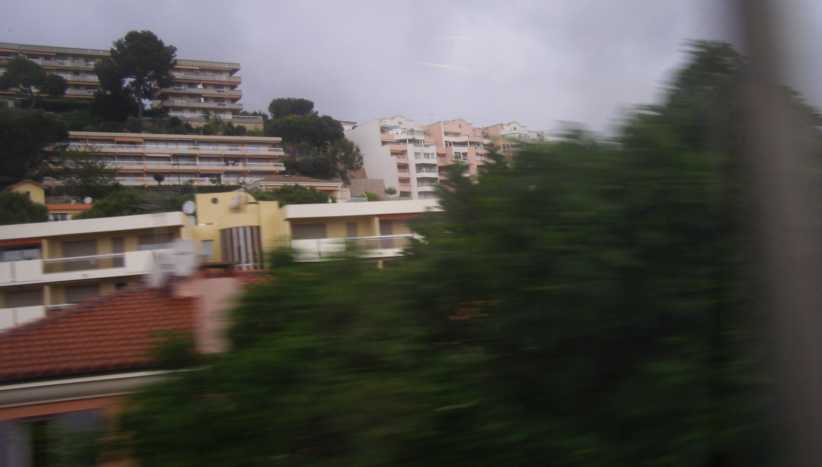
High Rise. Everywhere there is high rise living, my ride to Ventimiglia didn’t take long.
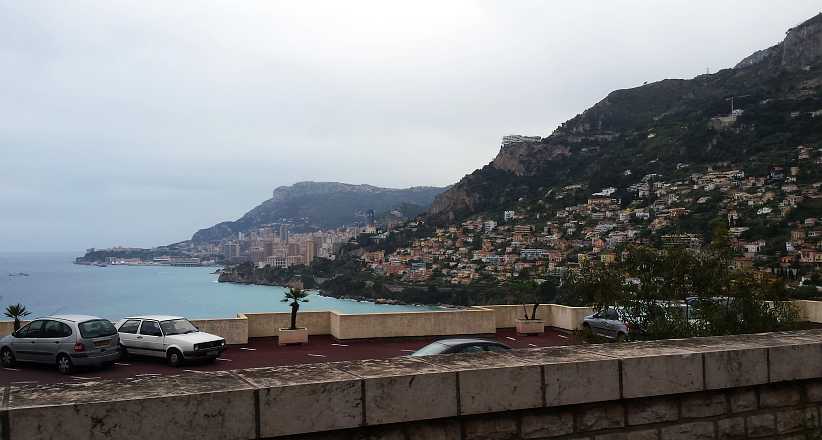
Sandra’s coastline. Being keen on the water it was natural that Sandra would spend much of the day looking over the Mediterranean.

Yachts and stones. So different to home. The yachts out there in the breezes and the stones on the beach, our beaches are sand! The waves breaking over the rocks would eventually cover them as the tide came in.
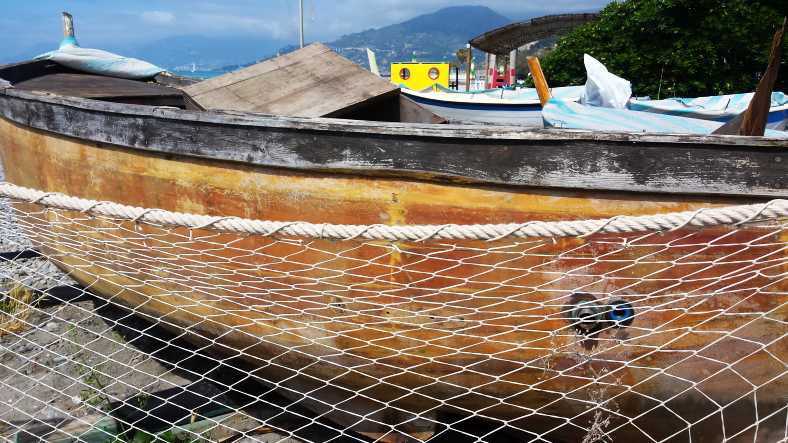
Boats. I guess these are fishing boats, small scale of course. There was lots for her to explore.
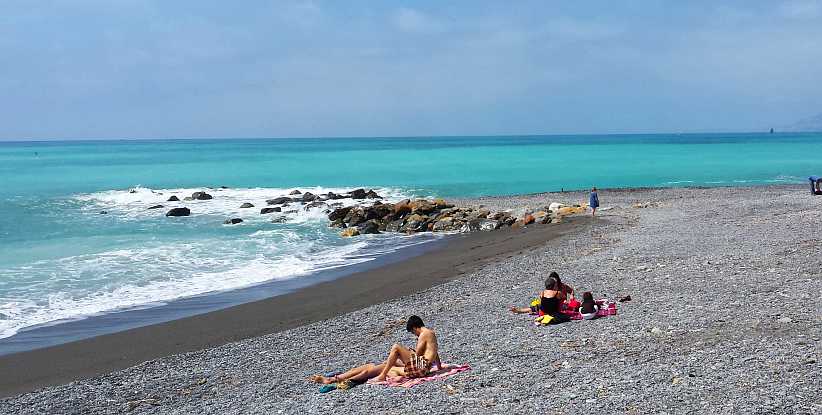
People on the beach. Again, the stones of the beach were very foreign to us, but these people found them to be quite normal.
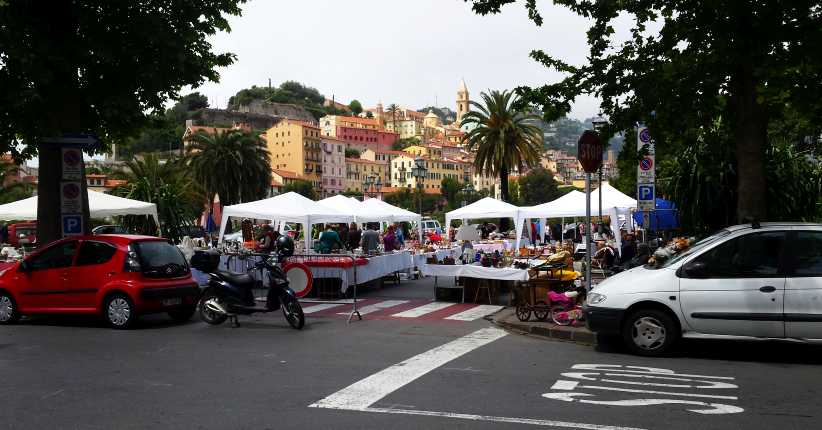
Market. This market sprung up in a street closed for the occasion. This was just across from our hotel in Ventimiglia.
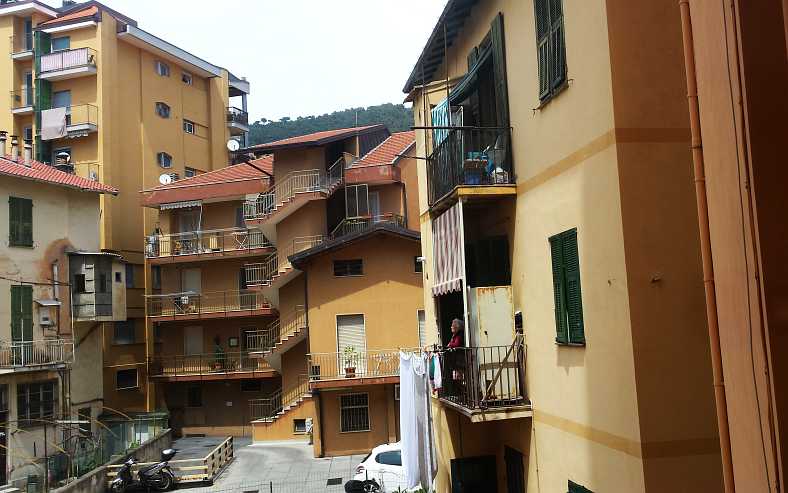
More high rise. Sandra captures a piece of urban Italy here, lots of people are very much used to this kind of living.

Hotel lobby. A snap of the fixtures and fittings in the lobby of our hotel.
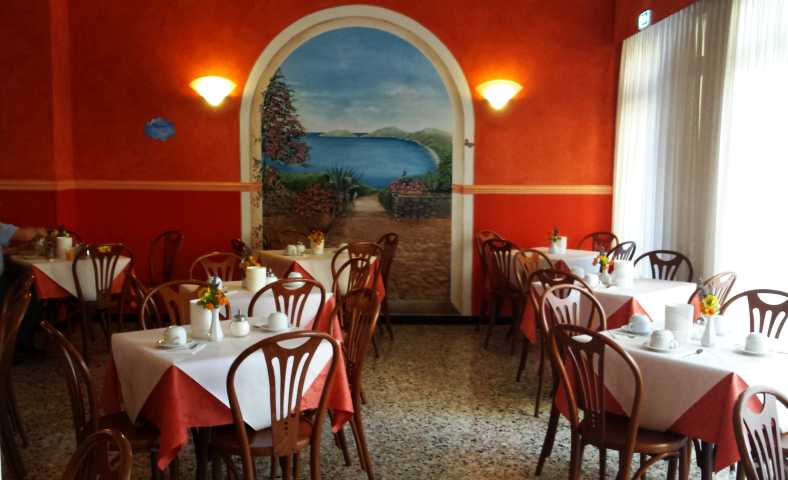
Mural. The mural in the dining room is virtually what you see if you walk down the end of the street from the hotel.
It was after I returned that I really upset Sandra. We needed to find something to eat and with my allergy it was difficult to go anywhere. And we were mindful of the cost. We finished up at a little restaurant which did take-away and ordered some fish and chips, something we would easily do at home. Having placed the order and been told it would be fifteen minutes, we went for a walk.
On our return we were told they hadn’t prepared our order because we left the shop. So we sat around (stood around, actually) for another fifteen minutes and then I couldn’t believe my eyes when it was delivered to us.
One huge onion, ready to ooze its worst, was on top of the food! I lost my temper here as this was just not possible, they then removed the onion and we left the shop. Having not had any lunch I was starving, too.
But Sandra wouldn’t eat any of it, she was so upset with the way I’d reacted to this corruption of my meal and didn’t want to talk to me either. No apology was sufficient, no explanation got the message to her, I’d been rude to these people and that was all there was to it.
I went back in to apologise, but I don’t think that calmed things down much either. It was a tenuous peace as we returned to the hotel room to get some sleep. The next day things just had to get better…
Spectating at Monaco is not as one might expect at a normal racing circuit. At this place one has to buy a ticket to one area (usually a grandstand built up in the weeks before the event) and that’s where you watch from for the day. Or the weekend.
Of course, you are free to wander around the streets and alleys, but you won’t see anything other than a brief blur of colour as a car flashes by. And you can’t use your ticket to go to another viewing area, if you want to spend part of the day somewhere else it means buying another ticket. And they aren’t cheap.
Here’s the circuit map:

The ‘Wings and Slicks’ cars of the 3-litre formula were the first out after I arrived, and I’d stationed myself between the ‘Tabac’ corner and the swimming pool. And then I learned just how impossible my self-focussing camera was in a place like this.
‘Auto-focus’ has to be one of the worst inventions of the past hundred years. No longer can you aim your camera, set the focus (usually on infinity) and press the button. No, not now. The camera hunts around the picture and decides for itself what it’s going to focus on, and usually it changes that at the last instant so you are guaranteed to miss out on getting a fix on whatever it is you’re photographing.
The first few pics are all of cars we didn’t see the day before in the ‘garages’:

UOP Shadows. Don Nicholls and his UOP Shadows were part of the field in the early seventies. The two of them here are in the Tabac corner, the focus has jumped to the fences.

Hill and Penske. Graham Hill and Roger Penske were contemporaries as drivers but only ever competed against one another a small number of times in the early sixties. By the seventies, both were to build their own Formula One cars and here we have the Hill GH2 as raced by Graham and later Tony Brise and the Penske PC3. The PC3 came after Mark Donohue’s untimely death and was raced by John Watson, winning the Austrian Grand Prix.

Surtees and the original Lotus 49. Well the original colours of the Lotus 49. This Surtees, which has suffered terribly from the auto-focus problem, seems to be a TS7, the car ‘Fearless John’ used in 1970.
And the day rolled on. But for some the ride got pretty bumpy, whether that was because of mechanical mayhem or their own failings. As I mentioned, the Lotus 72 was to meet up with a wall, a wall that was pretty well-padded as you can see:

Lotus 72 into the wall. It must be very humiliating for the driver of one of these old cars to have this sort of crash. The car was hauled up onto a tilt-tray which pulled up right in front of where I was watching from but I couldn’t get a decent pic of the damage due to the crowd and the fence and the inevitable auto-focus problem. It looked like the right front suspension suffered a bit of damage with a little bit of disturbance to the aluminium structure ahead of the main chassis monocoque. And the bodywork, of course. One of the most interesting design features of the Lotus 72 was their springing, no coils at all, but a 2-piece concentric torsion bar with rising-rate linkages to the suspension uprights.

March retires. This one looks like a mechanical problem, which is a shame for the team who undoubtedly spent a lot of money and time getting it ready for and getting it to Monaco.
Then out came the cars from the thirties, the sports cars…

Aston and K3. The focus isn’t quite so bad with this one but the delay of the shutter after pressing the button means the Aston Martin has gone into partial obscurity! These were cars Sandra had photographed the previous day and so they are a part of the post before the previous one. The cover over the crankshaft-driven blower on the MG K3 doesn’t look original to me, by the way.
All of this was surrounded by the glitz of Monaco, with people up on high balconies and on the boats in the harbour watching on as they, no doubt, sipped champagne to wash down their caviar.

Spectators. It wasn’t just those in the stands watching on, but dwellers in the high-rise and those on boats were watching too. Of note to me was the array of electronics on board those yachts, great domes to receive satellite transmissions of television and, no doubt, phones.
At this point I decided it was time to take a walk to meet up with Barry Boor, a friend from the Atlas F1 Nostalgia forum. Barry had been living in Malta but had recently returned to live in England and I would be visiting him again a few weeks down the track.
So I set off with phone in hand to call him for directions (he was viewing somewhere near the Mirabeau section) and tried to navigate my way around the blocked-off streets to find him. Of course, I went into some of the many tunnels, these led to the station, to carparks and elsewhere. It was a long and wearing walk, but I did see some interesting stuff along the way…

The Mini Mini. Americans aren’t the only ones who do oddball things with cars, this was parked somewhere near the Casino area and had a sticker on the windscreen which read: “Micro Bolid” 2.17m – 140km/h La plus petite voiture thermique au monde.” Maybe it’s good for parking, but I don’t think I’d like to be trying to keep it in a straight line at 140kmh!

Formula Renault. In one place along the way there was this Formula Renault car, which features a 2-litre engine. It’s a popular category in Southern Europe and many aspiring Formula One driver go into it hoping to be ‘noticed’ by the big teams.

{b]Monaco view. Sometimes during my walk I could see over the Principality, this view of the harbour showing how everything is crammed into the available space and how builders have gone onto every nook and cranny to find somewhere to put another apartment block. Not to mention the boats.

Portable toilets. Every need is catered for here. These were located at a point where an elevator (or was it an escalator? Or both?) took people to an exit from the endless tunnels.
After a spirited meeting with Barry and one of his friends I returned to my place in the stands for the Formula Junior racing. This was all part of a round-the-world Formula Junior series being held in 2016 and 2017 and the races at Monaco were for the front-engined cars only. Of course, with 1960 being the year that Formula One started to be dominated by rear-engined cars this meant that very few of them were from later than 1960.

Five at Tabac. There are five cars here, so I’m tempted to think I took this on their warm-up lap, they don’t appear to be at racing speeds either.

Racing speed. These do appear to be at racing speed. There was a great variety of cars in the field which showed truly International backgrounds.

Follow the leader. A rear view as they entered the Swimming Pool section, I can’t identify the cars but I think the ones nearest are Lolas.

Ray Mallock. This is the one that took many by surprise, in 2016 as well as in 1961. The Mallock built and raced by Arthur Mallock with a split Ford front beam axle that typified his U2 cars through much of the sixties. Driven here by Ray Mallock, it came home in third place.

Walking out. Ultimately it was time for me to leave and see if I could find my wife. I was hoping, of course, that she’d had a good day on the Italian coastline.
The train ride was a blur through the rugged coastal scenery, tunnels, little towns, coastline.

Blurred train ride. Public transport is good in much of Europe and electric trains speed people all over the place no matter what the terrain.

High Rise. Everywhere there is high rise living, my ride to Ventimiglia didn’t take long.

Sandra’s coastline. Being keen on the water it was natural that Sandra would spend much of the day looking over the Mediterranean.

Yachts and stones. So different to home. The yachts out there in the breezes and the stones on the beach, our beaches are sand! The waves breaking over the rocks would eventually cover them as the tide came in.

Boats. I guess these are fishing boats, small scale of course. There was lots for her to explore.

People on the beach. Again, the stones of the beach were very foreign to us, but these people found them to be quite normal.

Market. This market sprung up in a street closed for the occasion. This was just across from our hotel in Ventimiglia.

More high rise. Sandra captures a piece of urban Italy here, lots of people are very much used to this kind of living.

Hotel lobby. A snap of the fixtures and fittings in the lobby of our hotel.

Mural. The mural in the dining room is virtually what you see if you walk down the end of the street from the hotel.
It was after I returned that I really upset Sandra. We needed to find something to eat and with my allergy it was difficult to go anywhere. And we were mindful of the cost. We finished up at a little restaurant which did take-away and ordered some fish and chips, something we would easily do at home. Having placed the order and been told it would be fifteen minutes, we went for a walk.
On our return we were told they hadn’t prepared our order because we left the shop. So we sat around (stood around, actually) for another fifteen minutes and then I couldn’t believe my eyes when it was delivered to us.
One huge onion, ready to ooze its worst, was on top of the food! I lost my temper here as this was just not possible, they then removed the onion and we left the shop. Having not had any lunch I was starving, too.
But Sandra wouldn’t eat any of it, she was so upset with the way I’d reacted to this corruption of my meal and didn’t want to talk to me either. No apology was sufficient, no explanation got the message to her, I’d been rude to these people and that was all there was to it.
I went back in to apologise, but I don’t think that calmed things down much either. It was a tenuous peace as we returned to the hotel room to get some sleep. The next day things just had to get better…
Last edited by Ray Bell; 03-27-2023 at 05:56 AM.
#186
After a difficult night it was planned to get towards Rome on our way to Siderno – right down the Southern end of Italy. I was banking on making that a two and a half day drive, enabling us to catch up with some people in Genoa on the first morning, take in the Leaning Tower of Pisa that afternoon, then to see a couple of sights around Rome and Naples on the next day, Monday May 16, then to arrive at Siderno during the afternoon of Tuesday.
The map to Pisa…
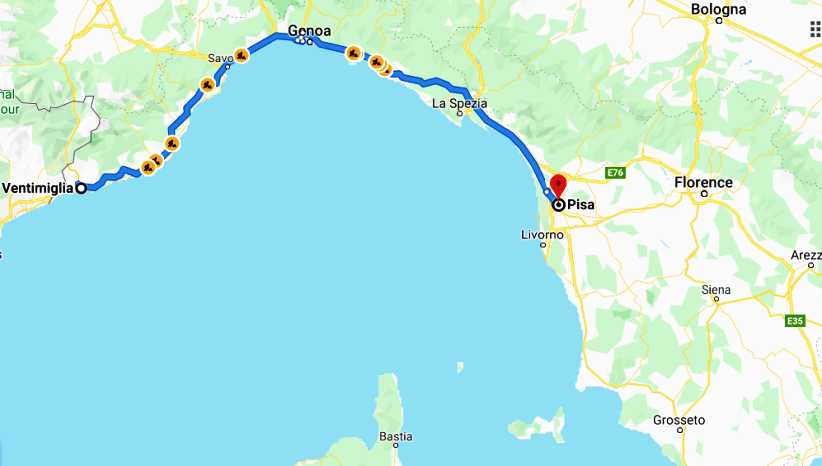
...is simple enough. The area we were leaving was, like Monaco, crammed near cliffs…

Cliff scenery. Like other parts of the Riviera, just over the border, Ventimigilia is situated between the sea and the cliffs.
...and crowded in the European fashion…
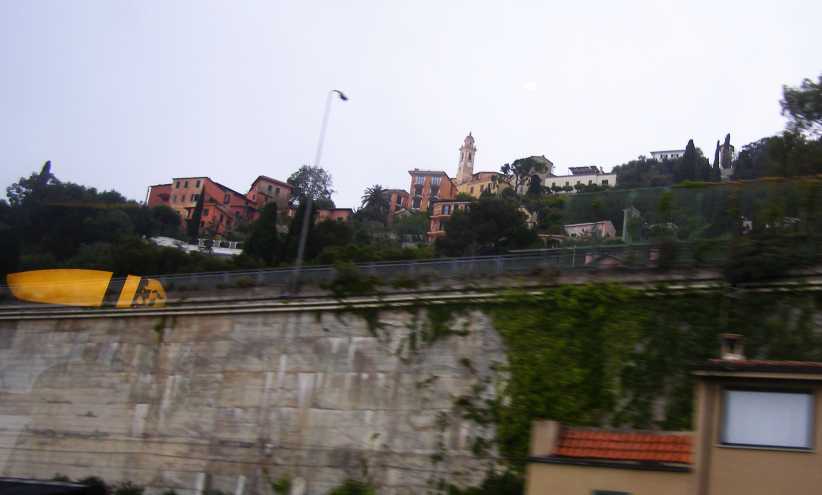
Crowded. Ever upward go the buildings in which people live here. Lots of them.
...and served these days by toll roads which often have to be raised up into the sky to find room to breathe:

Motorway. High above the city the motorway enables large numbers of people to travel without adding to the chaos at ground level.
But before we leave Ventimiglia we had a discussion about the new Fiat 500s after Sandra said they were cute. I wanted to show her that they were, like the BMW-made Mini, a bigger version of something from the past. Hence I took these pics:
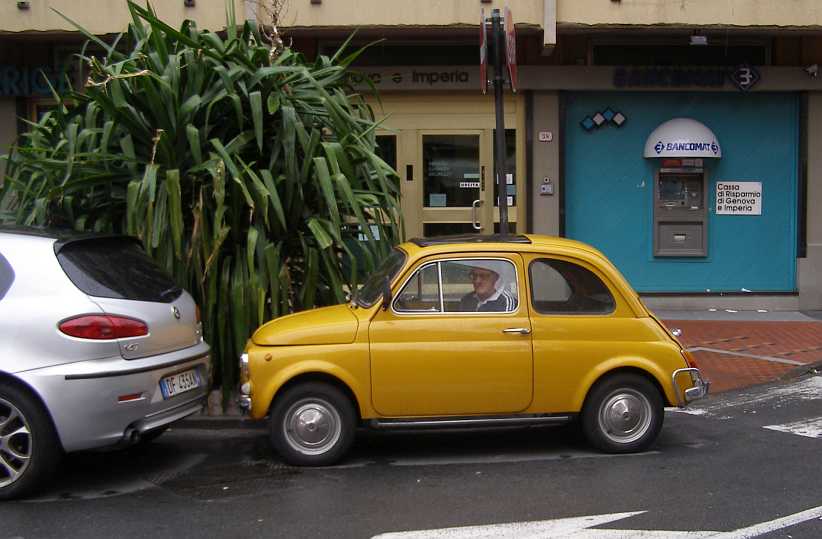
Fiat 500. A nice example of the old-style Fiat 500. These had an air-cooled 2-cylinder 500cc engine in the back.
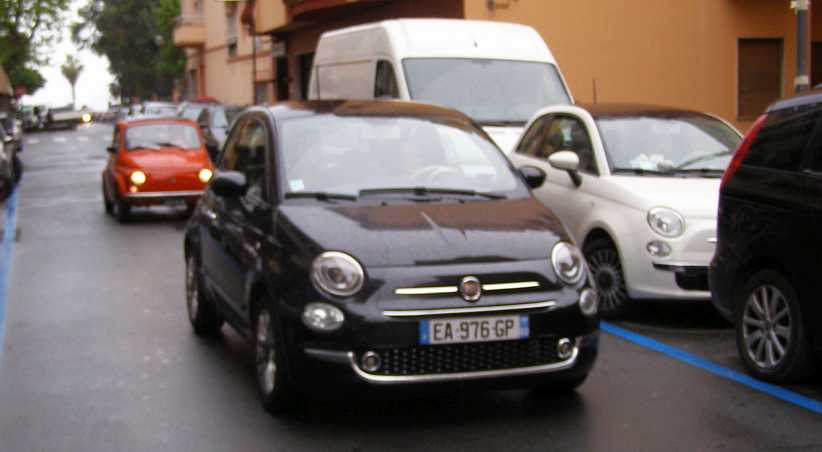
Fiat 500s. I thought this a unique opportunity for a shot. A modern Fiat 500, which sports a 1.4-litre engine with over 100bhp, and a fifties/sixties model behind it.
Genoa was also a congested place, but without so much evidence of wealth as we’d seen at Monaco or even Ventimiglia. Or was it just that the area into which we went was a bit down and out?
When we reached Pisa, however, the Sunday afternoon was in full swing and there were tourists everywhere. And people out to make money from them too. The tower itself surprised me with its size, it was much smaller than I’d imagined. And its purpose (when built) seems only to have provide a belfry for the cathedral (or church) some distance away.
We joined the throngs looking around, anyway. Which made for a break from the more mundane things of the trip. Like finding food I could eat, buying fuel for the Peugeot – with so many places being unmanned and us having cards which didn’t work there – and so on. Oh, and Sandra was having fun counting the tunnels the toll roads carried us through.

Pisa laneway. As we walked from our parking spot we could see the leaning tower through this laneway. As everywhere, crowded with people, both locals and tourists.
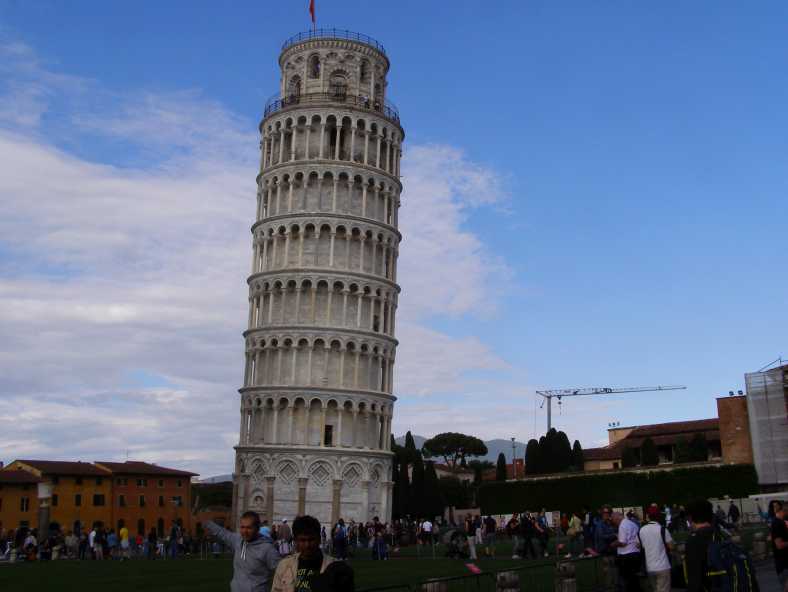
The Leaning Tower. I think this photo shows it to be smaller than most shots, with the people in the pic to help give some reference to scale.
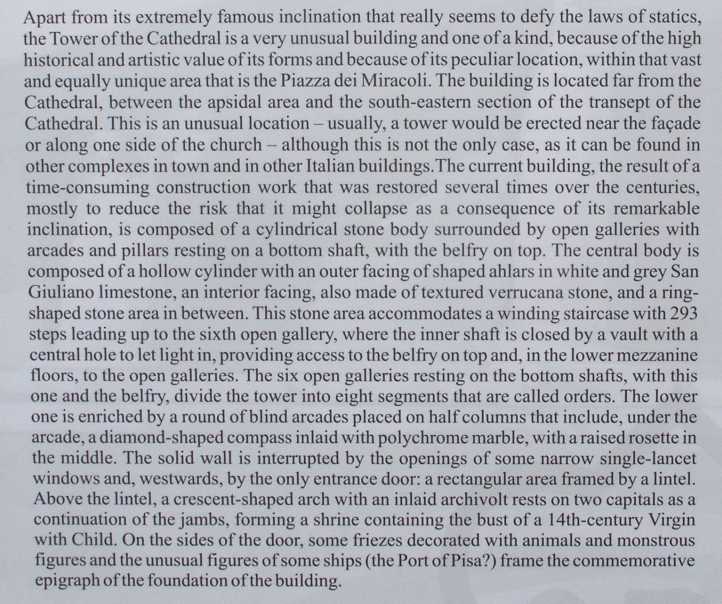
Explanation. No, not about why it’s on a lean, but what the tower is built of and other features.
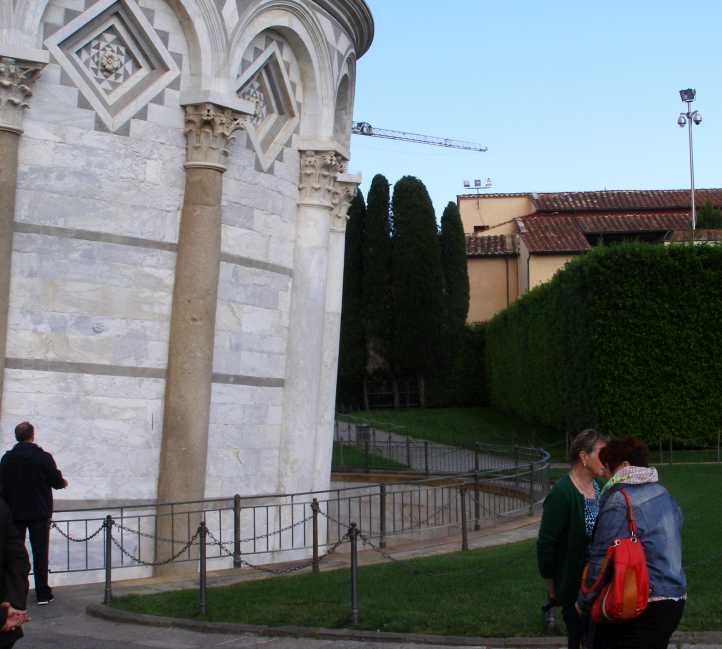
Lean evident. Close up at the base, the amount of lean is very much apparent.
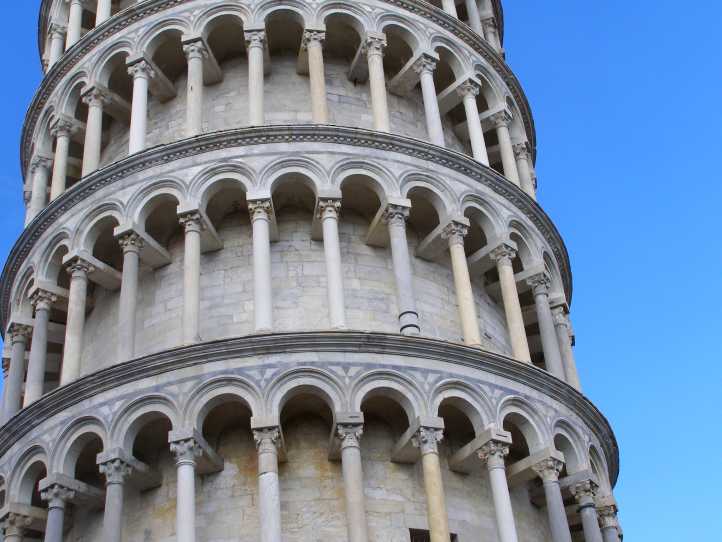
Up the tower. It was from nearer the top that da Vinci did his famous comparison test, but this pic shows the main feature of the many levels, the outer balconies with their supporting columns.
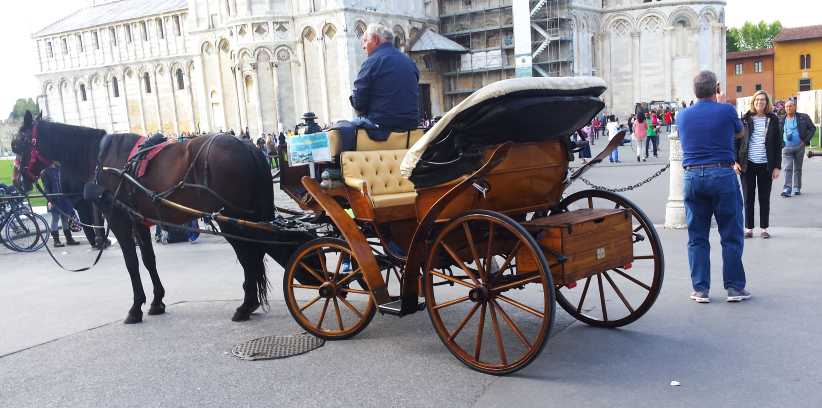
Carriages. Anywhere there’s horses, Sandra is keen to get a picture. Tourists were offered rides in this carriage – for a price.

And other tourist trappings. In the background to this one you can see a sign, ‘CHANGE’. Catering for the tourists who hadn’t yet exchanged their cash.
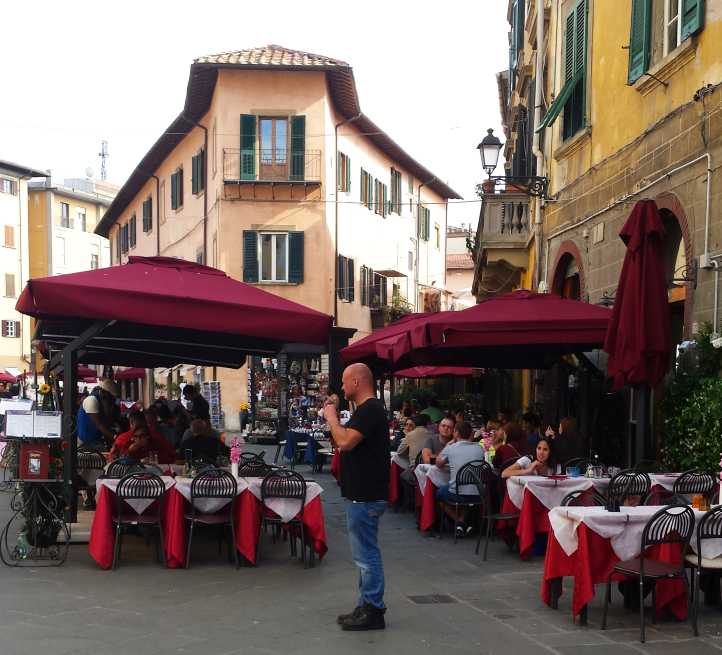
Outdoor restaurant. Doing a good trade, this restaurant was a couple of hundred metres from the tower. It’s very much a part of Pisa in tourist season, I’d think.
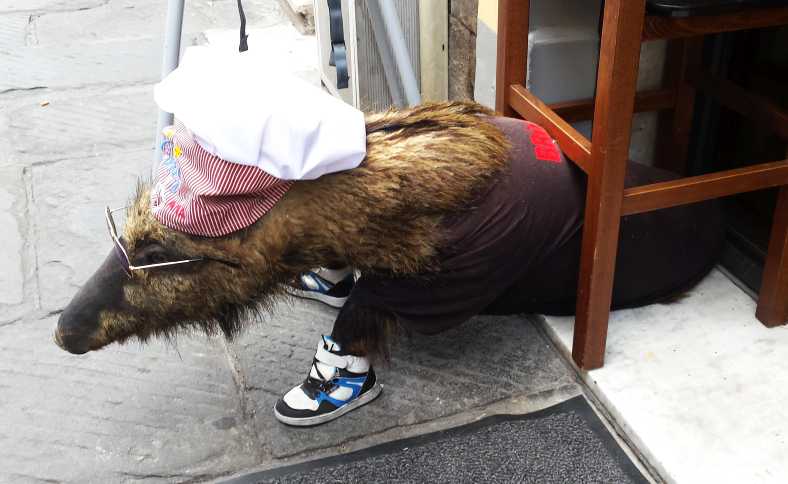
Dressed pig. No, not dressed to eat. Another foible for Sandra to capture in pixels. Not my cup of tea.
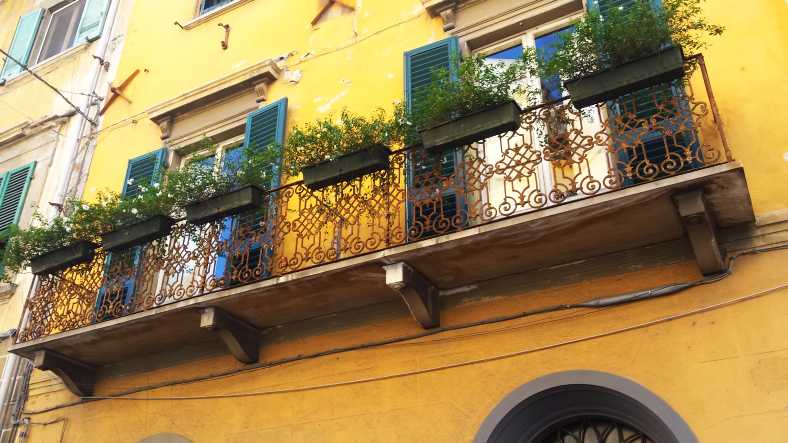
Flowers on the wall. Still keen on getting shots of the flowers, Sandra also snapped this, a part of everyday Pisa.
On leaving Pisa I don’t know what path we actually took. We headed in the general direction of Rome, and not on motorways, which had carried us most of the 325kms we’d covered to Pisa, including more than a hundred tunnels ranging from about 100m to 1.5kms. No more of that this afternoon, we were out on the roads of everyday Italy following the GPS, covering perhaps 150kms in the balance of the day...
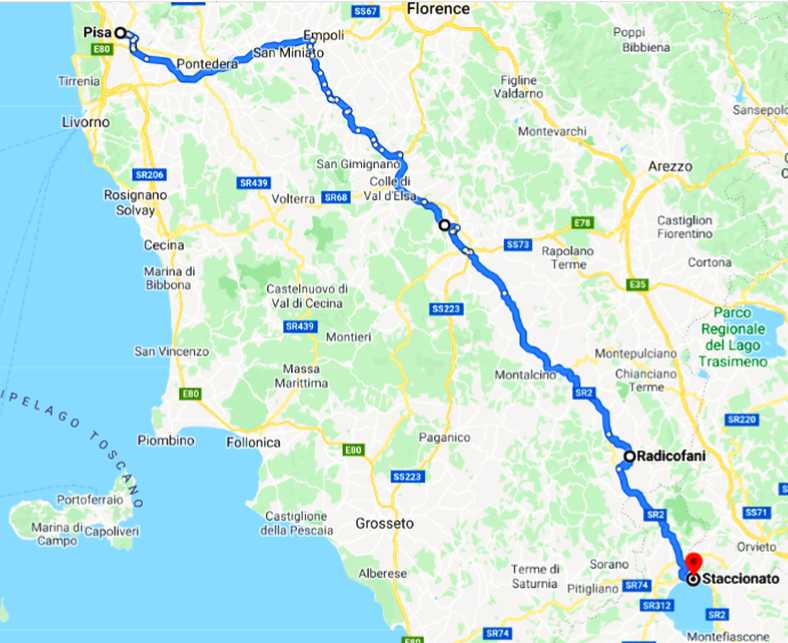
...with this map being an approximation of the drive, the only sure point being that we went past the fort at Radicofani and we drove far enough after that to be travelling pretty late, with our night time stop being near Bolsena.
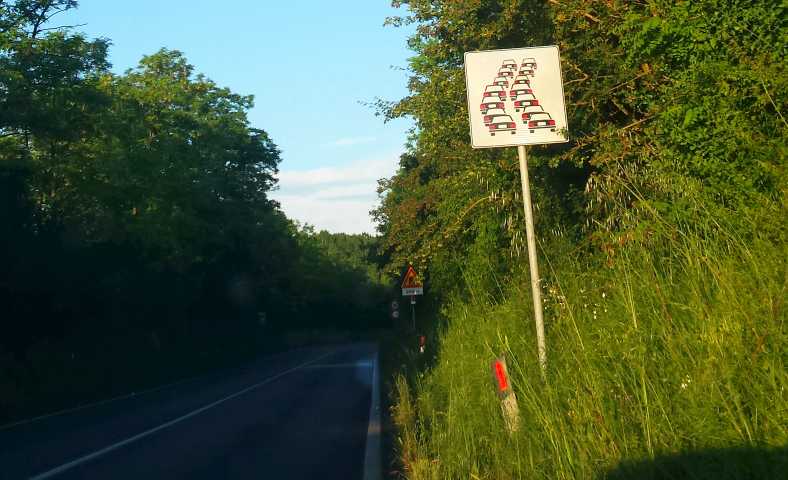
Warning sign. The sign depicts queues of traffic stopped at roadworks. We didn’t actually encounter anything like that, but it was a Sunday.
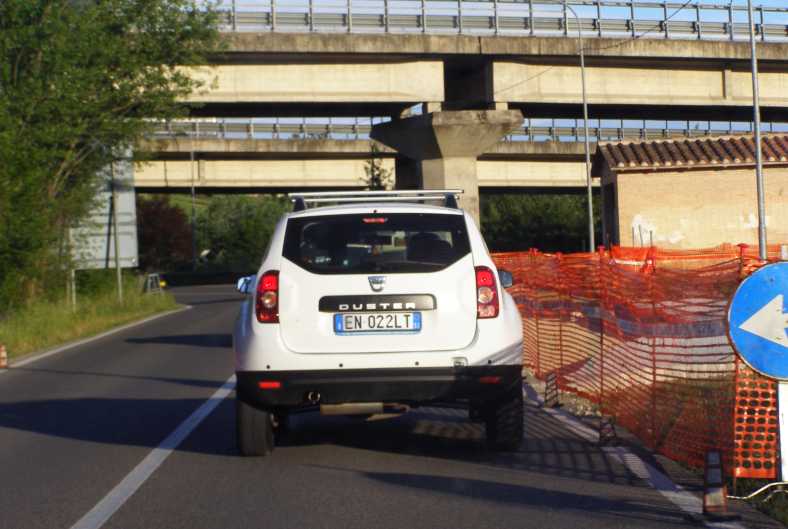
Duster and roadworks. The ‘Duster’ name used to be a Plymouth model, now it’s on these Dacias. The ‘Dacia’ name is from Romania, the Duster is a joint effort between Renault and the Romanian maker.

Old fort in the distance. In the distance we spotted, and could see for some time, this old fort. It's at Radicofani in Tuscany.
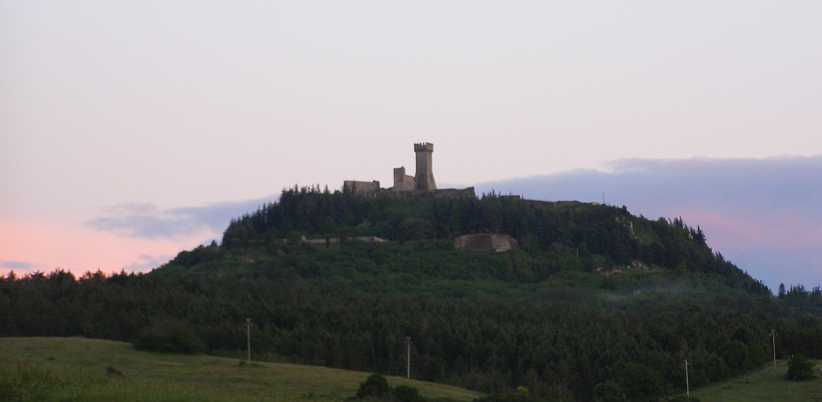
Italian Fort A closer look at the fort on its commanding hilltop location.

Hillside view. Still the countryside rolled by, giving us plenty to look at as we drove.
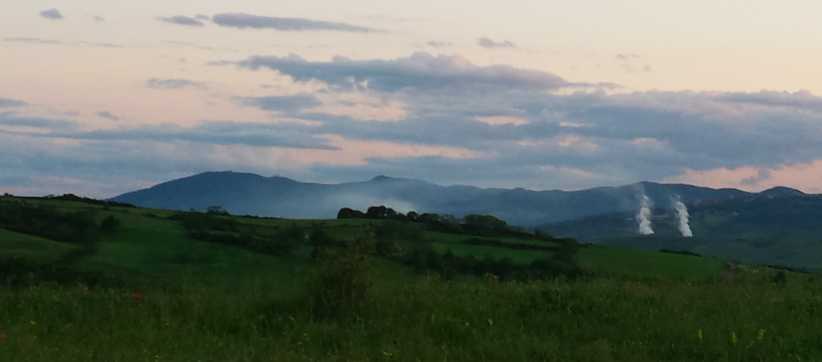
Smoke too. The smoke in this shot is a bit of an unknown, but still a part of the scenery on this late Italian afternoon.
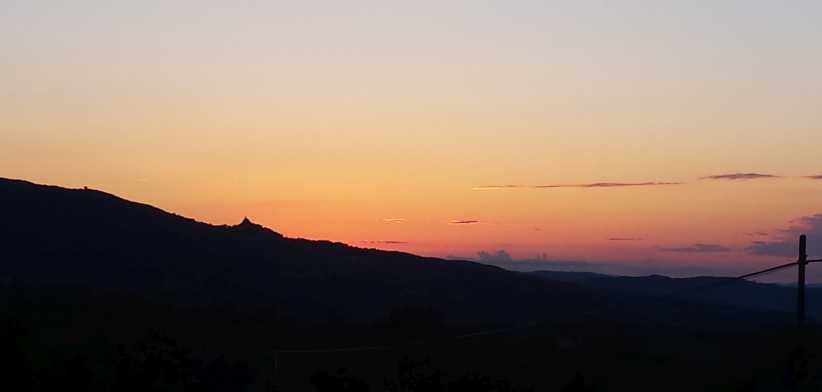
Late. Yes, I said ‘late’… the colours of the sunset reminded us it was time to look for somewhere to stay. Little did we know what trouble that would give us.
And when darkness came we were in a lot of trouble finding somewhere to stay. One little town into which we drove had nowhere at all, and nobody who spoke English who could give us a guide. We were quite despondent about this, Sandra’s back was in a lot of pain and it was stressful to both of us.
Then we found a little place along a quiet road. We went in, they spoke English, they had rooms, they would cook us a meal and it was affordable. Lovely people, a very nice place, It was, even though we couldn't see the lake, on the shores of Lago Bolsena, only a short distance before the town of Bolsena. Called 'La Fraschetta', it was out in agricultural country by itself.
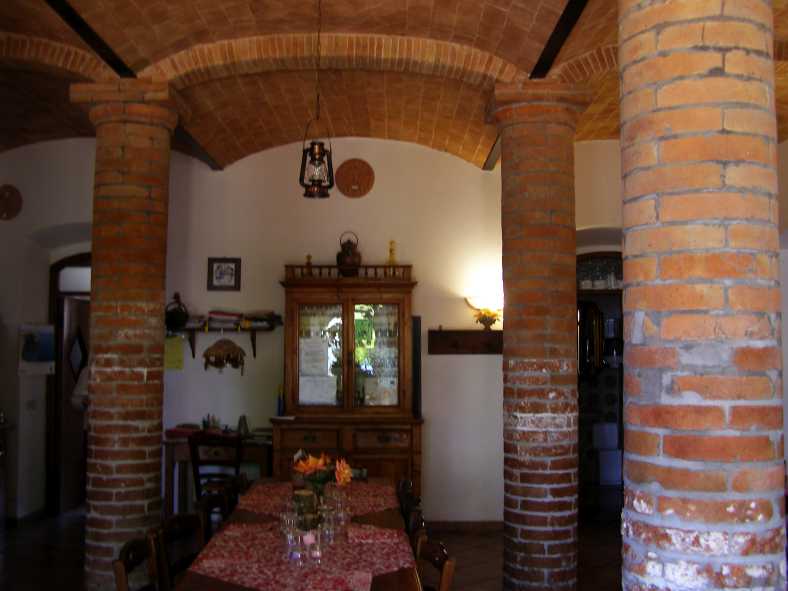
Restaurant. This was the dining room at the little place we found, a pure delight which befell us when we needed it most.

Bed time. And a very welcoming bed so Sandra could stretch out and give her back a bit of a break after a full day on the road.
As was becoming the norm, I went to sleep hoping the next day would be more straightforward and pleasurable. Not that I wasn’t enjoying things overall, but the moments of the many problematic incidents were weighing on both of us. I guess we weren’t well enough prepared.
The map to Pisa…

...is simple enough. The area we were leaving was, like Monaco, crammed near cliffs…

Cliff scenery. Like other parts of the Riviera, just over the border, Ventimigilia is situated between the sea and the cliffs.
...and crowded in the European fashion…

Crowded. Ever upward go the buildings in which people live here. Lots of them.
...and served these days by toll roads which often have to be raised up into the sky to find room to breathe:

Motorway. High above the city the motorway enables large numbers of people to travel without adding to the chaos at ground level.
But before we leave Ventimiglia we had a discussion about the new Fiat 500s after Sandra said they were cute. I wanted to show her that they were, like the BMW-made Mini, a bigger version of something from the past. Hence I took these pics:

Fiat 500. A nice example of the old-style Fiat 500. These had an air-cooled 2-cylinder 500cc engine in the back.

Fiat 500s. I thought this a unique opportunity for a shot. A modern Fiat 500, which sports a 1.4-litre engine with over 100bhp, and a fifties/sixties model behind it.
Genoa was also a congested place, but without so much evidence of wealth as we’d seen at Monaco or even Ventimiglia. Or was it just that the area into which we went was a bit down and out?
When we reached Pisa, however, the Sunday afternoon was in full swing and there were tourists everywhere. And people out to make money from them too. The tower itself surprised me with its size, it was much smaller than I’d imagined. And its purpose (when built) seems only to have provide a belfry for the cathedral (or church) some distance away.
We joined the throngs looking around, anyway. Which made for a break from the more mundane things of the trip. Like finding food I could eat, buying fuel for the Peugeot – with so many places being unmanned and us having cards which didn’t work there – and so on. Oh, and Sandra was having fun counting the tunnels the toll roads carried us through.

Pisa laneway. As we walked from our parking spot we could see the leaning tower through this laneway. As everywhere, crowded with people, both locals and tourists.

The Leaning Tower. I think this photo shows it to be smaller than most shots, with the people in the pic to help give some reference to scale.

Explanation. No, not about why it’s on a lean, but what the tower is built of and other features.

Lean evident. Close up at the base, the amount of lean is very much apparent.

Up the tower. It was from nearer the top that da Vinci did his famous comparison test, but this pic shows the main feature of the many levels, the outer balconies with their supporting columns.

Carriages. Anywhere there’s horses, Sandra is keen to get a picture. Tourists were offered rides in this carriage – for a price.

And other tourist trappings. In the background to this one you can see a sign, ‘CHANGE’. Catering for the tourists who hadn’t yet exchanged their cash.

Outdoor restaurant. Doing a good trade, this restaurant was a couple of hundred metres from the tower. It’s very much a part of Pisa in tourist season, I’d think.

Dressed pig. No, not dressed to eat. Another foible for Sandra to capture in pixels. Not my cup of tea.

Flowers on the wall. Still keen on getting shots of the flowers, Sandra also snapped this, a part of everyday Pisa.
On leaving Pisa I don’t know what path we actually took. We headed in the general direction of Rome, and not on motorways, which had carried us most of the 325kms we’d covered to Pisa, including more than a hundred tunnels ranging from about 100m to 1.5kms. No more of that this afternoon, we were out on the roads of everyday Italy following the GPS, covering perhaps 150kms in the balance of the day...

...with this map being an approximation of the drive, the only sure point being that we went past the fort at Radicofani and we drove far enough after that to be travelling pretty late, with our night time stop being near Bolsena.

Warning sign. The sign depicts queues of traffic stopped at roadworks. We didn’t actually encounter anything like that, but it was a Sunday.

Duster and roadworks. The ‘Duster’ name used to be a Plymouth model, now it’s on these Dacias. The ‘Dacia’ name is from Romania, the Duster is a joint effort between Renault and the Romanian maker.

Old fort in the distance. In the distance we spotted, and could see for some time, this old fort. It's at Radicofani in Tuscany.

Italian Fort A closer look at the fort on its commanding hilltop location.

Hillside view. Still the countryside rolled by, giving us plenty to look at as we drove.

Smoke too. The smoke in this shot is a bit of an unknown, but still a part of the scenery on this late Italian afternoon.

Late. Yes, I said ‘late’… the colours of the sunset reminded us it was time to look for somewhere to stay. Little did we know what trouble that would give us.
And when darkness came we were in a lot of trouble finding somewhere to stay. One little town into which we drove had nowhere at all, and nobody who spoke English who could give us a guide. We were quite despondent about this, Sandra’s back was in a lot of pain and it was stressful to both of us.
Then we found a little place along a quiet road. We went in, they spoke English, they had rooms, they would cook us a meal and it was affordable. Lovely people, a very nice place, It was, even though we couldn't see the lake, on the shores of Lago Bolsena, only a short distance before the town of Bolsena. Called 'La Fraschetta', it was out in agricultural country by itself.

Restaurant. This was the dining room at the little place we found, a pure delight which befell us when we needed it most.

Bed time. And a very welcoming bed so Sandra could stretch out and give her back a bit of a break after a full day on the road.
As was becoming the norm, I went to sleep hoping the next day would be more straightforward and pleasurable. Not that I wasn’t enjoying things overall, but the moments of the many problematic incidents were weighing on both of us. I guess we weren’t well enough prepared.
Last edited by Ray Bell; 03-01-2020 at 04:30 AM. Reason: Additional detail
#187
The fresh morning brought fresh hope for easy travelling and lots of sightseeing. I was pretty keen to show my new wife the Colosseum in Rome, which I’d seen in 1981, and to go to Naples because during that earlier trip I’d been told how beautiful the place was.
After setting out from our accommodation alongside Lago Bolseno, here’s the approximate route from Rome to Naples and to the likely point where we were to spend the next night. That was May 16, 2016 and, yes, finding somewhere to stay was again a ‘find it in the dark when you don’t speak the local language’ proposition.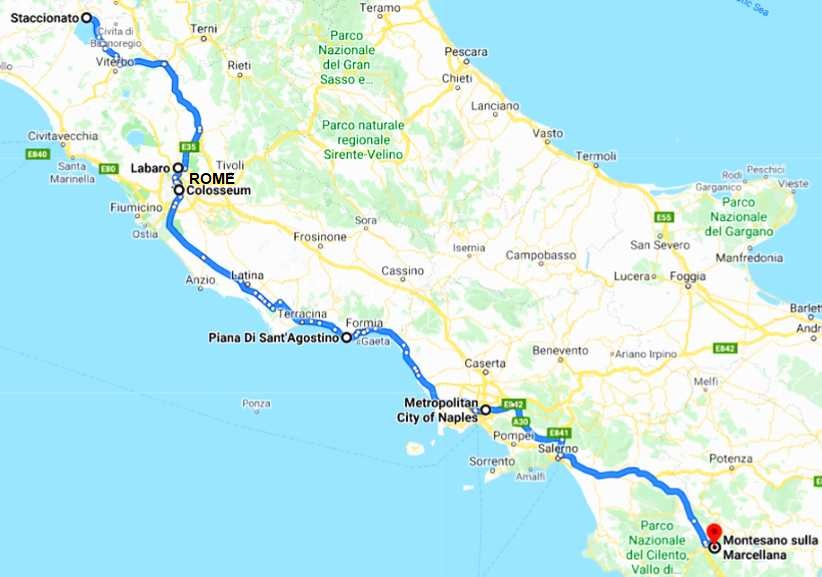
In the morning we were able to get a good look at the place where we stayed…
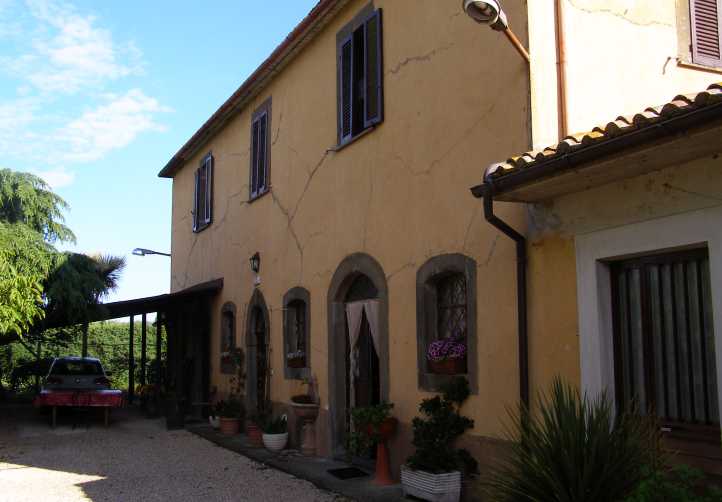
The restaurant. Lovely people run this little country restaurant and accommodation business, it was a nice place to stay and a nice place to dine.
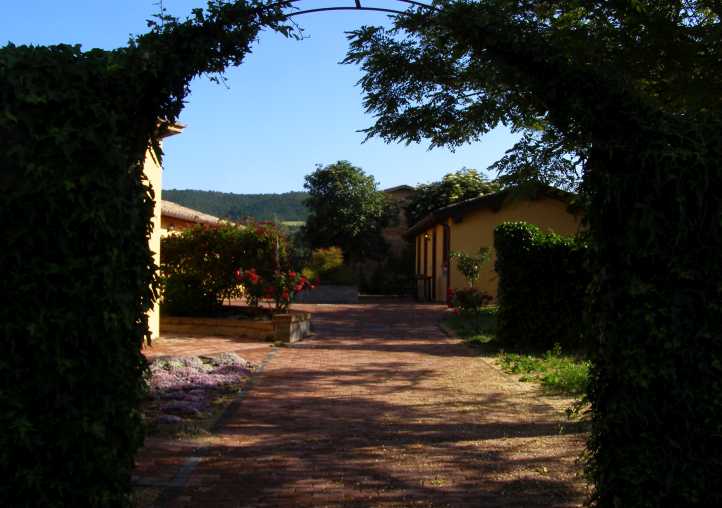
The gateway. Here’s the part that caught me out. The gateway to the accommodation area was a little narrow, but I thought I could squeeze the 208 through there. Scratches to the door were the result.
Yes, confession time again. I made the big mistake of thinking I could drive through but learned there was steel in there where I thought there was plenty of soft leaves. What a nice place, though.
After breakfast we drove on. We dallied around a bit North of Rome looking at different things and Sandra got these pics of sheep grazing…
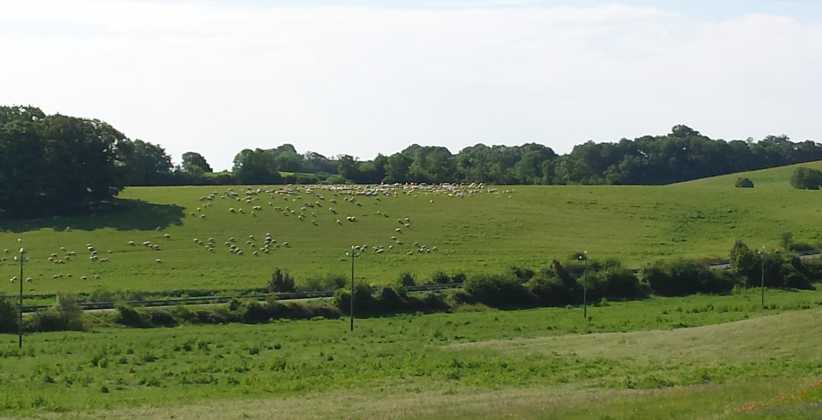
Sheep in the meadow. The countryside was green and seeing sheep grazing probably reminded Sandra of home.
… and wildflowers:
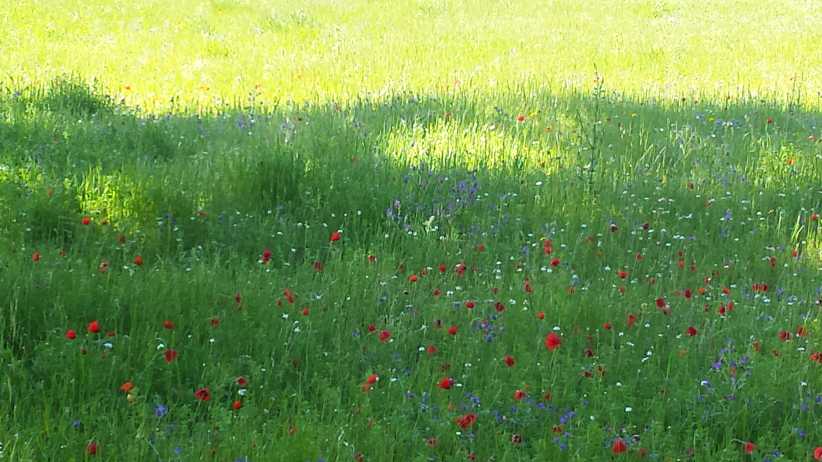
Wildflowers. The flower-loving gardener in her came out many times during the trip. Except in Cordoba, of course.
Then, with the course set on the onboard GPS to take us to the Colosseum we got into Rome. Turning wherever the device told us to, left or right, we started to see some signs of ancient stuff as we headed down Via Nomentano towards the Museo Storica dei Bersaglieri, opposite the end of this street:
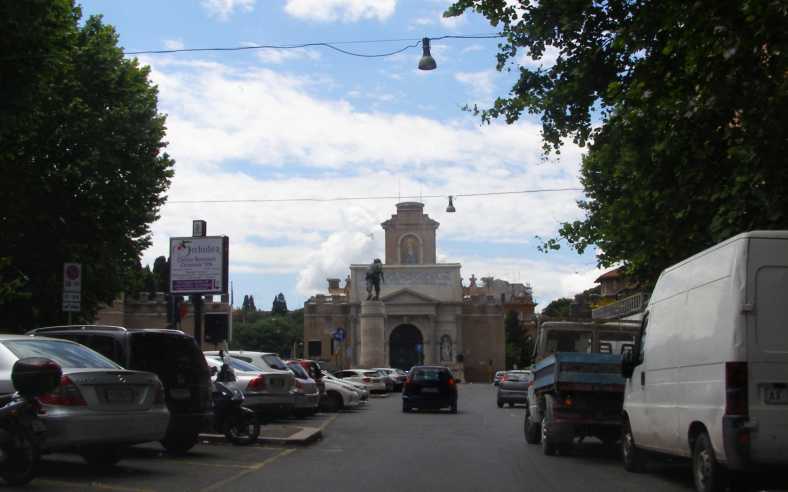
Via Nomentano. This looked like we were heading for something historic, but it turned out to be not as ancient as expected.
‘Bersaglieri’, it turns out, was an infantry battalion of the early 1800s. But still there’s a statue, possibly a typical battalion member, evident on the tall marble base at the end of this street.

Old and New. The Italians mix the old and the new very well. This wall butts up to the Museo Storica and hides a number of more modern buildings, among them the British Embassy.
Still following the trusted instructions, we turned left here and in time found ourselves at the intersection of Via Cavour and Via Degli Annibaldi…
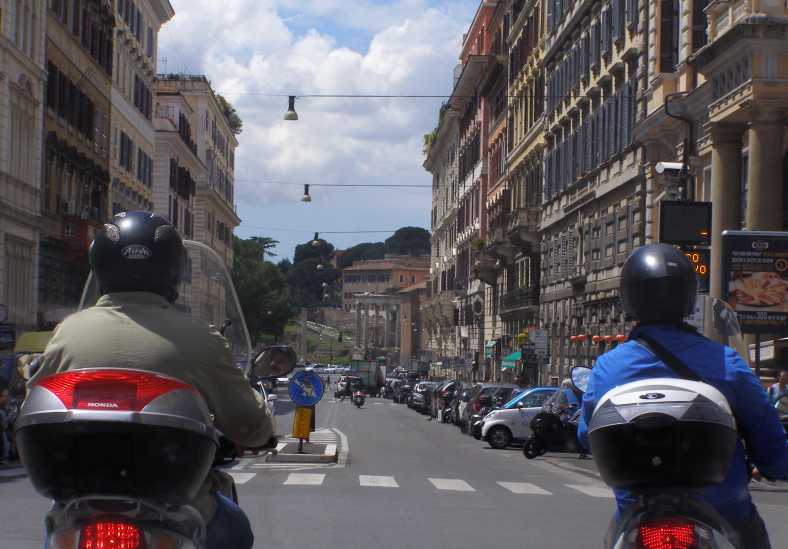
Ruins in sight! Looking ahead past these motorcycles we could see the pillars of a long-gone building. Looking to the left down Via Degli Annibaldi you could see the Colosseum from here. Note that in a country with literally hundreds of motorcycle manufacturers, one rider is on a Honda.
…with the centre of Rome’s various ruins of fame in our sights. The ancient Forum is there in a patch of the city dedicated to the preservation of these relics and to giving access to millions of tourists every year. We continued down this street and turned right to go around the block and back towards…
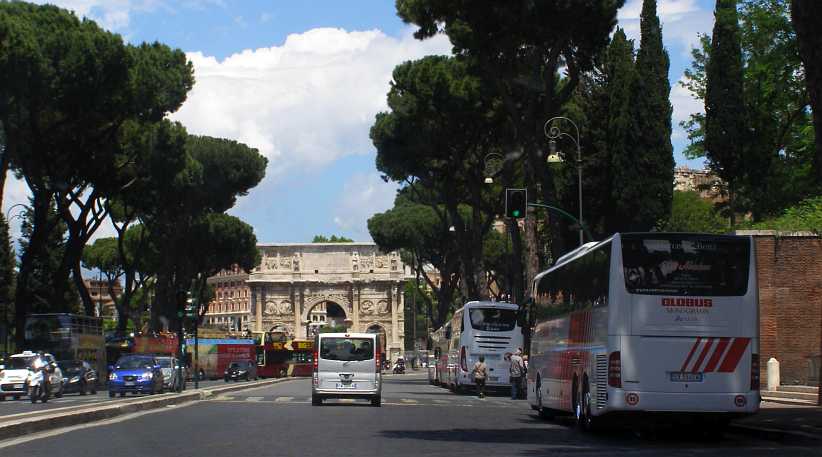
Arch of Constantine. The political and military leaders of those times weren’t shy, they’d build an arch like this to celebrate their triumphs. They abound in Rome, not just one like in Paris.
…the Arch of Constantine. He was the ruler in the fourth Century and notably famous for his part in bringing ‘christianity’ to the fore in Rome. This was, of course, done by blending it with various Pagan religions, adopting Pagan festivals and so on.
And just around the bend was the monster of all ruins, the Colosseum. I’d walked around it back in 1981 and wondered about many things. I rather suspect the brickwork was done at a later stage, perhaps in an effort to restore it, but the realisation that so many thousands of people, working as slaves, put all this together makes one understand better the conditions of life in those times.

It’s big! The name says it must be big and the Colosseum is indeed big. We merely did a virtual drive-by but that was enough to confirm its size in Sandra’s mind.

Closer up. Sandra’s shot from closer quarters shows through the arches. Inside there are the remains of the underground pathways and areas apart from some of the stadium seating.

Further back. Swinging back more towards the Arch of Constantine. Note the pock-marks everywhere in the stone, I was told on my first visit that this was where iron or steel reinforcements were removed by order of the pope to enable cannon ***** to be cast from the metal.
And then it was time to head for Naples. Well, first there was this tour bus Sandra snapped…
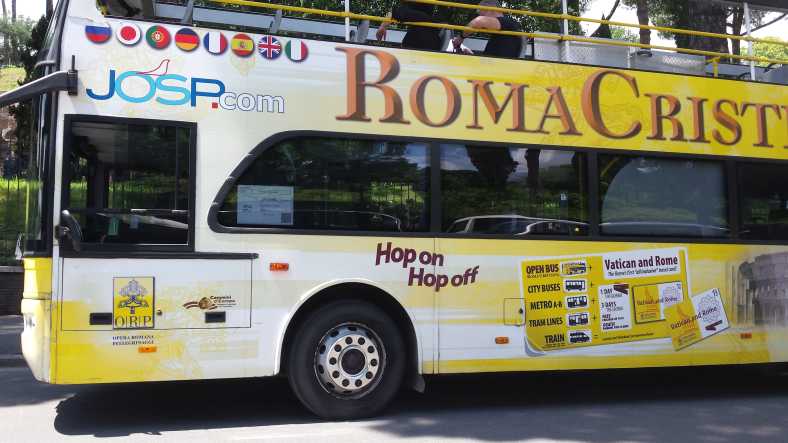
Tour bus. Yes, tourism is a big industry in Rome, particularly around these ruins.
…and then we went past some more (unidentified) ruins…
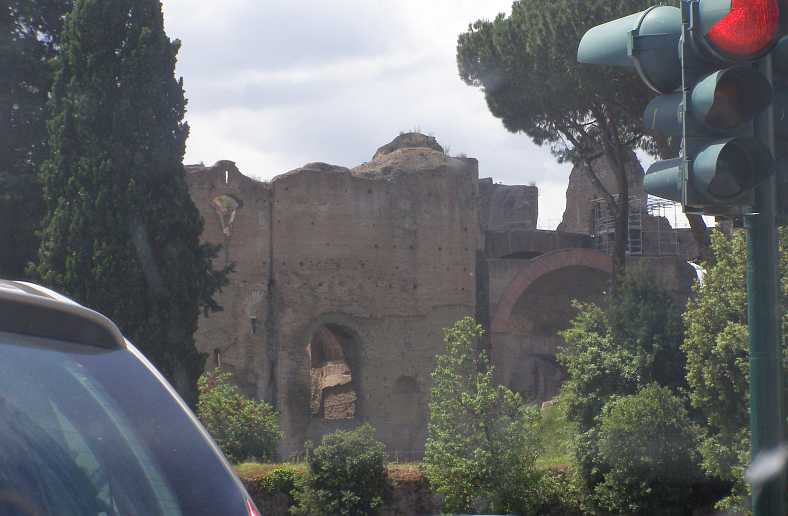
More ruins. I have no idea what this was, but the scaffolding indicates that work is going on to preserve it.
…before we hit our straps on the way to Naples. I’d not been this way on my earlier trip because of the closeness of train timetables for the trip down there from Rome and the return journey. I had an extra day in Rome unexpectedly because my flight out was cancelled due to a lightning strike in Germany and consulted the timetables to see if it was possible. It was, but with only twenty minutes to spare a young American I’d met there warned me, “Twenty minutes? It’s easy for trains to run twenty minutes late.”
Now I was on my way there. By road, the 208 purring along and the GPS was ready to guide us. There was, of course, all kinds of traffic…
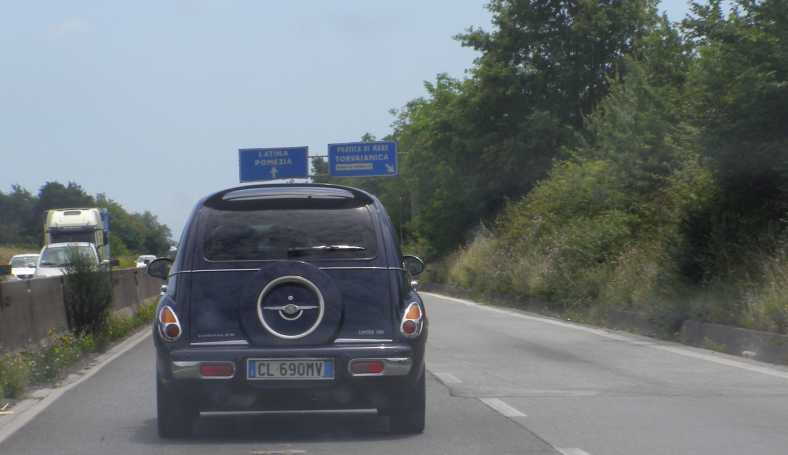
PT Cruiser. Not a common sight in Italy. And by the signs you can tell this isn’t far out of Rome.
Along this stretch we found a stop where we could get something to eat, but we didn’t waste time there at all. The afternoon was wearing on.

Weather closing. The clouds look ominous here, but they didn’t deliver any rain. Fortunately.
I did take the time to stop and photograph this, however. Throughout Italy I’d been seeing abandoned building projects, they intrigued me and this was one of the bigger ones:
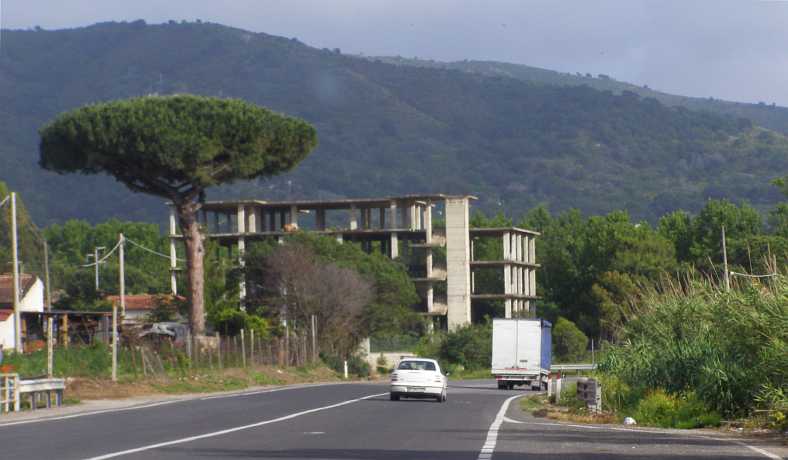
Unfinished building. One of many I saw in Italy, the concrete structure is completed and then nothing more happens.
And while I indulged myself by doing this, it seems we indulged Sandra’s love of the water with yet another brief stop:
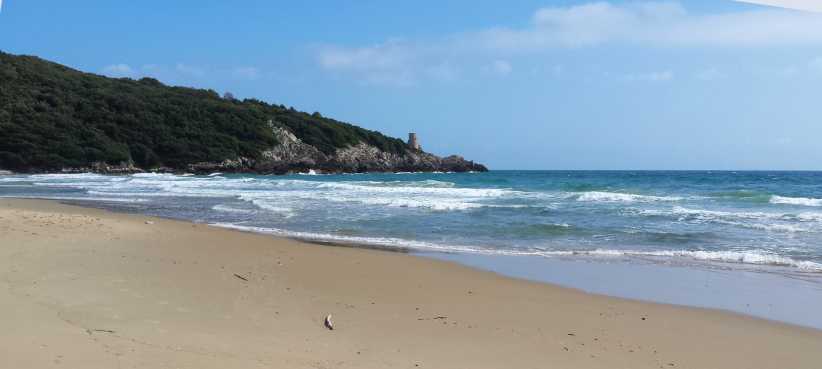
On the beach. Along the way we got close to the coast and Sandra went for a walk on a beach.
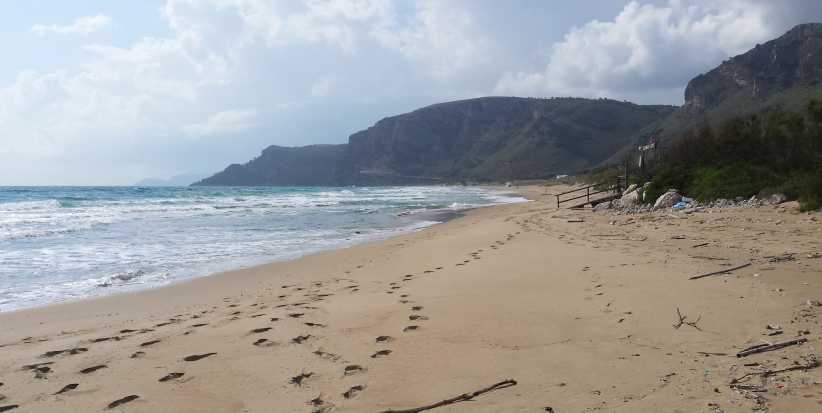
Looking North. This was at Piana di Sant’ Agostino betweek Terracina and Formia.
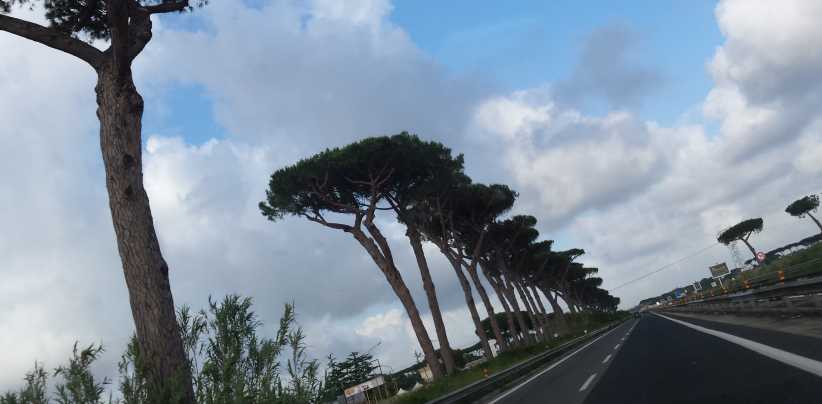
Near Novarredo. The freeway was busy as we neared Naples, this is before the Noverredo exit.
And then we reached Naples. Not the place of beauty I’d been expecting at all!

Naples rubbish. Apparently there’d been a garbage problem for some time before we got there, this rubbish has obviously been present for a while.
I don’t know if they had garbage strikes or what, but the place was a mess. And the afternoon brought us absolutely nothing of that beauty the medical student from New York had told me to expect. It did show us something, however, of the nature of the city as it was on that day.
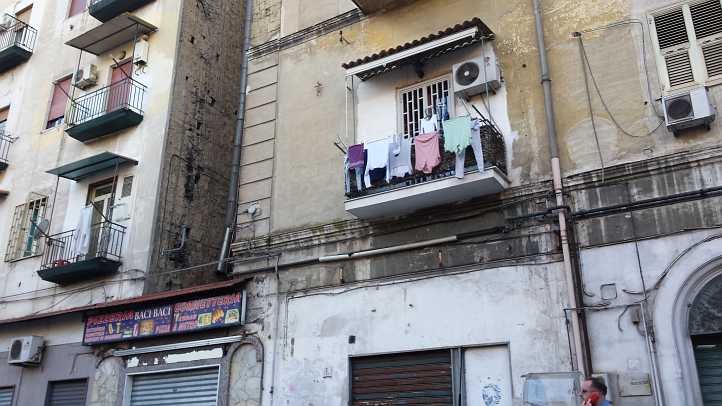
Apartments. Sandra started snapping the scenes as we drove through the town.
Traffic was another problem. It became a struggle to make progress, something I’m not used to these days. Not since the train drivers’ strikes made a mess of the Sydney streets in the sixties and seventies.
And always there was the everpresent rubbish…
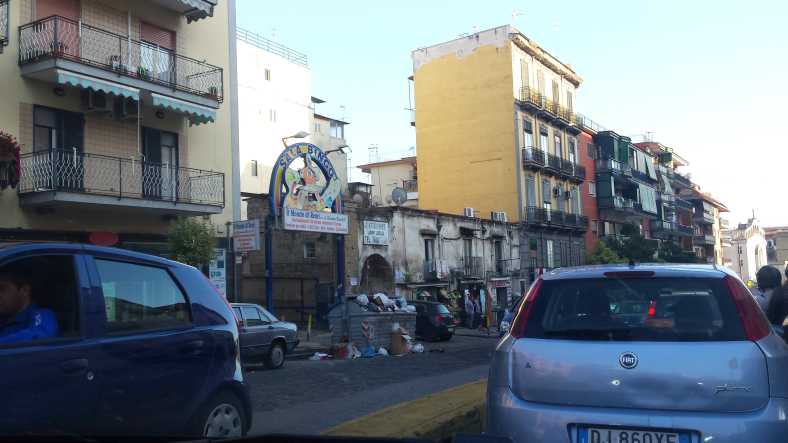
Traffic and buildings. There didn’t seem to be any escape from this tangle.
… while the freedom of the Autostrada was just there above us!
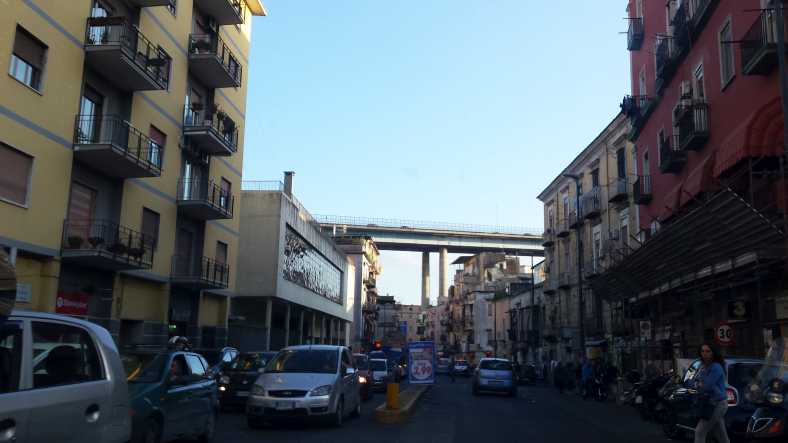
Under the Autostrada. Hustle and bustle of everyday life, heavy traffic and the Autostrada above us, this area seems a bit cleaner. Note the protective structure on the building to the right which was being worked on.
Ahead of us we could see more trouble brewing, we weren’t getting any respite from the traffic situation at all. We were hoping it wouldn’t get worse…
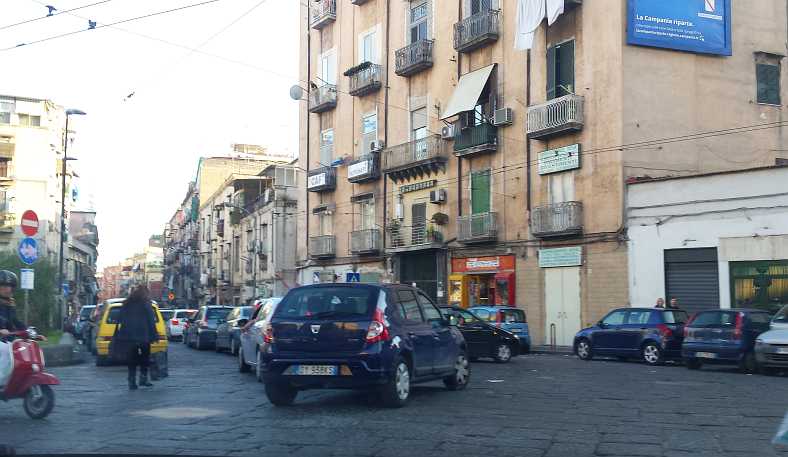
Jam building. Now we were cornered. Even the freedom of a motorcycle was soon to prove no use here.
…but it did. It was the worst traffic tangle I’d been in since my diversion in Queens in 2012. Motorcycles were to get only so far in this, then they shot up over a footpath to the left about 100m ahead of here, along there for a short distance and then disappeared.
But not so the cars:

Stuck! No room for cars to progress here and we weren’t to know what was causing the problem. We were stuck.
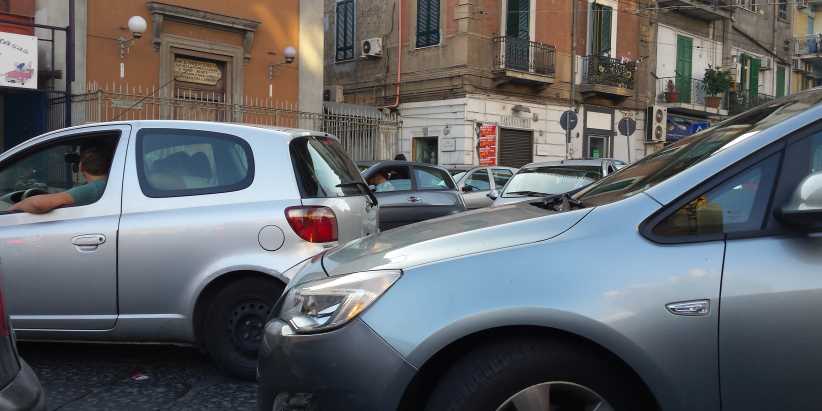
Everybody stuck. It can’t be the normal thing or these people would have found a way around it. Surely?
Motorcycles were moving in and out. The nonchalance of the riders was amazing, one bloke with a smart phone up to his ear, his cigarette in the fingers of the same hand as the phone as he flicked the bike right and left until he joined the others crossing on that footpath a short way ahead.
This one really grabbed me…
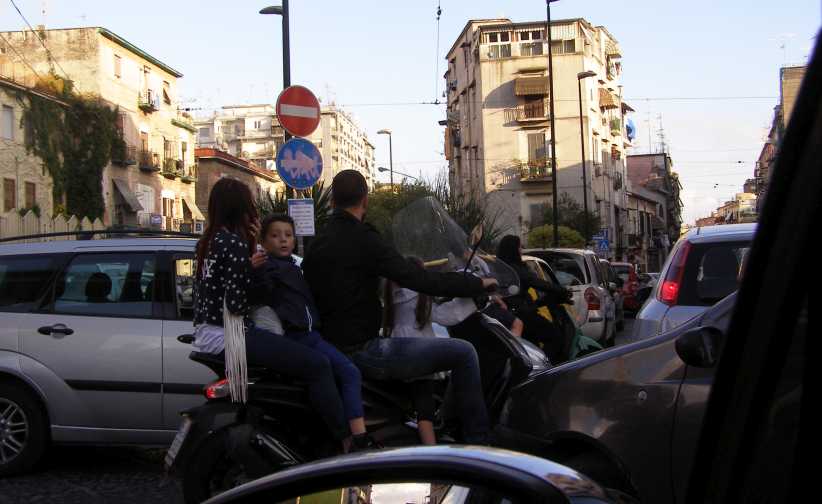
Family Transport. The inquisitive boy sitting between mum and dad, his little sister standing up hanging onto the handlebars, you would never see this in Australia!
…but relief was in sight. One local knew a way out, but he needed the help of a few others to move their cars so they could let him take the path that spelled release from all of this mess. We could all follow him. And so it got arranged and we got out of it.
Back to the Autostrada, we drove on into the dark, getting a bite to eat along the way. Eventually we found somewhere to stay. It might not have been quite as on the map, but it was somewhere near there, a large hotel on a downhill stretch just off the motorway.
Relieved to be out of that congested mess and out into the country again, we settled down for the night. Tomorrow should bring us an easy run to Vince’s place in Siderno…
After setting out from our accommodation alongside Lago Bolseno, here’s the approximate route from Rome to Naples and to the likely point where we were to spend the next night. That was May 16, 2016 and, yes, finding somewhere to stay was again a ‘find it in the dark when you don’t speak the local language’ proposition.

In the morning we were able to get a good look at the place where we stayed…

The restaurant. Lovely people run this little country restaurant and accommodation business, it was a nice place to stay and a nice place to dine.

The gateway. Here’s the part that caught me out. The gateway to the accommodation area was a little narrow, but I thought I could squeeze the 208 through there. Scratches to the door were the result.
Yes, confession time again. I made the big mistake of thinking I could drive through but learned there was steel in there where I thought there was plenty of soft leaves. What a nice place, though.
After breakfast we drove on. We dallied around a bit North of Rome looking at different things and Sandra got these pics of sheep grazing…

Sheep in the meadow. The countryside was green and seeing sheep grazing probably reminded Sandra of home.
… and wildflowers:

Wildflowers. The flower-loving gardener in her came out many times during the trip. Except in Cordoba, of course.
Then, with the course set on the onboard GPS to take us to the Colosseum we got into Rome. Turning wherever the device told us to, left or right, we started to see some signs of ancient stuff as we headed down Via Nomentano towards the Museo Storica dei Bersaglieri, opposite the end of this street:

Via Nomentano. This looked like we were heading for something historic, but it turned out to be not as ancient as expected.
‘Bersaglieri’, it turns out, was an infantry battalion of the early 1800s. But still there’s a statue, possibly a typical battalion member, evident on the tall marble base at the end of this street.

Old and New. The Italians mix the old and the new very well. This wall butts up to the Museo Storica and hides a number of more modern buildings, among them the British Embassy.
Still following the trusted instructions, we turned left here and in time found ourselves at the intersection of Via Cavour and Via Degli Annibaldi…

Ruins in sight! Looking ahead past these motorcycles we could see the pillars of a long-gone building. Looking to the left down Via Degli Annibaldi you could see the Colosseum from here. Note that in a country with literally hundreds of motorcycle manufacturers, one rider is on a Honda.
…with the centre of Rome’s various ruins of fame in our sights. The ancient Forum is there in a patch of the city dedicated to the preservation of these relics and to giving access to millions of tourists every year. We continued down this street and turned right to go around the block and back towards…

Arch of Constantine. The political and military leaders of those times weren’t shy, they’d build an arch like this to celebrate their triumphs. They abound in Rome, not just one like in Paris.
…the Arch of Constantine. He was the ruler in the fourth Century and notably famous for his part in bringing ‘christianity’ to the fore in Rome. This was, of course, done by blending it with various Pagan religions, adopting Pagan festivals and so on.
And just around the bend was the monster of all ruins, the Colosseum. I’d walked around it back in 1981 and wondered about many things. I rather suspect the brickwork was done at a later stage, perhaps in an effort to restore it, but the realisation that so many thousands of people, working as slaves, put all this together makes one understand better the conditions of life in those times.

It’s big! The name says it must be big and the Colosseum is indeed big. We merely did a virtual drive-by but that was enough to confirm its size in Sandra’s mind.

Closer up. Sandra’s shot from closer quarters shows through the arches. Inside there are the remains of the underground pathways and areas apart from some of the stadium seating.

Further back. Swinging back more towards the Arch of Constantine. Note the pock-marks everywhere in the stone, I was told on my first visit that this was where iron or steel reinforcements were removed by order of the pope to enable cannon ***** to be cast from the metal.
And then it was time to head for Naples. Well, first there was this tour bus Sandra snapped…

Tour bus. Yes, tourism is a big industry in Rome, particularly around these ruins.
…and then we went past some more (unidentified) ruins…

More ruins. I have no idea what this was, but the scaffolding indicates that work is going on to preserve it.
…before we hit our straps on the way to Naples. I’d not been this way on my earlier trip because of the closeness of train timetables for the trip down there from Rome and the return journey. I had an extra day in Rome unexpectedly because my flight out was cancelled due to a lightning strike in Germany and consulted the timetables to see if it was possible. It was, but with only twenty minutes to spare a young American I’d met there warned me, “Twenty minutes? It’s easy for trains to run twenty minutes late.”
Now I was on my way there. By road, the 208 purring along and the GPS was ready to guide us. There was, of course, all kinds of traffic…

PT Cruiser. Not a common sight in Italy. And by the signs you can tell this isn’t far out of Rome.
Along this stretch we found a stop where we could get something to eat, but we didn’t waste time there at all. The afternoon was wearing on.

Weather closing. The clouds look ominous here, but they didn’t deliver any rain. Fortunately.
I did take the time to stop and photograph this, however. Throughout Italy I’d been seeing abandoned building projects, they intrigued me and this was one of the bigger ones:

Unfinished building. One of many I saw in Italy, the concrete structure is completed and then nothing more happens.
And while I indulged myself by doing this, it seems we indulged Sandra’s love of the water with yet another brief stop:

On the beach. Along the way we got close to the coast and Sandra went for a walk on a beach.

Looking North. This was at Piana di Sant’ Agostino betweek Terracina and Formia.

Near Novarredo. The freeway was busy as we neared Naples, this is before the Noverredo exit.
And then we reached Naples. Not the place of beauty I’d been expecting at all!

Naples rubbish. Apparently there’d been a garbage problem for some time before we got there, this rubbish has obviously been present for a while.
I don’t know if they had garbage strikes or what, but the place was a mess. And the afternoon brought us absolutely nothing of that beauty the medical student from New York had told me to expect. It did show us something, however, of the nature of the city as it was on that day.

Apartments. Sandra started snapping the scenes as we drove through the town.
Traffic was another problem. It became a struggle to make progress, something I’m not used to these days. Not since the train drivers’ strikes made a mess of the Sydney streets in the sixties and seventies.
And always there was the everpresent rubbish…

Traffic and buildings. There didn’t seem to be any escape from this tangle.
… while the freedom of the Autostrada was just there above us!

Under the Autostrada. Hustle and bustle of everyday life, heavy traffic and the Autostrada above us, this area seems a bit cleaner. Note the protective structure on the building to the right which was being worked on.
Ahead of us we could see more trouble brewing, we weren’t getting any respite from the traffic situation at all. We were hoping it wouldn’t get worse…

Jam building. Now we were cornered. Even the freedom of a motorcycle was soon to prove no use here.
…but it did. It was the worst traffic tangle I’d been in since my diversion in Queens in 2012. Motorcycles were to get only so far in this, then they shot up over a footpath to the left about 100m ahead of here, along there for a short distance and then disappeared.
But not so the cars:

Stuck! No room for cars to progress here and we weren’t to know what was causing the problem. We were stuck.

Everybody stuck. It can’t be the normal thing or these people would have found a way around it. Surely?
Motorcycles were moving in and out. The nonchalance of the riders was amazing, one bloke with a smart phone up to his ear, his cigarette in the fingers of the same hand as the phone as he flicked the bike right and left until he joined the others crossing on that footpath a short way ahead.
This one really grabbed me…

Family Transport. The inquisitive boy sitting between mum and dad, his little sister standing up hanging onto the handlebars, you would never see this in Australia!
…but relief was in sight. One local knew a way out, but he needed the help of a few others to move their cars so they could let him take the path that spelled release from all of this mess. We could all follow him. And so it got arranged and we got out of it.
Back to the Autostrada, we drove on into the dark, getting a bite to eat along the way. Eventually we found somewhere to stay. It might not have been quite as on the map, but it was somewhere near there, a large hotel on a downhill stretch just off the motorway.
Relieved to be out of that congested mess and out into the country again, we settled down for the night. Tomorrow should bring us an easy run to Vince’s place in Siderno…
Last edited by Ray Bell; 06-20-2020 at 06:20 AM.
#188
We hit the road fairly early and drove straight down the Autostrada del Mediterraneo. We were mostly in mountain country and went through a lot of tunnels. The economy of the little Peugeot was fantastic and so I kept the foot down pretty well all the time. Not that we didn’t have faster cars go by, but with the generous speed limits on the Autostrada we could make good time.
Yes, the speed limits…
Sandra was, as always, keeping an eye on my speed. And there were confusing speed limit signs on the Autostrada, sometimes even two speeds on the one sign. We were on the Autostrada with cars whipping past us as we sat on 110-120kmh and a sign like this would crop up:
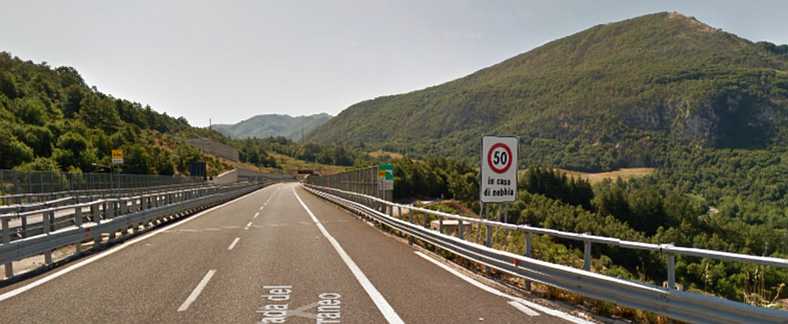
We didn't know it then, but "In caso di nebbia" means "in fog." Again, a problem when you don't know the language, and I’ll leave it to your imagination to guess what happened next on these many occasions...
Our route for the day:

Tunnels came up thick and fast, some long, some short. They all had a sign just before the entry like this:
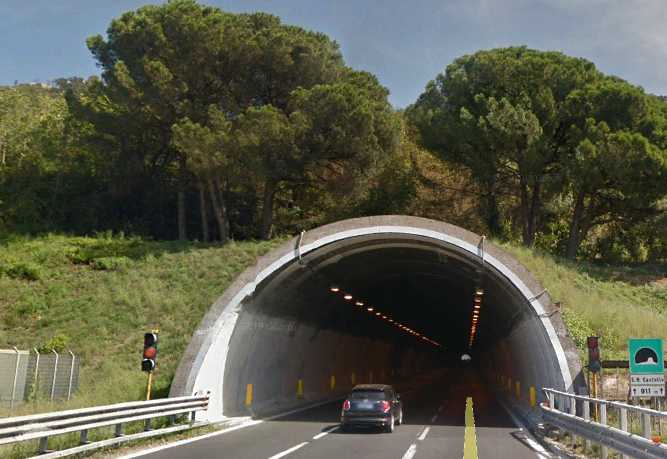
911 metres. Just over half a mile for this tunnel, some were shorter, some were longer. The Italians seem to love their tunnels. Many bridges had similar signs with the distance across showing.
And when we emerged from each tunnel there was a brand new bit of scenery:

Southern Italy scenery. The scenery was actually changing as we drove, some mountains, some less mountainous, some flatter farmlands.
At the rate we were travelling it didn’t take us long to be well on the way to Vince’s place. Nor did it take us long, just over an hour, to reach the IP truckstop at Frascineto…
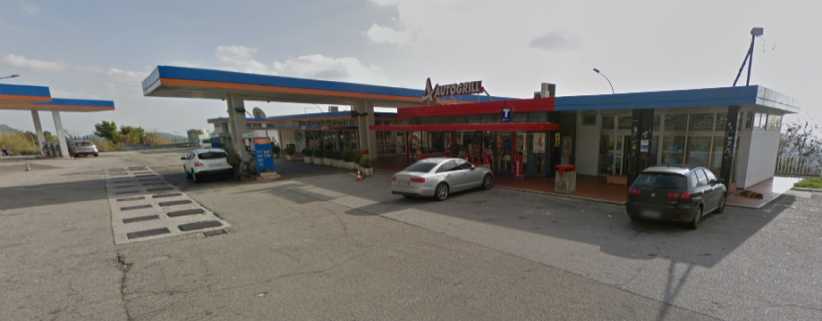
Autogrill. Just an hour on the road and we stopped here for fuel.
…where the Autostrada ran in the shadow of mountains:

Frascineto view. Mountains overlooked the truckstop and low cloud overlooked the mountains.
Eventually we came to a point where we descended from the heights, which gave rise to this road sign:
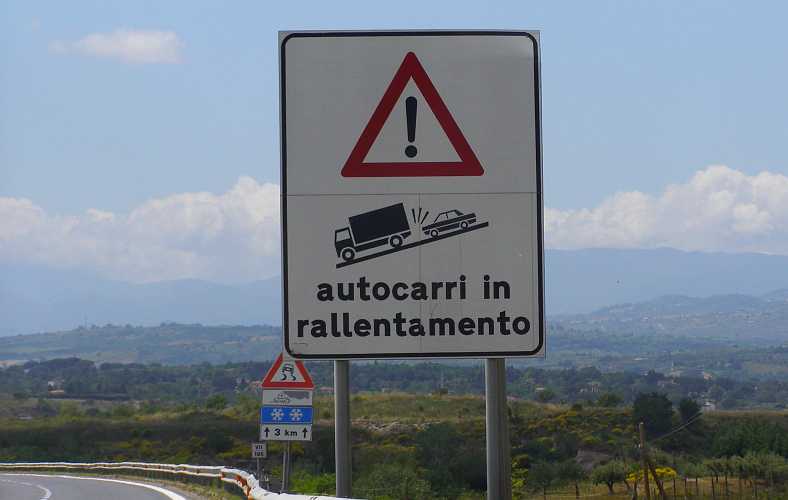
Slow trucks. ‘Trucks Slowing Down’ is the translation for this one. Somewhat different to the signs at home which ask truck drivers to ‘engage low gear’ on such descents.
Now in farming lands instead of mountains we were cruising along and started to think about lunch. A place called Quattromiglia had a McDonalds right at the Autostrada exit so we took that and struggled through the ordering process to get something we could eat. It seemed a strange McDonalds, being in the ground floor of a huge building in a town like this. Google Earth provides a picture:
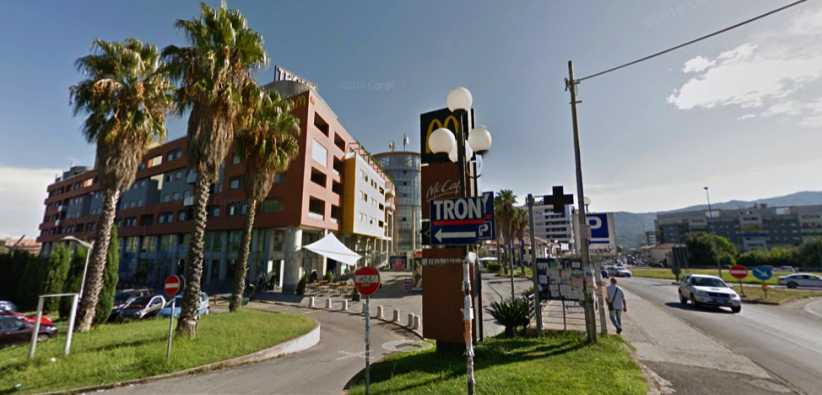
Quattromiglia McDonalds. A bit different for a town like this, but convenient to the Autostrada.
The stop wasn’t just for lunch, either. We were heading to visit old friends of mine and Sandra was concerned about my appearance. And I had lost my comb!
So after eating I walked along the (very long) street that leads away from the Autostrada looking for somewhere to buy a comb. So, just what is the word for ‘comb’ in Italian? The beginnings of my problem, I couldn’t ask anyone where I should go because I couldn’t tell them what I wanted! A great waste of time, but I did find one.
The Autostrada headed closer to the coastline after remaining for so long in the centre of the country. This enabled me to get this picture:
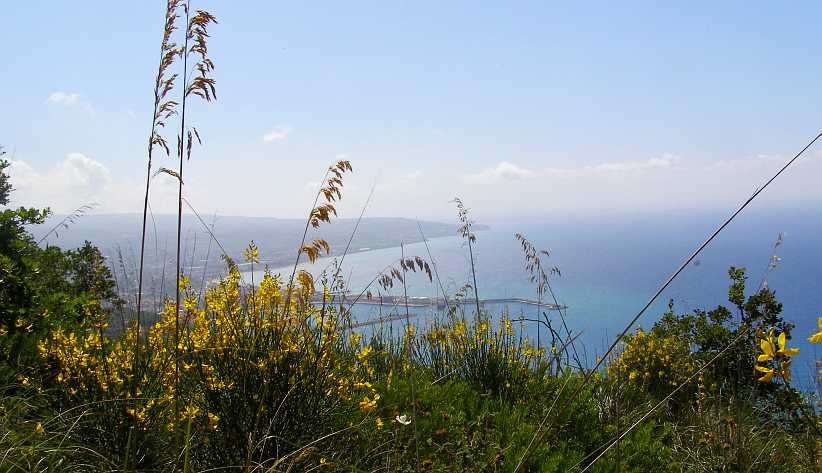
Marina at Pizzo. Pizzo is a town on the Northern side of the ‘boot’ of Italy and features this marina.
We were now getting near to Sicily, just a little way across the waters of the Tyrrhenian Sea, a crossing I would be making with Vince before the week was out. We drove on a little way past the turnoff to Siderno and could see Sicily before we turned back to drive across the (fairly) new motorway that links the Northern side of the ‘boot’ with the shorelines of the South, which face the Mediterranean.
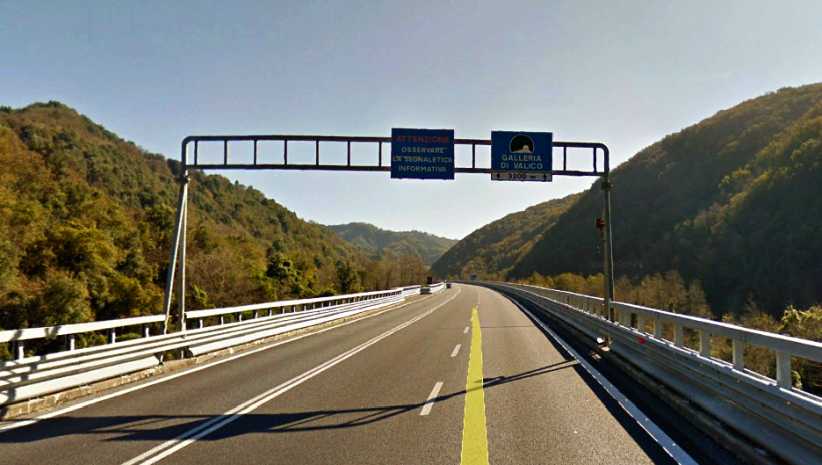
New motorway. Two lanes for most of its length, sometimes three, the ‘Passo Limina’ motorway has changed the travel arrangements of many since it was completed.
Vince was to tell me that this road had faced opposition from the Mafia when mooted and this delayed its construction for a long time. It was a long and complicated story and ended with the road being built and the Mafia benefiting from its construction. This comparison map certainly shows some benefits:
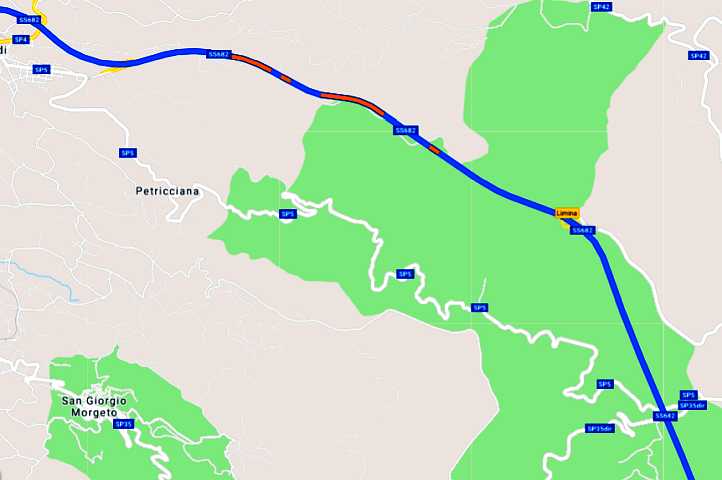
Roads compared. Most people would have driven around the (longer) coastal roads before the motorway was constructed. And who could blame them?
And so we drove on into Siderno. The GPS was set to take us to Via Meleca, which raised some eyebrows when I told people back home. It’s a private road into Vince’s family property and it certainly led us straight to his front gate.

Vince and Mary. Vince, the Italian who went to live in Australia; Mary the Scottish lass who did the same. Their paths crossed and they’ve been together ever since.
As mentioned, I knew Vince from Clubman Sports Car racing in Sydney. He had an Elfin Clubman and shared it with a friend of his, Ron Lane. We had plenty to talk about that night, and some planning to do so we could go on a discovery expedition in Sicily together.
Yes, the speed limits…
Sandra was, as always, keeping an eye on my speed. And there were confusing speed limit signs on the Autostrada, sometimes even two speeds on the one sign. We were on the Autostrada with cars whipping past us as we sat on 110-120kmh and a sign like this would crop up:

We didn't know it then, but "In caso di nebbia" means "in fog." Again, a problem when you don't know the language, and I’ll leave it to your imagination to guess what happened next on these many occasions...
Our route for the day:

Tunnels came up thick and fast, some long, some short. They all had a sign just before the entry like this:

911 metres. Just over half a mile for this tunnel, some were shorter, some were longer. The Italians seem to love their tunnels. Many bridges had similar signs with the distance across showing.
And when we emerged from each tunnel there was a brand new bit of scenery:

Southern Italy scenery. The scenery was actually changing as we drove, some mountains, some less mountainous, some flatter farmlands.
At the rate we were travelling it didn’t take us long to be well on the way to Vince’s place. Nor did it take us long, just over an hour, to reach the IP truckstop at Frascineto…

Autogrill. Just an hour on the road and we stopped here for fuel.
…where the Autostrada ran in the shadow of mountains:

Frascineto view. Mountains overlooked the truckstop and low cloud overlooked the mountains.
Eventually we came to a point where we descended from the heights, which gave rise to this road sign:

Slow trucks. ‘Trucks Slowing Down’ is the translation for this one. Somewhat different to the signs at home which ask truck drivers to ‘engage low gear’ on such descents.
Now in farming lands instead of mountains we were cruising along and started to think about lunch. A place called Quattromiglia had a McDonalds right at the Autostrada exit so we took that and struggled through the ordering process to get something we could eat. It seemed a strange McDonalds, being in the ground floor of a huge building in a town like this. Google Earth provides a picture:

Quattromiglia McDonalds. A bit different for a town like this, but convenient to the Autostrada.
The stop wasn’t just for lunch, either. We were heading to visit old friends of mine and Sandra was concerned about my appearance. And I had lost my comb!
So after eating I walked along the (very long) street that leads away from the Autostrada looking for somewhere to buy a comb. So, just what is the word for ‘comb’ in Italian? The beginnings of my problem, I couldn’t ask anyone where I should go because I couldn’t tell them what I wanted! A great waste of time, but I did find one.
The Autostrada headed closer to the coastline after remaining for so long in the centre of the country. This enabled me to get this picture:

Marina at Pizzo. Pizzo is a town on the Northern side of the ‘boot’ of Italy and features this marina.
We were now getting near to Sicily, just a little way across the waters of the Tyrrhenian Sea, a crossing I would be making with Vince before the week was out. We drove on a little way past the turnoff to Siderno and could see Sicily before we turned back to drive across the (fairly) new motorway that links the Northern side of the ‘boot’ with the shorelines of the South, which face the Mediterranean.

New motorway. Two lanes for most of its length, sometimes three, the ‘Passo Limina’ motorway has changed the travel arrangements of many since it was completed.
Vince was to tell me that this road had faced opposition from the Mafia when mooted and this delayed its construction for a long time. It was a long and complicated story and ended with the road being built and the Mafia benefiting from its construction. This comparison map certainly shows some benefits:

Roads compared. Most people would have driven around the (longer) coastal roads before the motorway was constructed. And who could blame them?
And so we drove on into Siderno. The GPS was set to take us to Via Meleca, which raised some eyebrows when I told people back home. It’s a private road into Vince’s family property and it certainly led us straight to his front gate.

Vince and Mary. Vince, the Italian who went to live in Australia; Mary the Scottish lass who did the same. Their paths crossed and they’ve been together ever since.
As mentioned, I knew Vince from Clubman Sports Car racing in Sydney. He had an Elfin Clubman and shared it with a friend of his, Ron Lane. We had plenty to talk about that night, and some planning to do so we could go on a discovery expedition in Sicily together.
Last edited by Ray Bell; 06-22-2020 at 08:15 AM. Reason: Added in extra detail - lunch and buying a comb!
#189
Vince and Mary showed us around the family property, which includes two houses and some sort of argument about who should own what. Sounds like the average family. Wednesday night, our first night there, they gave us a bedroom and the password to their wi-fi and we dined in comfort. And made plans for Thursday, of course.

Yes, Thursday was the day Vince and I would go to Sicily and look at the circuit on which the famous Targa Florio was raced. Sandra would rest up with Mary for the day, and to that end it was helpful that they got on like a house on fire.
We set out fairly early, crossed the mountains and awaited the ferry at Villa san Giovanni, which didn’t take long...
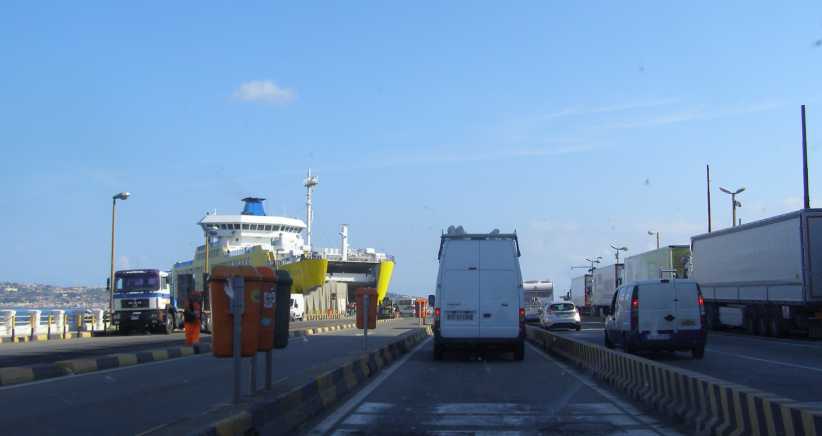
Lined up. Cars, trucks, motorcycles all line up together for the rapid loading of the ferry to Messina.
At some point just after leaving the shore I looked at the on-board GPS and saw that it had the ferry route as a road for us!
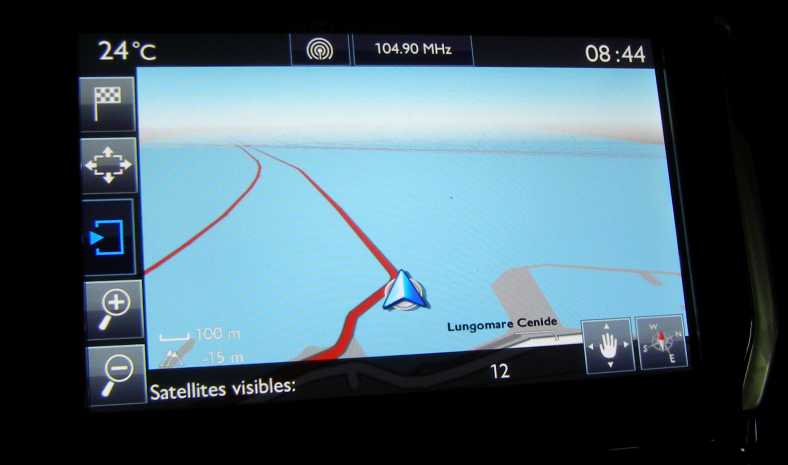
GPS ready! The GPS shows the ferry’s route over the water.
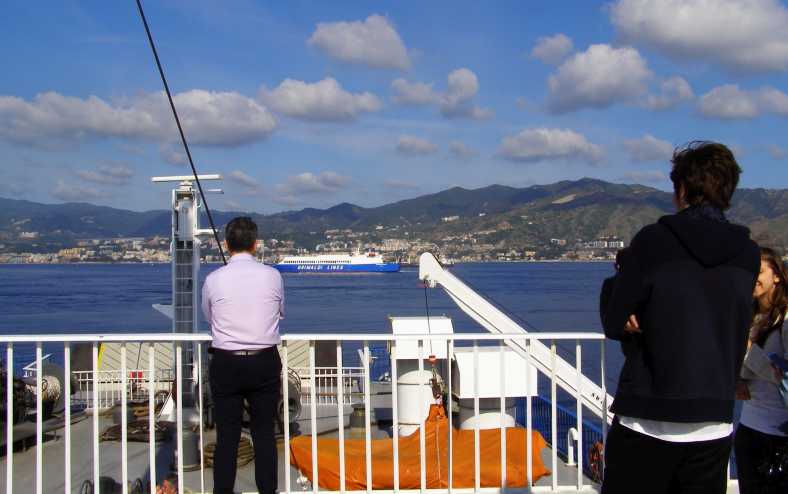
Crossing paths. The ferries run frequently, so passing a ‘sister ship’ mid-crossing is normal. The ferries carry the name of the Grimaldi Lines.
Soon we were looking to dock at Messina, the Sicilian town which gets a lot of the ferry traffic. There are other ferries which take longer routes from points closer to Rome and Naples.
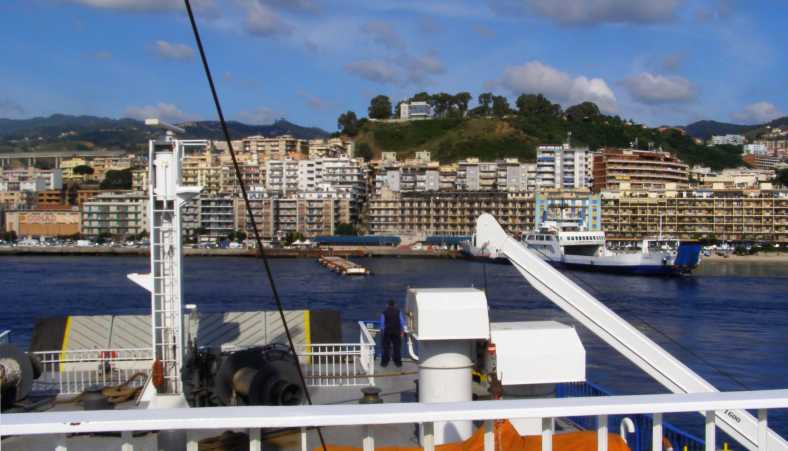
Modern Messina Messina is a large town, or city, and it seemed to me that it’s modern too, with plenty of new buildings.
We swifty took to the highway, or Autostrada, which headed us for Campfolice, which is where we’d join the Targa Florio circuit itself. It was, of course, public roads, so driving them would be no problem.

More Autostradas. We were on one and then we saw another on the distant hill. Later I’d learn that infrastructure spending in Sicily doesn’t always get results.
We turned at Campfolice and climbed into the mountains on the way to Collesano. The roads were distinctly inferior to the modern Autostradas and seemed to be lacking attention. The big thing here was to visualise what it was like to drive these roads in something like a Ferrari P3 with a screaming 4-litre V12 in the back. The road started to look very narrow!

On the circuit. Muscling a V12 Ferrari through this S-bend would be a job in itself. Now consider that there’s 72 kilometres of this kind of road per lap.
But worse was to come. Soon enough we saw evidence of lack of maintenance of the road, with serious cracking of the hotmix where the supporting base material was simply slipping away.

Slipping away. By day’s end I would have a lot of photos of this kind of road collapse and worse.
I was seeing short straights and tight corners which added up to a lot of second and third gear work in cars of the nature of the fastest ones which raced here in the sixties and seventies. Scorching temperatures on brakes, too, as they were pulled down to speed for corners like this:
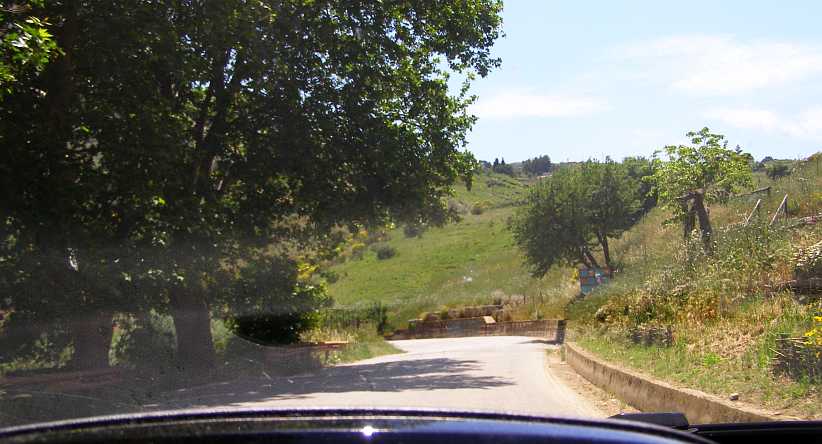
An old road. The Targa’s history goes back to antiquity in motor sporting terms, the first race having been held here in 1906 and the last 71 years later.
The next town we reached was Collesano, which has the Museo Targa Florio (not open when we were there) and a lot of indications that it was a big part of the event.
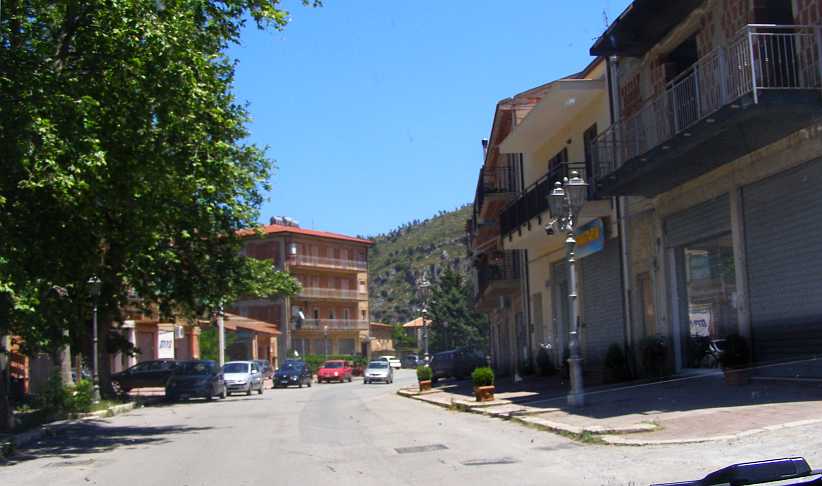
Collesano. The cars simply raced through the town, though some of these buildings weren’t a part of it then. Many villages had the cars rush up their main streets.
The Targa Florio circuit of modern times was 72kms long, but earlier versions were even longer. And no doubt narrower, dustier, rougher and generally more difficult than those traversed by the cars with wheels exceeding 16” in width and pushed along by engines with horsepower those veterans couldn’t even imagine.
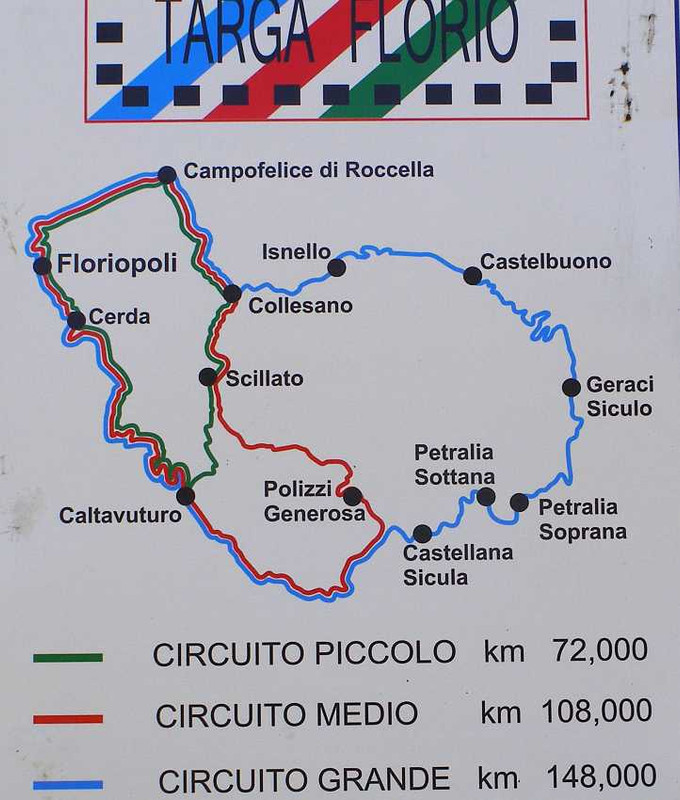
Circuit maps. It’s hard to imagine how these circuits came into being and were managed over such vast distances.
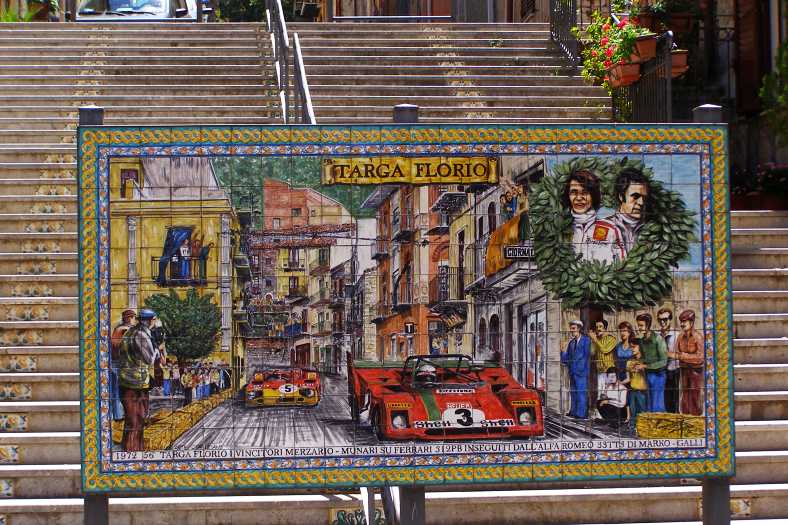
Art in Collesano. Ceramic graphics have been used to picture an Alfa Romeo and a Ferrari in the streets of the town.
Vince and I had been on the go for some time since breakfast and so we went into a restaurant to eat. The place was full of Targa Florio and the walls simply lined with old photographs framed for display. Here are just a few of them:
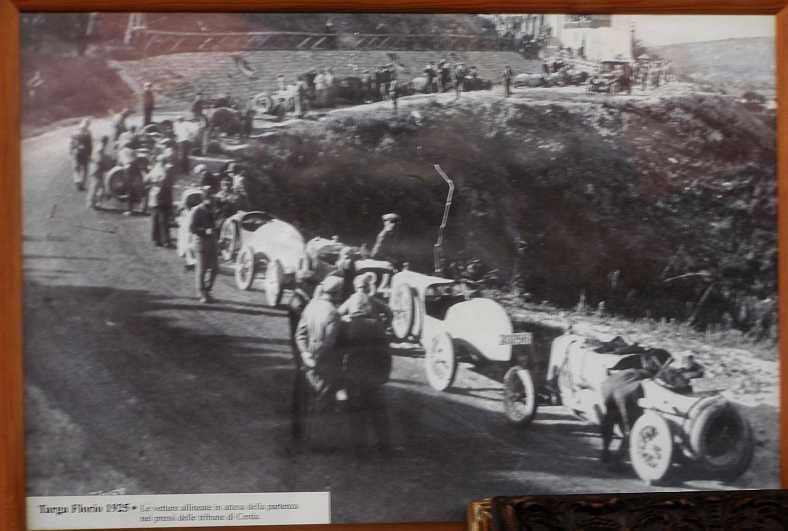
1925. The cars lined up here represent the leading racers of the day. In 1925 the Monaco Grand Prix (like many others) had yet to be held, but the Targa had been going 19 years.
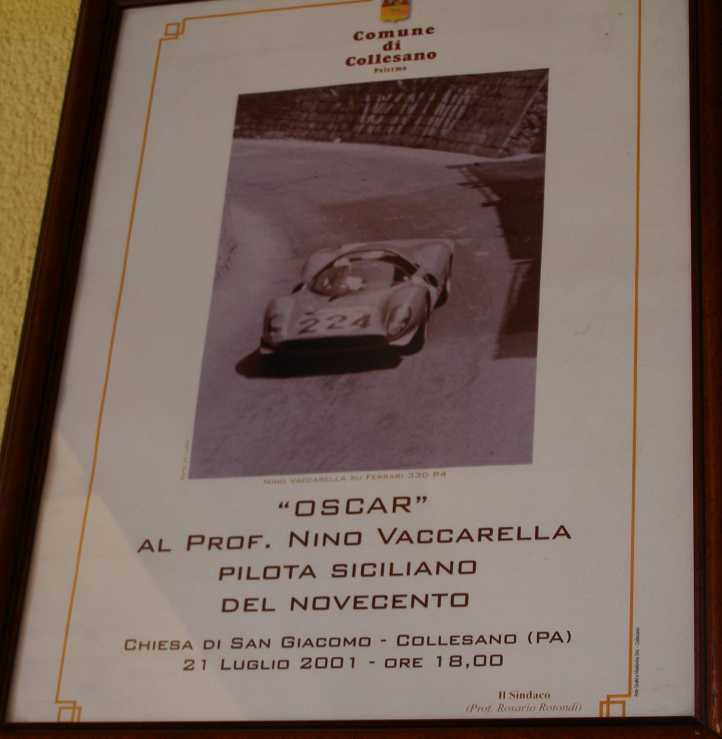
Local lad. Ferrari pinned their hopes many times on Nino Vaccarella, a local school teacher who raced around the circuit virtually every day improving his memory of the track and its nuances.
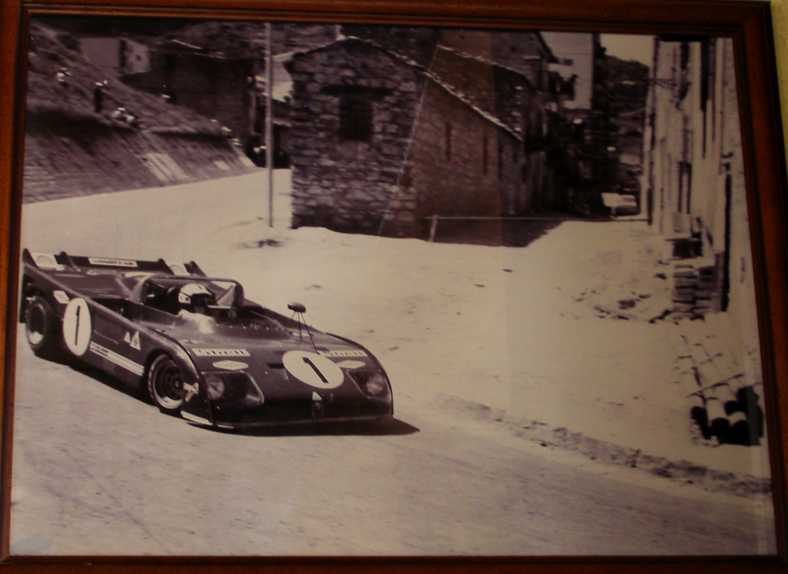
Nino in an Alfa. In 1972 Alfa Romeo mounted a huge effort to try to win the race, including putting Vaccarella into one of their cars. They missed the win by fifteen seconds.
There’s little doubt that the nature of this event was well past its prime, and well beyond the safe bounds of the cars competing, by the seventies. Safety standards of closed circuits were improving by the year but it was impossible to apply those to a circuit of this size and nature.
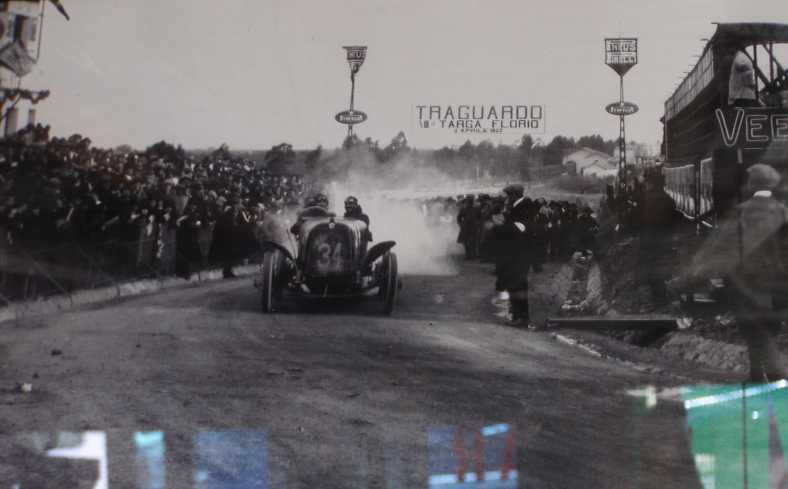
Ladies too. The Contessa d’Avanzo was a lady driver who lined up to take on the Targa in the early days.
We took too long over lunch, but it was a good relaxing time in that restaurant and looking at all the pictures. Then it was time to head back out to the circuit...
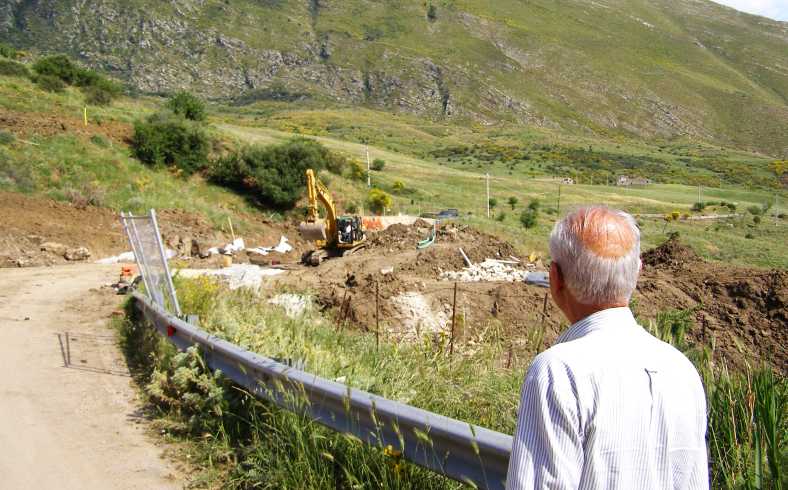
Roadworks. Vince looks on as an excavator does its stuff in a place where the whole road has slipped away. This stopped our progress.
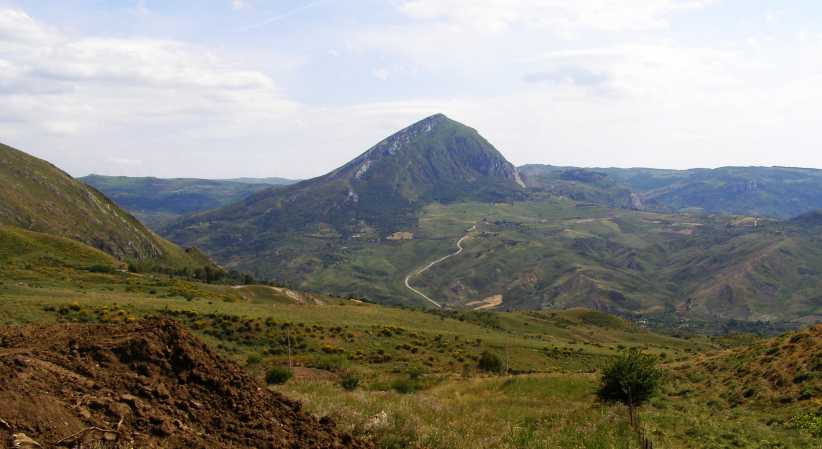
Mountains ahead. Looking beyond the roadworks we could see the road snaking its way towards the distant mountains.
We were forced to stop here, so we went around to the other side of the circuit, towards Palermo, where we found more of the same kind of thing happening. We realised that we would never be able to go right around and elected to just do what we could so we wouldn’t be back at Siderno too late. The ladies might be worried, mightn’t they?
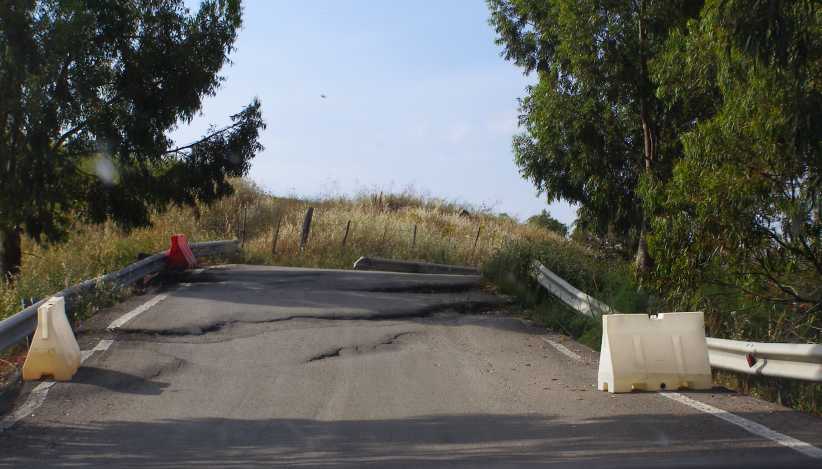
More damage. It wasn’t hard to find damaged roadway. This section of subsidence was bad enough, but...
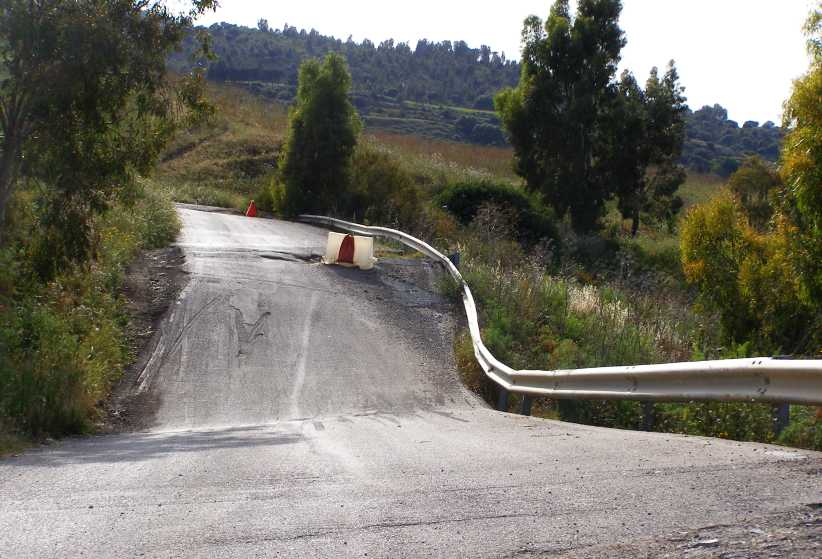
Serious collapse. ...this section has collapsed to an even greater degree, distortion of the road beyond one’s imagination.
All the while, of course, we continued to marvel at just what a great fun piece of road it must have been for those racing on it. This bit saw it open up a little:
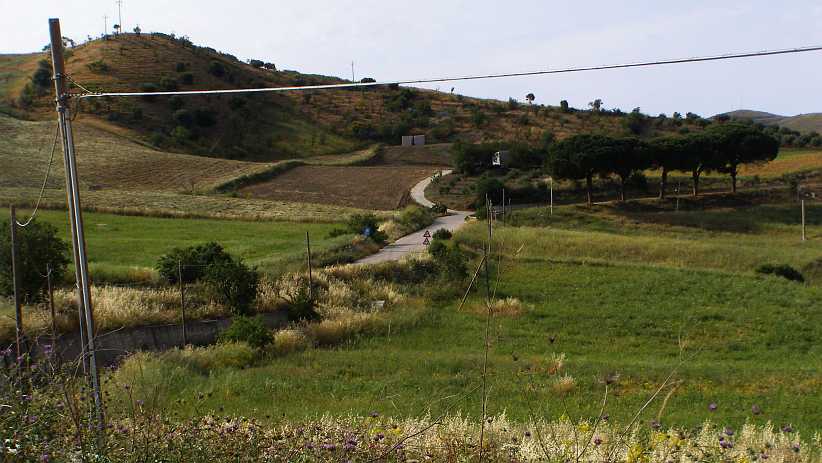
Great road. A bit of a leg-stretch portion here, giving drivers a brief break from the tighter twists.
There was, in fact, quite a long straighter section on the Northern leg near Campfolice, but the vast majority of the circuit was simply corner after corner. With climbs and drops added in, of course.
The start and finish were at Cerda…
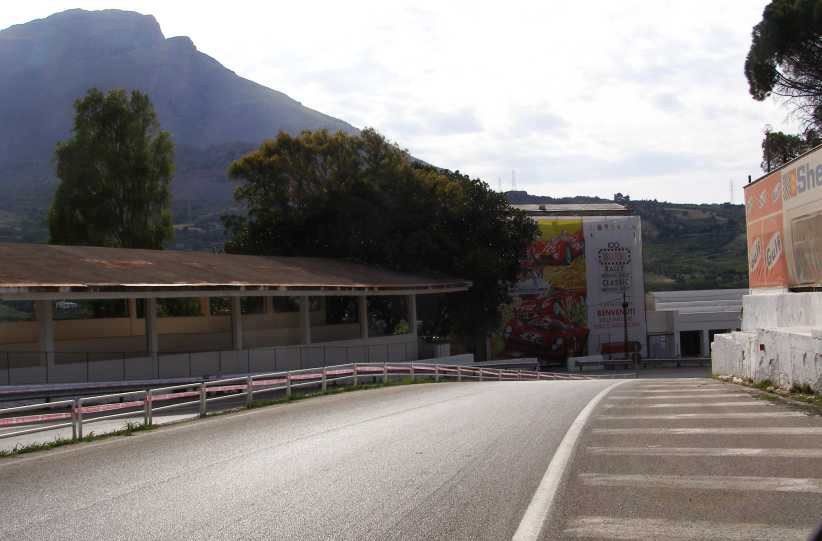
Cerda. The old pit area is still there as Sicily preserves one of its more interesting bits of modern history.
And we were on our way home, driving back over a short section we’d covered before. Back to Messina, back on a ferry, back across that little drive through the mountains to Siderno. Little did I know what shock awaited me there.
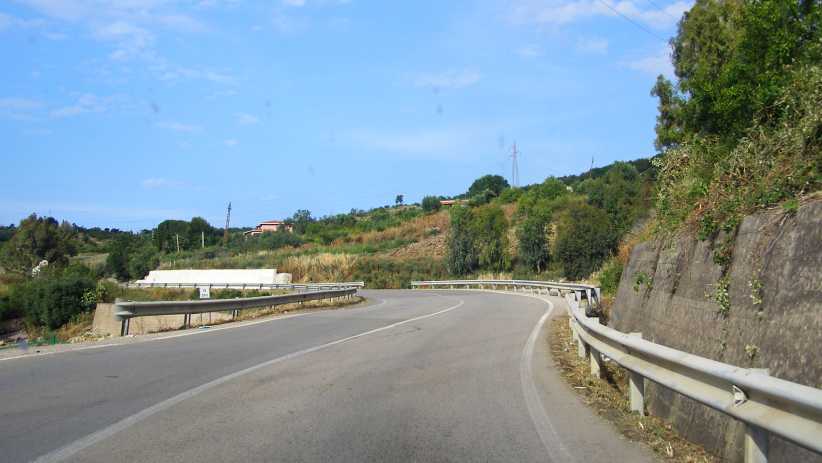
Armco. I’ve read somewhere that there was no Armco fencing, but this photo shows there was.
Just in case I haven't conveyed enough of an impression about what the Targa was like, here's a ten-minute clip about the 1970 race with English commentary and plenty of different angles on the circuit:
As we prepared for dinner, Sandra told me that she had to go home. The damage that had been done to her back and the constant pain she was in was, she felt, only going to get worse. She was better off flying home.
I did, of course, try to talk her out of it, but it was a lost cause. I started checking out flights and arrangements as Vince consoled me and Mary stood by Sandra.
To say this spoiled my day would be an understatement.

Yes, Thursday was the day Vince and I would go to Sicily and look at the circuit on which the famous Targa Florio was raced. Sandra would rest up with Mary for the day, and to that end it was helpful that they got on like a house on fire.
We set out fairly early, crossed the mountains and awaited the ferry at Villa san Giovanni, which didn’t take long...

Lined up. Cars, trucks, motorcycles all line up together for the rapid loading of the ferry to Messina.
At some point just after leaving the shore I looked at the on-board GPS and saw that it had the ferry route as a road for us!

GPS ready! The GPS shows the ferry’s route over the water.

Crossing paths. The ferries run frequently, so passing a ‘sister ship’ mid-crossing is normal. The ferries carry the name of the Grimaldi Lines.
Soon we were looking to dock at Messina, the Sicilian town which gets a lot of the ferry traffic. There are other ferries which take longer routes from points closer to Rome and Naples.

Modern Messina Messina is a large town, or city, and it seemed to me that it’s modern too, with plenty of new buildings.
We swifty took to the highway, or Autostrada, which headed us for Campfolice, which is where we’d join the Targa Florio circuit itself. It was, of course, public roads, so driving them would be no problem.

More Autostradas. We were on one and then we saw another on the distant hill. Later I’d learn that infrastructure spending in Sicily doesn’t always get results.
We turned at Campfolice and climbed into the mountains on the way to Collesano. The roads were distinctly inferior to the modern Autostradas and seemed to be lacking attention. The big thing here was to visualise what it was like to drive these roads in something like a Ferrari P3 with a screaming 4-litre V12 in the back. The road started to look very narrow!

On the circuit. Muscling a V12 Ferrari through this S-bend would be a job in itself. Now consider that there’s 72 kilometres of this kind of road per lap.
But worse was to come. Soon enough we saw evidence of lack of maintenance of the road, with serious cracking of the hotmix where the supporting base material was simply slipping away.

Slipping away. By day’s end I would have a lot of photos of this kind of road collapse and worse.
I was seeing short straights and tight corners which added up to a lot of second and third gear work in cars of the nature of the fastest ones which raced here in the sixties and seventies. Scorching temperatures on brakes, too, as they were pulled down to speed for corners like this:

An old road. The Targa’s history goes back to antiquity in motor sporting terms, the first race having been held here in 1906 and the last 71 years later.
The next town we reached was Collesano, which has the Museo Targa Florio (not open when we were there) and a lot of indications that it was a big part of the event.

Collesano. The cars simply raced through the town, though some of these buildings weren’t a part of it then. Many villages had the cars rush up their main streets.
The Targa Florio circuit of modern times was 72kms long, but earlier versions were even longer. And no doubt narrower, dustier, rougher and generally more difficult than those traversed by the cars with wheels exceeding 16” in width and pushed along by engines with horsepower those veterans couldn’t even imagine.

Circuit maps. It’s hard to imagine how these circuits came into being and were managed over such vast distances.

Art in Collesano. Ceramic graphics have been used to picture an Alfa Romeo and a Ferrari in the streets of the town.
Vince and I had been on the go for some time since breakfast and so we went into a restaurant to eat. The place was full of Targa Florio and the walls simply lined with old photographs framed for display. Here are just a few of them:

1925. The cars lined up here represent the leading racers of the day. In 1925 the Monaco Grand Prix (like many others) had yet to be held, but the Targa had been going 19 years.

Local lad. Ferrari pinned their hopes many times on Nino Vaccarella, a local school teacher who raced around the circuit virtually every day improving his memory of the track and its nuances.

Nino in an Alfa. In 1972 Alfa Romeo mounted a huge effort to try to win the race, including putting Vaccarella into one of their cars. They missed the win by fifteen seconds.
There’s little doubt that the nature of this event was well past its prime, and well beyond the safe bounds of the cars competing, by the seventies. Safety standards of closed circuits were improving by the year but it was impossible to apply those to a circuit of this size and nature.

Ladies too. The Contessa d’Avanzo was a lady driver who lined up to take on the Targa in the early days.
We took too long over lunch, but it was a good relaxing time in that restaurant and looking at all the pictures. Then it was time to head back out to the circuit...

Roadworks. Vince looks on as an excavator does its stuff in a place where the whole road has slipped away. This stopped our progress.

Mountains ahead. Looking beyond the roadworks we could see the road snaking its way towards the distant mountains.
We were forced to stop here, so we went around to the other side of the circuit, towards Palermo, where we found more of the same kind of thing happening. We realised that we would never be able to go right around and elected to just do what we could so we wouldn’t be back at Siderno too late. The ladies might be worried, mightn’t they?

More damage. It wasn’t hard to find damaged roadway. This section of subsidence was bad enough, but...

Serious collapse. ...this section has collapsed to an even greater degree, distortion of the road beyond one’s imagination.
All the while, of course, we continued to marvel at just what a great fun piece of road it must have been for those racing on it. This bit saw it open up a little:

Great road. A bit of a leg-stretch portion here, giving drivers a brief break from the tighter twists.
There was, in fact, quite a long straighter section on the Northern leg near Campfolice, but the vast majority of the circuit was simply corner after corner. With climbs and drops added in, of course.
The start and finish were at Cerda…

Cerda. The old pit area is still there as Sicily preserves one of its more interesting bits of modern history.
And we were on our way home, driving back over a short section we’d covered before. Back to Messina, back on a ferry, back across that little drive through the mountains to Siderno. Little did I know what shock awaited me there.

Armco. I’ve read somewhere that there was no Armco fencing, but this photo shows there was.
Just in case I haven't conveyed enough of an impression about what the Targa was like, here's a ten-minute clip about the 1970 race with English commentary and plenty of different angles on the circuit:
As we prepared for dinner, Sandra told me that she had to go home. The damage that had been done to her back and the constant pain she was in was, she felt, only going to get worse. She was better off flying home.
I did, of course, try to talk her out of it, but it was a lost cause. I started checking out flights and arrangements as Vince consoled me and Mary stood by Sandra.
To say this spoiled my day would be an understatement.
Last edited by Ray Bell; 06-23-2020 at 01:19 AM. Reason: Added You Tube Targa Florio clip.
#190
Thursday began with a trip to the market, where I was to see how well set-up some of these marketeers are. Quite a number of vendors come to the marketplace each week and many of the town’s residents descend on them to stock up on supplies.

Market day. Markets in Siderno, the market operators descend on the town and ply their wares from vans, trucks and stalls.
Vince was very familiar with this arrangement, it is very likely a weekly event for him to go there and see what’s on offer. He went this time with a shopping list, so he knew what to look for and where to get it.
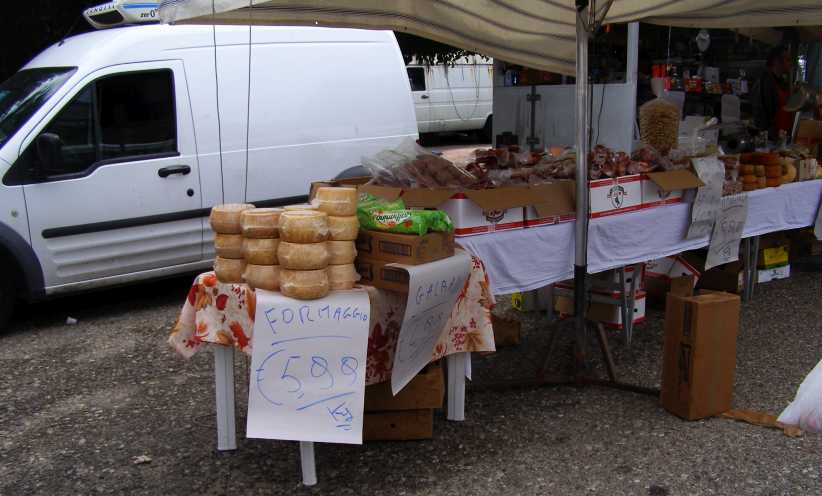
All kinds. Starting with the cheeses at the front, this one sold all kinds of things.
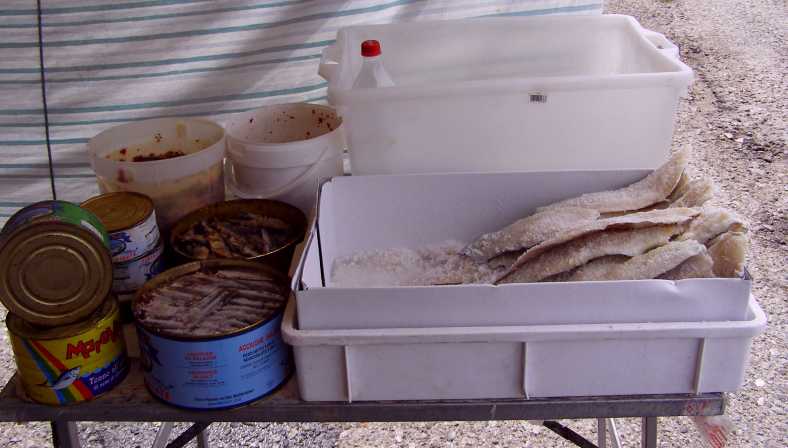
From the sea. Fresh caught or tinned, seafood was naturally a part of the market array.
I was just an onlooker for this event as Vince had it all worked out. Now I wonder about how these people run these businesses, for setting up very early in the morning to market their goods is just a part of the operation. They have to buy the stuff somewhere, they have to maintain their vehicles, refrigeration equipment and display settings as well, and then travel from place to place to participate in the markets.
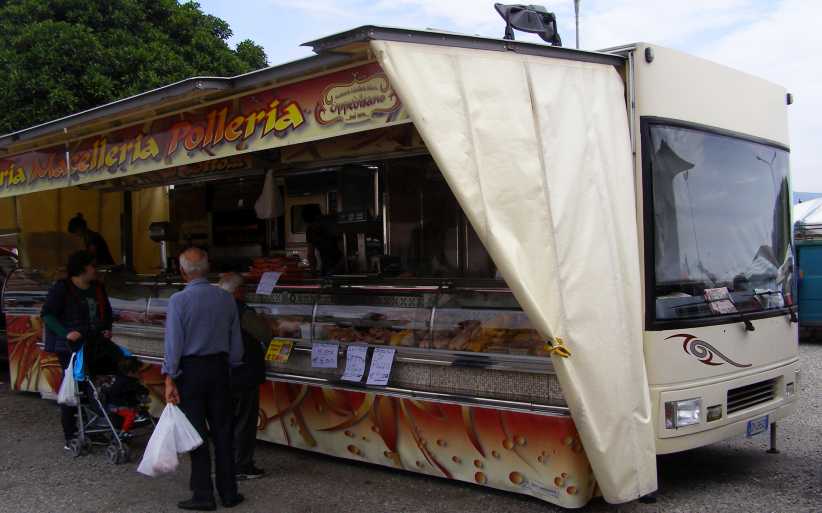
Well-equipped. While Vince was looking over the goodies here, I was pondering the way the rig was set up to store, cook, display and travel with all they have to offer. A very specialised construction here.
After returning to the Meleca home, Vince and I started looking through his photo albums of his racing days. I never knew before that he had first raced a Lotus 18…
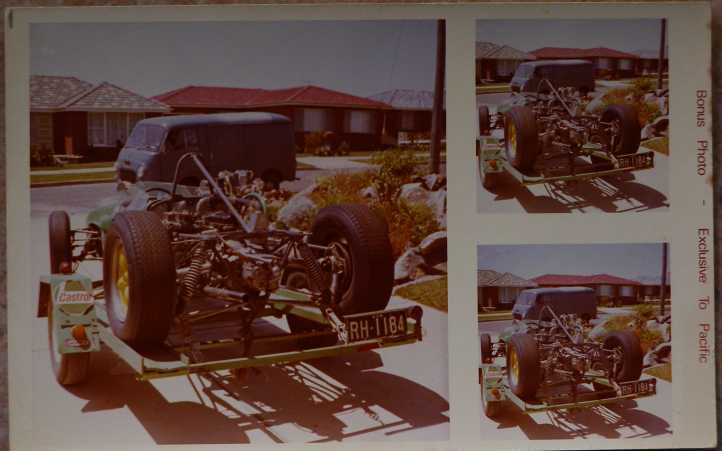
Vince’s Lotus. This Lotus 18 was an early part of Vince’s motor racing, a Formula Junior car originally imported with the first three of these to come to Australia. Stirling Moss drove it to familiarise himself with Warwick Farm when his car wasn’t available for the first day of practice there, it was later bought and raced by Leo Geoghegan to begin his long association with Lotus open-wheelers. Vince had some fun in it as it was getting old.
…and then I learned he crashed it severely at Silverdale Hillclimb, the results of which are in these pics:
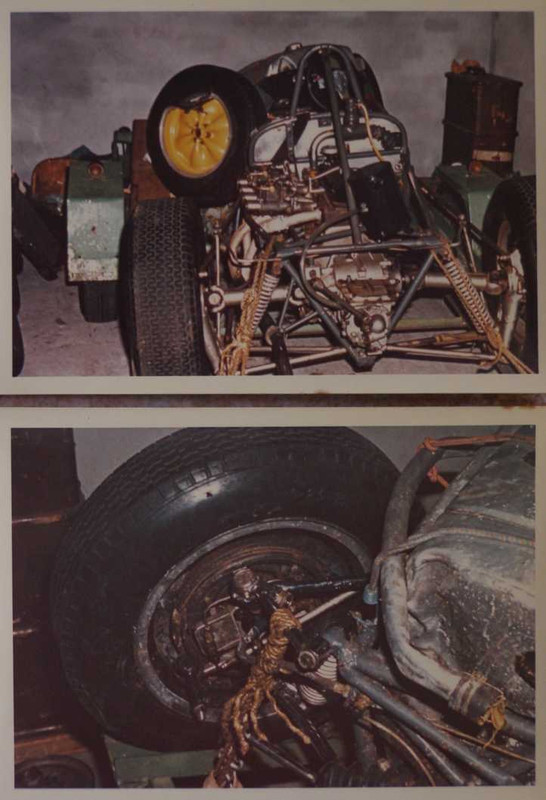
Lotus crashed. There wasn’t much room for error at Silverdale and it caught Vince out. The car was badly damaged.
While I was there I phoned Marc Schagen, who has done a book about Lotus cars raced in Australia so he could ask Vince about anything he might want to know about his time with the car. It was he who told me about the car’s history.
Vince’s next car was an Elfin Clubman. There wasn’t may of these built, fewer than a dozen I think, and Vince bought it in partnership with Ron Lane. They shared the drives. But the person talking to Vince in the car in this picture…
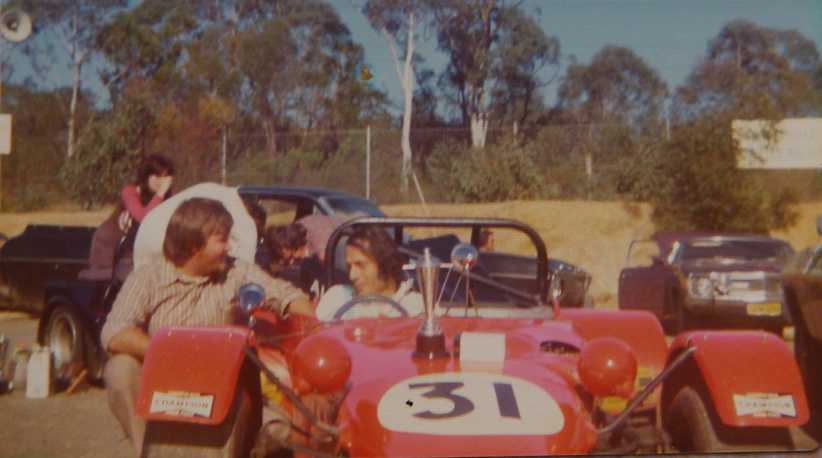
Joe with Vince. When I was talking to Joe before I left home I told him I would be visiting Vince. It surprised him that I knew Vince, and it surprised me even more that he did! The photo is from the pit area at Amaroo Park and the car behind Vince is the Seca.
…is a friend from Stanthorpe, Joe. He used to help Vince and Ron with preparation, but then left Sydney to go farming in Queensland. He still loves his cars but leads a quieter life than he did in his youth.
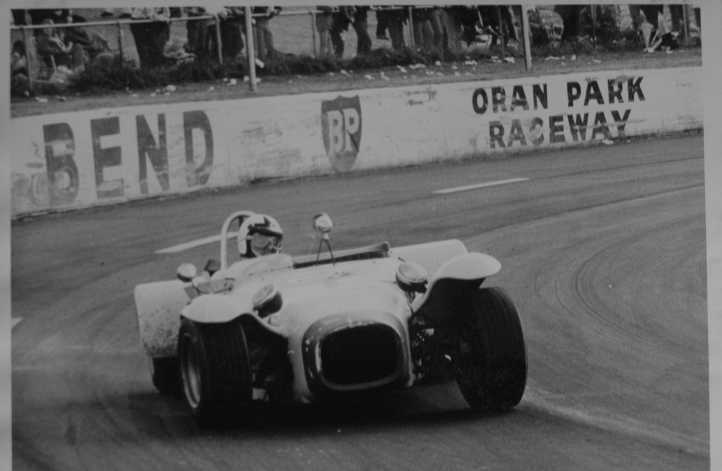
Understeer! Vince on the track at Oran Park in the Elfin. Understeer (or ‘push’ as Americans call it) is when the front wheels don’t have enough traction for the turn and the driver has to put on more lock to get around. Learning how to set up to avoid it is a key to getting good handling in these cars.
After lunch we went for a bit of a drive to see some local sights. This monument to seamen is in Siderno:
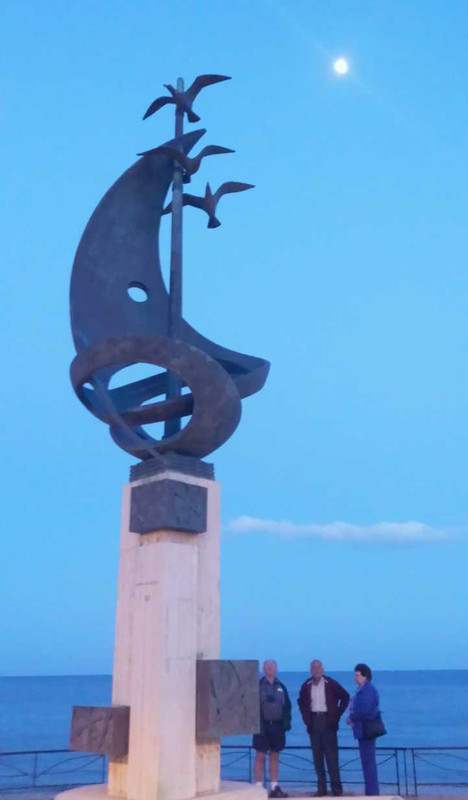
Monument to Seamen. Siderno, being one of many towns on the seacoast, has always had a connection with sailing on the Mediterranean and so with the seamen. Hence a monument. Sandra snapped this shot of Vince, Mary and myself near it.
But the main part of this ‘tour’ was to go to Gerace up on a nearby mountain:
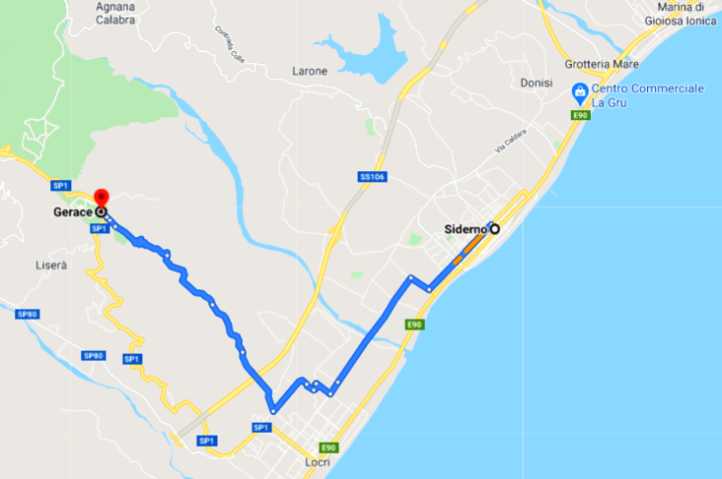
As can be seen from the map, there are a few ways to get there. Once we ascended the climb we got this pic of one of the other roads:

Roads to Gerace. Sandra is not good with twisty roads, but climbing mountains like this soon puts them on one’s radar. As can be seen, it was coming over very cloudy and threatening, it was also cool.
This explanation on a sign helped us to understand a bit about the histoy of the place:
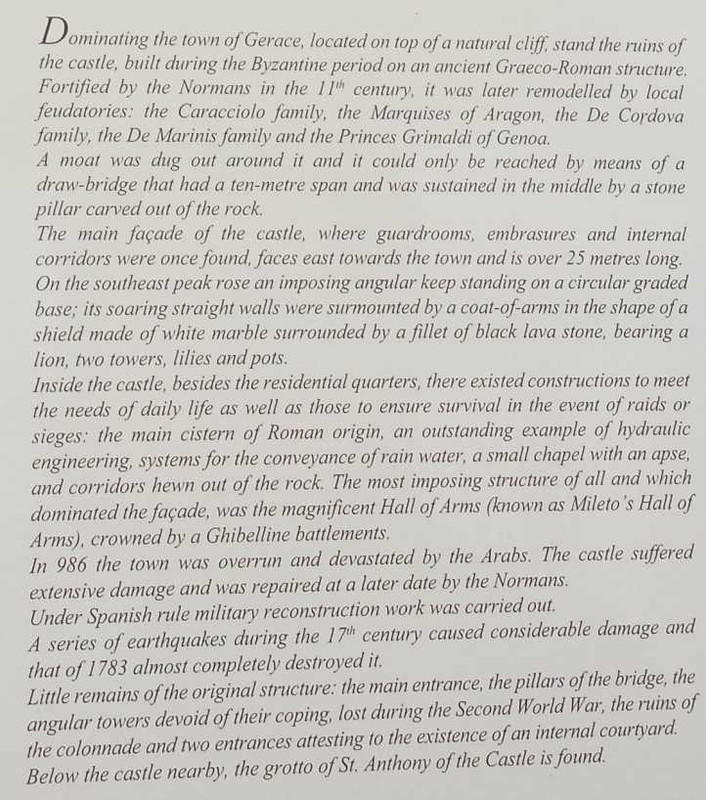
History of Gerace. Dating back to Byzantine times (up to 1,700 years ago) the ruins here have an interesting history.
For a while I was probably more interested in getting pics of the views available up there than the ruins and the town…
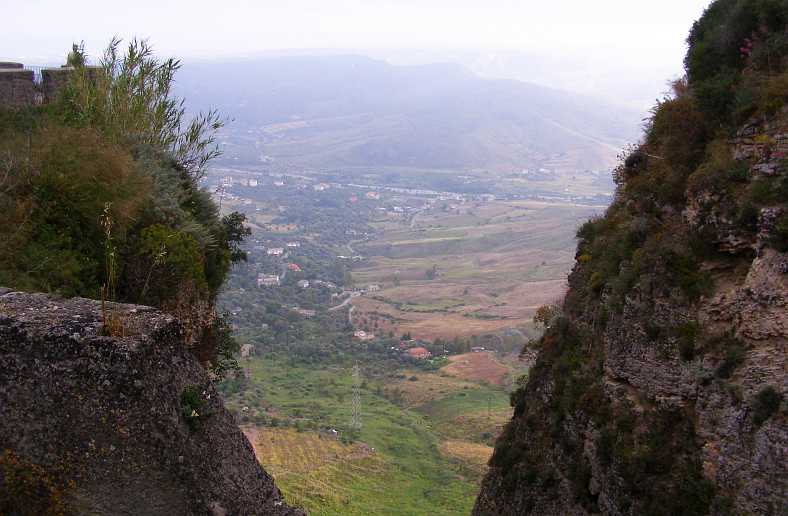
The valley below. All the elements of Southern Italy are there, little farms, houses everywhere, roads and power lines with a backdrop of mountains.
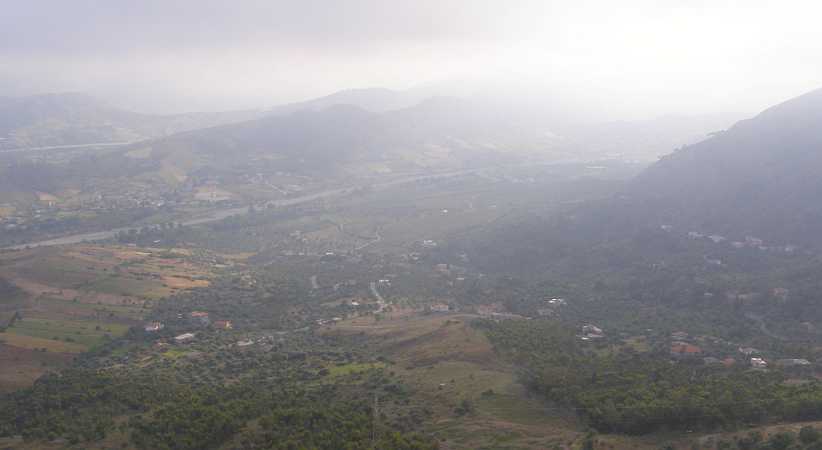
More valley. The conditions of the day spoil the photo, but it does show that a lot of people have lived around here and continue to do so.
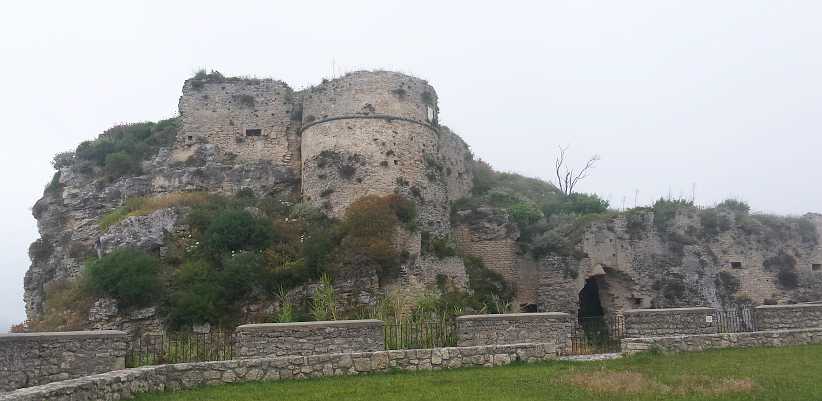
Gerace Ruins. This photo taken from a bit of a park shows how the work of a lot of people a long time ago has tried to return to nature. A victim of the years, the elements and the various changes of ‘ownership’ seen in over 1,500 years.
We walked around to see the sights of Gerace…
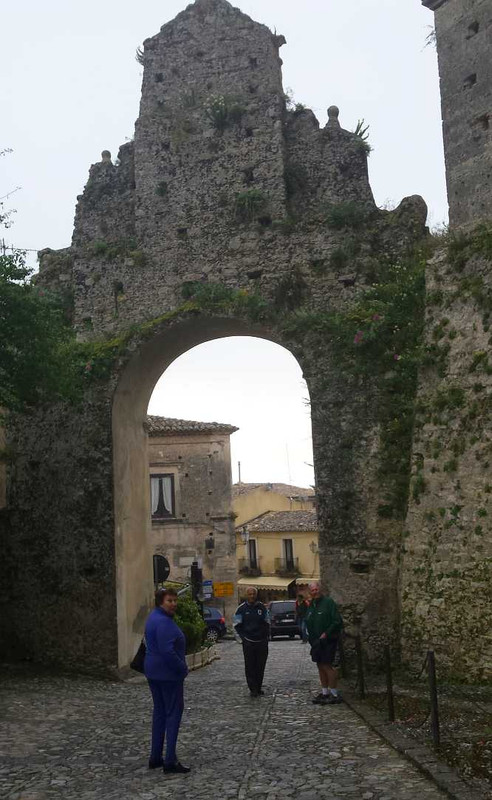
City gate. As a veritable fortress, it’s natural that city gates would abound.
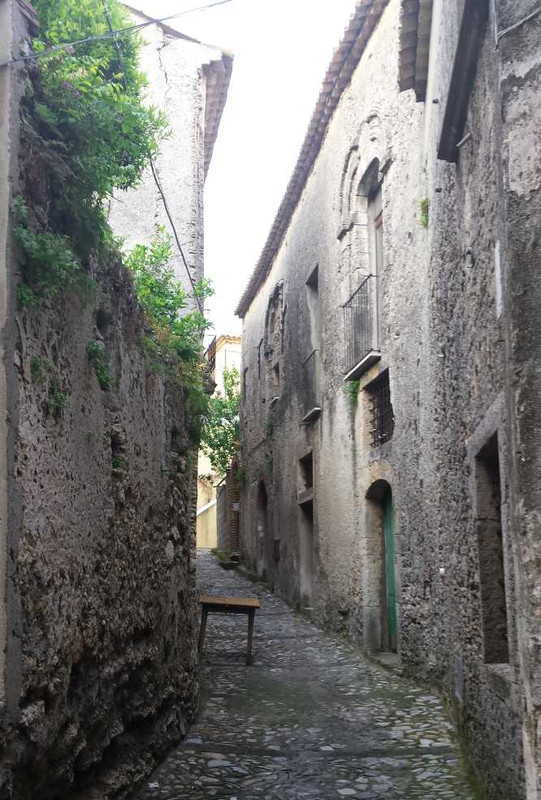
Laneway. Not all the ‘streets’ of the town are wide. So different to the world in which we live, but we were getting used to seeing that
…and learned more about their fortifications and the gates which used to protect them:
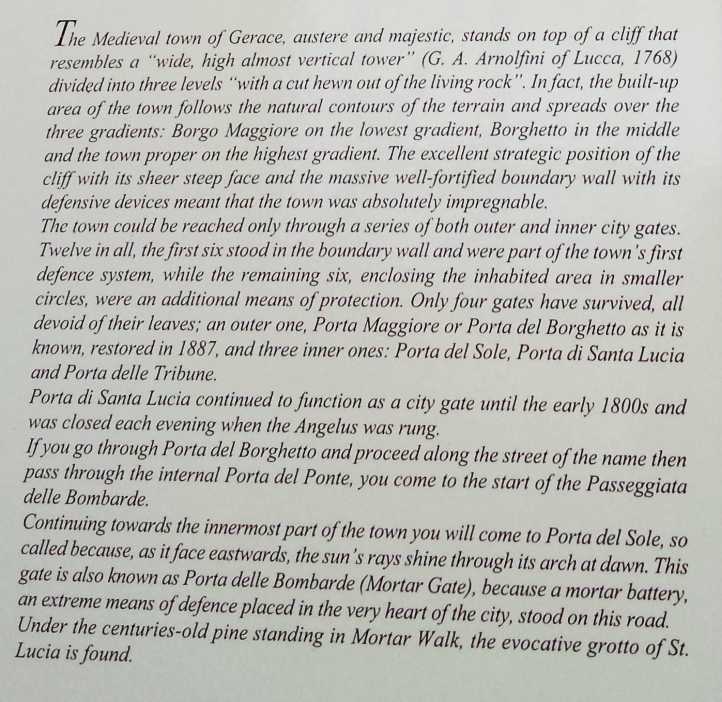
Learning more. Among the things explained here is the reason for the name of…

Porta del Sole. Facing the East, this gate got the first sun each day.
People do live here, one of the fascinating things about places like this. I noted this house and took a photo because of the rocks on the roof:
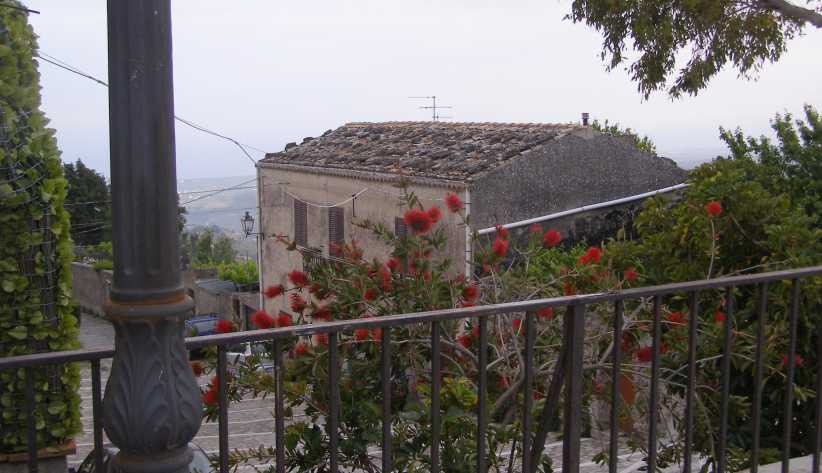
Rooftop rocks. I figured that high winds must have led to the addition of the rocks to keep the tiles in place here.
I also looked at this with interest…
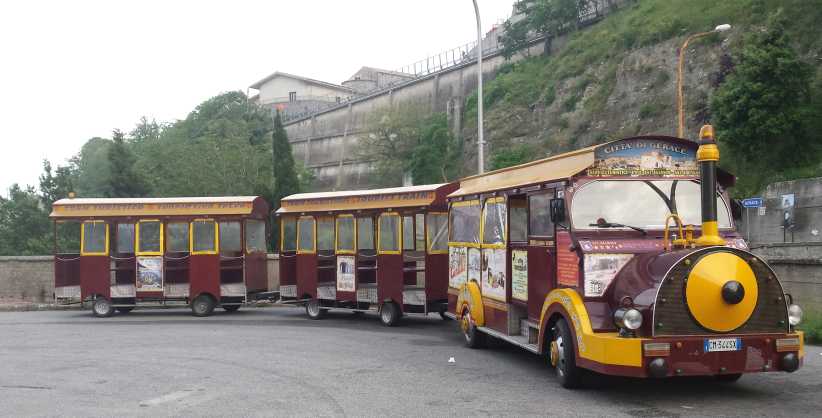
Tourist ‘train.’ I wonder what sort of truck was used to make this tourist train?
…because I’m always curious about what underpins this kind of thing. We didn’t see it run but it was worth getting a photo.
Back in Siderno we had a quiet evening. I was still making arrangements for Sandra to get back home and browsing the various forums I use on the internet. Overnight a Sirocco wind blew:
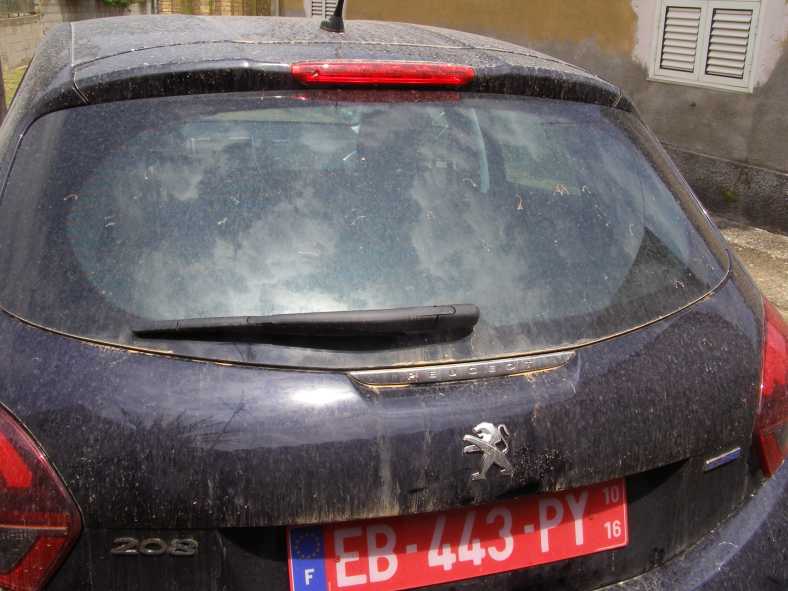
Sirocco dust. A bit of the Sahara Desert covered the 208 as a result of a wind called the Sirocco.
The Sirocco is a wind which blows across the Mediterranean from the Sahara Desert. With it comes dust which will cover everything when it’s bad. The Peugeot was covered with it and would need a wash, but the rest of the day was pretty quiet staying around Vince’s home.
Late in the afternoon we went for a drive down to the beachside area and had a walk around there. I was interested to see this construction going on:
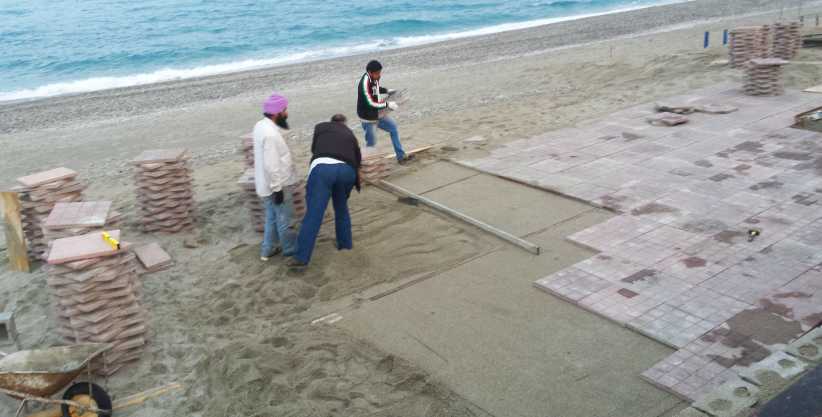
Beach construction. Putting down a floor on the beach, preparation for the onset of the summer crowds due soon. Everything here is so different to home.
Nobody would do that in Australia. If you were to go to that trouble you’d go a bit further and make it permanent, but on our beaches you wouldn’t be allowed to so it doesn’t happen.
We had now spent three days with Vince and Mary and we’d be departing in the morning. It was now Friday evening and Sandra was booked out to fly out of Rome on the following Wednesday, we were planning our trip up the East coast of Italy and then across to Rome as our honeymoon was coming to an end.
We had to make the most of the next few days...

Market day. Markets in Siderno, the market operators descend on the town and ply their wares from vans, trucks and stalls.
Vince was very familiar with this arrangement, it is very likely a weekly event for him to go there and see what’s on offer. He went this time with a shopping list, so he knew what to look for and where to get it.

All kinds. Starting with the cheeses at the front, this one sold all kinds of things.

From the sea. Fresh caught or tinned, seafood was naturally a part of the market array.
I was just an onlooker for this event as Vince had it all worked out. Now I wonder about how these people run these businesses, for setting up very early in the morning to market their goods is just a part of the operation. They have to buy the stuff somewhere, they have to maintain their vehicles, refrigeration equipment and display settings as well, and then travel from place to place to participate in the markets.

Well-equipped. While Vince was looking over the goodies here, I was pondering the way the rig was set up to store, cook, display and travel with all they have to offer. A very specialised construction here.
After returning to the Meleca home, Vince and I started looking through his photo albums of his racing days. I never knew before that he had first raced a Lotus 18…

Vince’s Lotus. This Lotus 18 was an early part of Vince’s motor racing, a Formula Junior car originally imported with the first three of these to come to Australia. Stirling Moss drove it to familiarise himself with Warwick Farm when his car wasn’t available for the first day of practice there, it was later bought and raced by Leo Geoghegan to begin his long association with Lotus open-wheelers. Vince had some fun in it as it was getting old.
…and then I learned he crashed it severely at Silverdale Hillclimb, the results of which are in these pics:

Lotus crashed. There wasn’t much room for error at Silverdale and it caught Vince out. The car was badly damaged.
While I was there I phoned Marc Schagen, who has done a book about Lotus cars raced in Australia so he could ask Vince about anything he might want to know about his time with the car. It was he who told me about the car’s history.
Vince’s next car was an Elfin Clubman. There wasn’t may of these built, fewer than a dozen I think, and Vince bought it in partnership with Ron Lane. They shared the drives. But the person talking to Vince in the car in this picture…

Joe with Vince. When I was talking to Joe before I left home I told him I would be visiting Vince. It surprised him that I knew Vince, and it surprised me even more that he did! The photo is from the pit area at Amaroo Park and the car behind Vince is the Seca.
…is a friend from Stanthorpe, Joe. He used to help Vince and Ron with preparation, but then left Sydney to go farming in Queensland. He still loves his cars but leads a quieter life than he did in his youth.

Understeer! Vince on the track at Oran Park in the Elfin. Understeer (or ‘push’ as Americans call it) is when the front wheels don’t have enough traction for the turn and the driver has to put on more lock to get around. Learning how to set up to avoid it is a key to getting good handling in these cars.
After lunch we went for a bit of a drive to see some local sights. This monument to seamen is in Siderno:

Monument to Seamen. Siderno, being one of many towns on the seacoast, has always had a connection with sailing on the Mediterranean and so with the seamen. Hence a monument. Sandra snapped this shot of Vince, Mary and myself near it.
But the main part of this ‘tour’ was to go to Gerace up on a nearby mountain:

As can be seen from the map, there are a few ways to get there. Once we ascended the climb we got this pic of one of the other roads:

Roads to Gerace. Sandra is not good with twisty roads, but climbing mountains like this soon puts them on one’s radar. As can be seen, it was coming over very cloudy and threatening, it was also cool.
This explanation on a sign helped us to understand a bit about the histoy of the place:

History of Gerace. Dating back to Byzantine times (up to 1,700 years ago) the ruins here have an interesting history.
For a while I was probably more interested in getting pics of the views available up there than the ruins and the town…

The valley below. All the elements of Southern Italy are there, little farms, houses everywhere, roads and power lines with a backdrop of mountains.

More valley. The conditions of the day spoil the photo, but it does show that a lot of people have lived around here and continue to do so.

Gerace Ruins. This photo taken from a bit of a park shows how the work of a lot of people a long time ago has tried to return to nature. A victim of the years, the elements and the various changes of ‘ownership’ seen in over 1,500 years.
We walked around to see the sights of Gerace…

City gate. As a veritable fortress, it’s natural that city gates would abound.

Laneway. Not all the ‘streets’ of the town are wide. So different to the world in which we live, but we were getting used to seeing that
…and learned more about their fortifications and the gates which used to protect them:

Learning more. Among the things explained here is the reason for the name of…

Porta del Sole. Facing the East, this gate got the first sun each day.
People do live here, one of the fascinating things about places like this. I noted this house and took a photo because of the rocks on the roof:

Rooftop rocks. I figured that high winds must have led to the addition of the rocks to keep the tiles in place here.
I also looked at this with interest…

Tourist ‘train.’ I wonder what sort of truck was used to make this tourist train?
…because I’m always curious about what underpins this kind of thing. We didn’t see it run but it was worth getting a photo.
Back in Siderno we had a quiet evening. I was still making arrangements for Sandra to get back home and browsing the various forums I use on the internet. Overnight a Sirocco wind blew:

Sirocco dust. A bit of the Sahara Desert covered the 208 as a result of a wind called the Sirocco.
The Sirocco is a wind which blows across the Mediterranean from the Sahara Desert. With it comes dust which will cover everything when it’s bad. The Peugeot was covered with it and would need a wash, but the rest of the day was pretty quiet staying around Vince’s home.
Late in the afternoon we went for a drive down to the beachside area and had a walk around there. I was interested to see this construction going on:

Beach construction. Putting down a floor on the beach, preparation for the onset of the summer crowds due soon. Everything here is so different to home.
Nobody would do that in Australia. If you were to go to that trouble you’d go a bit further and make it permanent, but on our beaches you wouldn’t be allowed to so it doesn’t happen.
We had now spent three days with Vince and Mary and we’d be departing in the morning. It was now Friday evening and Sandra was booked out to fly out of Rome on the following Wednesday, we were planning our trip up the East coast of Italy and then across to Rome as our honeymoon was coming to an end.
We had to make the most of the next few days...
Last edited by Ray Bell; 02-18-2020 at 02:15 AM.


